100 Unhealthiest Foods on the Planet
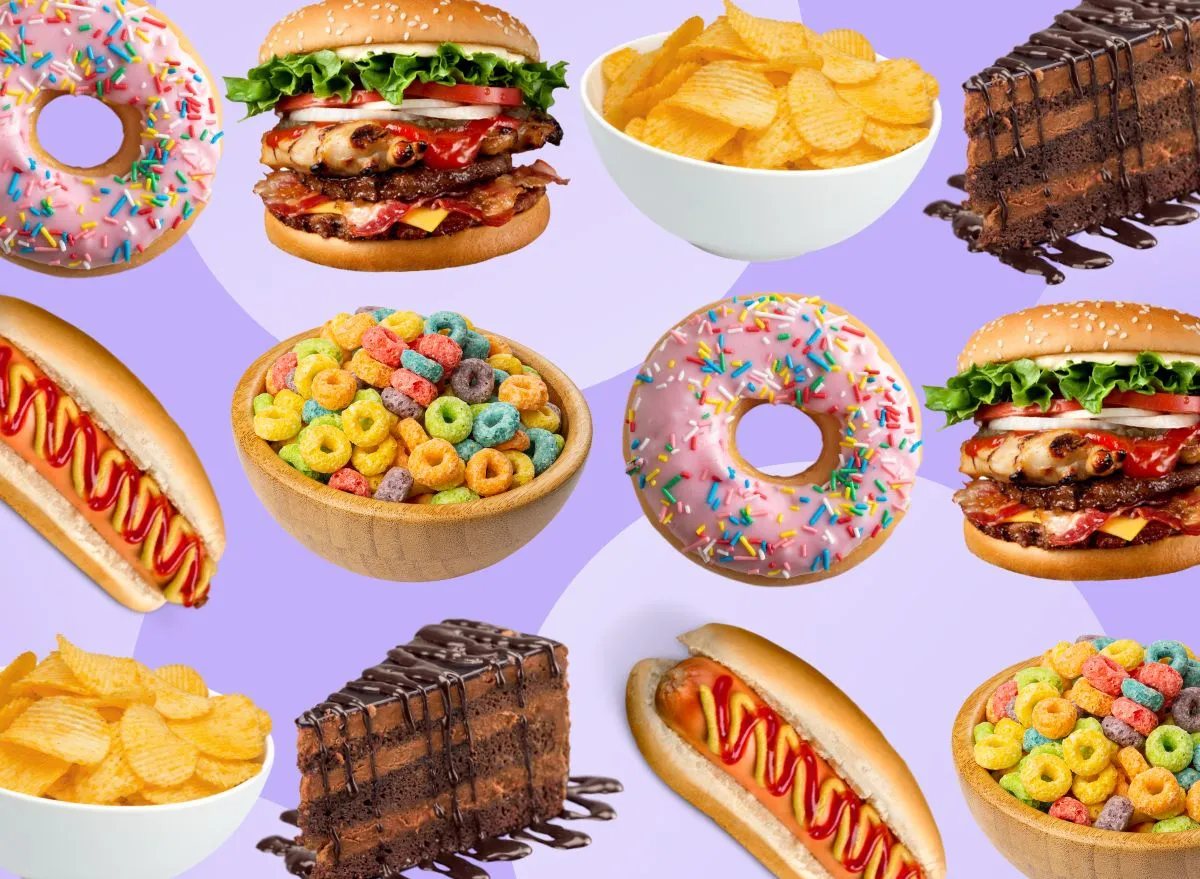
It's completely normal to crave sweet treats like cake, donuts, and ice cream or savory snacks like chips, pretzels, and salty french fries. And sometimes, it's perfectly fine to treat yourself and satisfy those cravings. But while enjoying these indulgences in moderation is okay, it's also important to recognize that many foods and drinks can negatively impact your health if they become staples in your diet.
Being aware of what's actually in the foods you eat can make a big difference—especially in the U.S., where many common foods are loaded with added sugars, sodium, saturated and trans fats, and hard-to-pronounce chemicals, yet often lack essential nutrients like fiber and protein.
To help you make more informed choices, we've compiled a list of the 100 unhealthiest foods and drinks on the planet, along with why they might be worth avoiding. Read on, and don't miss the 50 Unhealthiest Snacks on the Planet.
Potato Chips
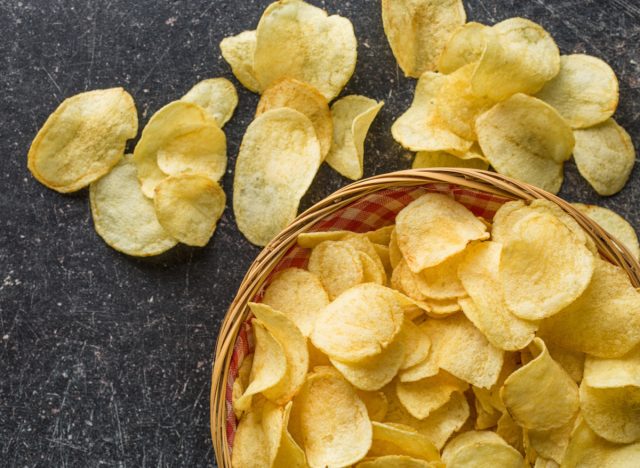
Unhealthy Ingredients: High amounts of sodium, artificial colors, very low levels of fiber.
Savory lovers know the temporary satisfaction of chowing down on their favorite bag of chips, but this ultra-processed food isn't a snack that will leave you feeling satiated. Most bags of potato chips have higher levels of sodium and little to no fiber, while some also contain artificial flavors and colors.
Take Ruffles Cheddar & Sour Cream Chips, for example. These addicting chips are made with Yellow 5 and Yellow 6—two common food dyes that are considered animal and human carcinogens.
Eat this instead: "WILDE Protein Chips are crispy chips—minus the potato," says Lauren Manaker, MS, RDN, registered dietitian and author of The First Time Mom's Pregnancy Cookbook and Fueling Male Fertility. "Made with real chicken breast, egg whites, and bone broth, these chips deliver 10 grams of protein per serving with no food dyes."
Ice Cream
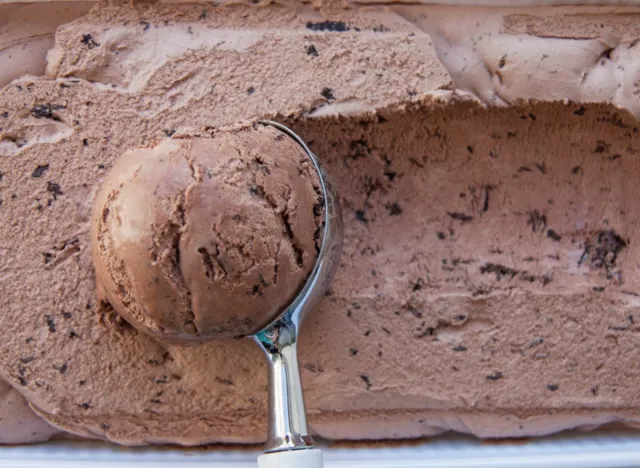
Unhealthy Ingredients: Too much added sugar.
When it's time to cozy up on the couch after dinner for your favorite show, a pint of ice cream may be your dessert of choice. While some pints may not be all that bad, most popular brands come loaded with more added sugar than the 25-36 gram limit that is recommended in an entire day.
For instance, a popular choice from Ben & Jerry's—Chubby Hubby—contains 27 grams of added sugar per 2/3-cup serving and a whopping 82 grams per pint. Knowing how easy it is to finish off a pint in one sitting, this ice cream can quickly give you three days' worth of added sugar.
Eat this instead: Fear not, ice cream lovers. Even though many popular pints on the market are full of sugar, plenty of brands are making healthier ice creams.
Processed Red Meat
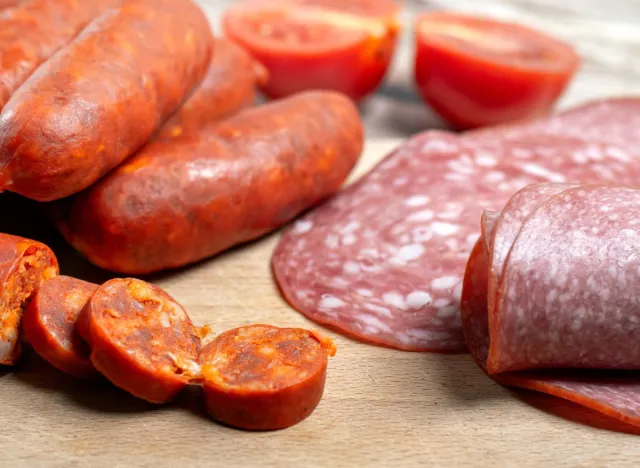
Unhealthy Ingredients: Sodium nitrite, sodium nitrate, and sodium phosphate.
Processed red meat is any type of red meat (think pork, beef, lamb) that has been cured or preserved in any way. This includes things like pepperoni, salami, bacon, sausage, roast beef, hot dogs, etc.).
Even though these products are made to taste delicious, research shows time and time again that there are risks involved with eating red meat that is processed. Processed red meat consumption has been linked to an increased risk of cardiovascular disease, type 2 diabetes, and certain cancers, and many of these risks have to do with the additives used to preserve these meats, such as sodium nitrite, sodium nitrate, and sodium phosphate.
Eat this instead: "Impossible Sausage is a meat-free sausage option that is free from all of the questionable ingredients mentioned above," says Manaker. "The flavor of this sausage is uncanny—making it a great option for processed meat lovers who want to minimize their intake."
Instant Ramen
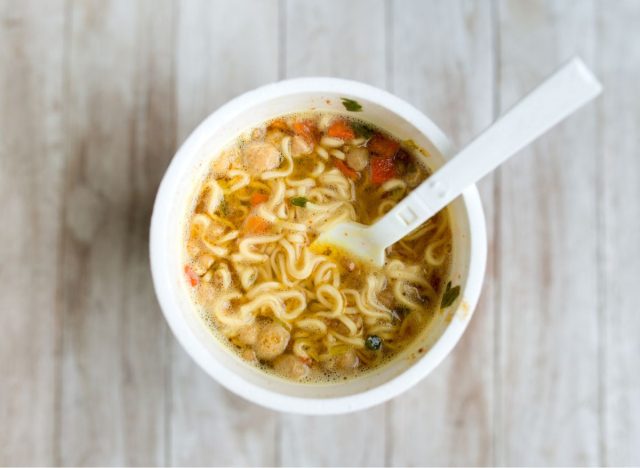
Unhealthy Ingredients: Extremely high levels of sodium
There's much to be adored about instant ramen. It's cheap, delicious, and comforting after a long night out or on a cold wintery night. But if you're a ramen lover, be careful of the brands you choose, as this food is often riddled with sodium—sometimes more than half of your daily recommended limit, like the 1,620 milligrams you'd get in a serving of Nissan Top Ramen.
Eat this instead: "Lotus Foods Organic Millet and Brown Rice Ramen allows you to have more control over the ingredients you add to your ramen," says Manaker. "The whole grain noodles are ready in minutes, and you can add them to any rich (or light) broth that suits your needs."
Store-Bought Cake
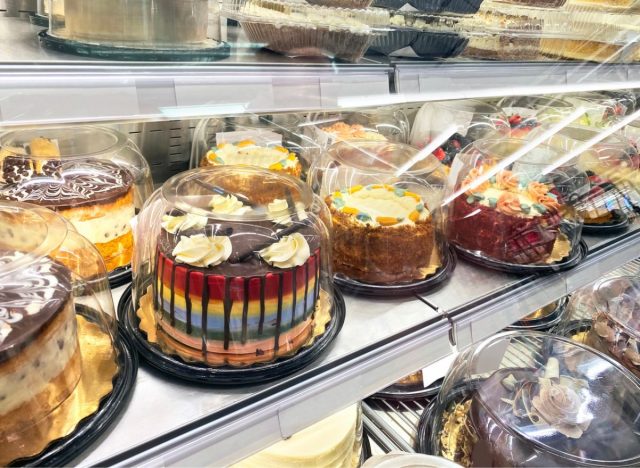
Unhealthy Ingredients: Large amounts of added sugar, artificial colorings, and preservatives.
Of course, it's much easier to buy a store-bought cake instead of making one from scratch, and we aren't recommending that you make one on your own every time if it isn't something you enjoy or have time for. Unfortunately, when you head to a store like Costco, Sam's Club, or your local grocery store for a full cake or just a slice, you don't have any control over all of the ingredients that go inside. And more often than not, these cakes are full of added sugars and artificial ingredients.
Let's take a look at David's Cookies Mile High Peanut Butter Cake, which you can find in the Costco Bakery. It's a no-brainer that this cake is going to taste good, but the ingredients list seems to include every additive you can dream up. From things like Red 40 (an artificial dye), corn syrup, palm oil, mono & diglycerides, the list goes on and on. And in terms of nutrition, in just one slice you'll get 820 calories, 19 grams of saturated fat, and 71 grams of added sugar.
Eat this instead: We always recommend making your desserts at home when you have the time. For some healthier (but still delicious) cakes, check out these recipes.
Crackers
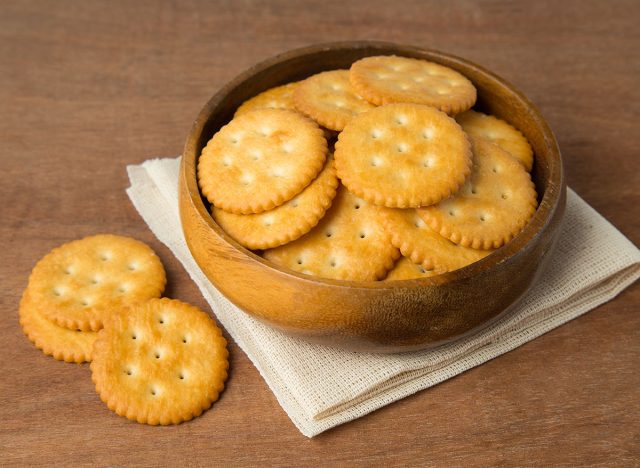
Unhealthy Ingredients: Refined flour with very little to no fiber, artificial colors, and preservatives in some brands
Depending on the type of cracker you buy, this snack can either be fiber-rich or one that is entirely void of nutrients. Even though some crackers are made with whole grains, many popular brands are made from refined flour and ultra-processed ingredients.
The RITZ Bits Cheese Cracker Sandwiches are marketed as containing "real cheese," but the ingredients list consists of cheddar cheese powder, leavening, palm oil, and sodium phosphate—which is an additive that has been linked to accelerated aging and vascular damage.
Eat this instead: For a healthier cracker alternative, Manaker suggests Maine Crisps. "Buckwheat is having a moment, thanks to the antioxidants and fiber this grain provides," she says. "These buckwheat-based crackers are also gluten-free, non-GMO, and sustainably sourced."
Tortilla Chips
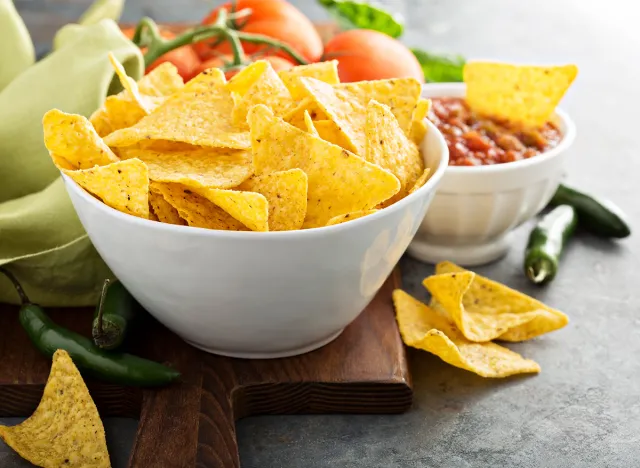
Unhealthy Ingredients: High levels of sodium, low levels of fiber, artificial colors.
Whether you're buying tortilla chips at the grocery store or enjoying a bowl of extra salty ones at your favorite Tex-Mex restaurant, this snack is better consumed in moderation when you can.
Most restaurant chips contain extremely high levels of sodium (which many of us may wash down with the 2-for-1 margarita deal), but store-bought varieties are often no better.
If you look at Doritos Flamin' Hot Cool Ranch Chips, you'll notice that not only are they high in sodium, but they contain nearly every artificial dye you can think of, Red 40, Red 40 Lake, Yellow 5, Yellow 6, and Blue 1.
Eat this instead: "HIPPEAS Nacho Vibe Chickpea Tortilla Chips are free from artificial ingredients and they contain plant-based protein and fiber, thanks to the chickpea addition," says Manaker.
Pretzels
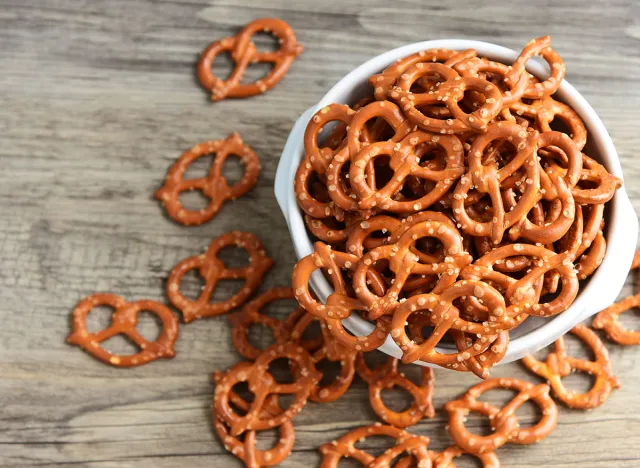
Unhealthy Ingredients: Refined flours, high amounts of sodium, and a lack of fiber and protein.
Pretzels have the opportunity to be a healthy snack, with plenty of brands making nutrient-rich options for their customers. However, there are just as many brands out there that make pretzels that contain white refined flour and are high in sodium.
A serving of Extra Salt Splits from Unique Snacks, for example, contains almost 1,000 milligrams of sodium! According to the CDC, consistently consuming too much sodium throughout the day can increase your risk of high blood pressure and heart disease.
Eat this instead: You can easily find healthier pretzel brands at the store that are made with better ingredients and contain less sodium. We love brands like From The Ground Up and Fit Joy.
Bread Bowls
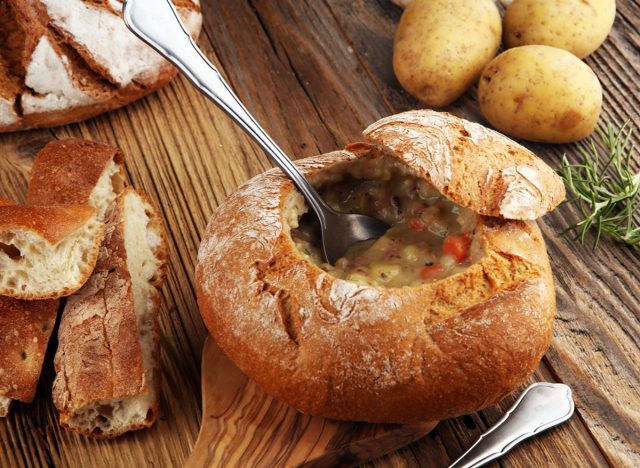
Unhealthy Ingredients: Extremely high levels of refined carbohydrates with little to no fiber.
Panera made the bread bowl famous, but now you can find this dish at plenty of restaurants around the country. Made with a loaf of bread, this fully edible "bowl" contains your soup of choice to create the most comforting dish you can think of. There's one big problem here, and that's the fact that this dish is extremely high in carbohydrates and contains very little fiber to help prevent blood sugar spikes. If you were to go to Panera and order their Homestyle Chicken Noodle Soup Bread Bowl, for instance, you're looking at almost 150 grams of carbohydrates and only 4 grams of fiber. Over time, consistently experiencing blood sugar spikes can increase your risk of type 2 diabetes and heart disease.
Eat this instead: "Try ordering your soup in a traditional bowl instead!" says Manaker. And if you're at Panera and order a regular bowl of soup, you can still get a piece of bread as your side to satisfy those carb cravings.
Packaged Cookies
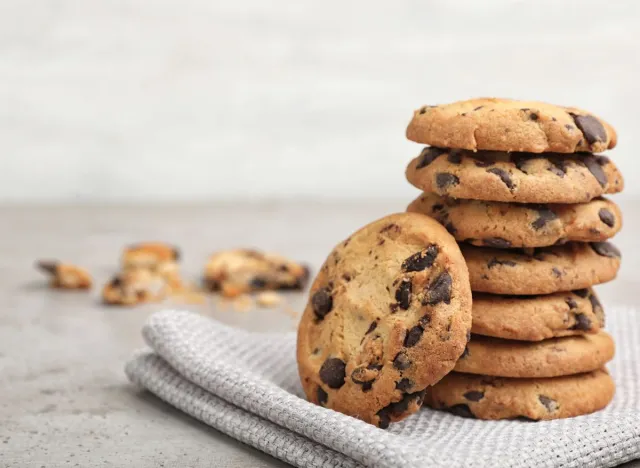
Unhealthy Ingredients: Added sugars, artificial flavors, artificial colors.
When you're craving cookies, you're better off making some from scratch. Yes, it takes more effort, but if you have the time, you'll be able to avoid the artificial flavors and colors hiding in your favorite store-bought cookies—such as Oreos, Mrs. Fields, and Famous Amos Cookies.
Eat this instead: "Siete Grain Free Cookies are made from quality ingredients (like chickpea flour) and are free from anything artificial," says Manaker. "Plus, they are absolutely delish."
Store-Bought Cookie Dough
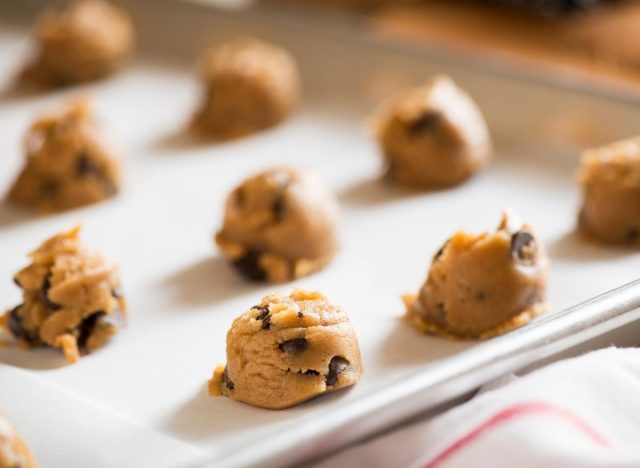
Unhealthy Ingredients: Added sugars, artificial flavors, artificial colors.
Similar to store-bought packaged cookies, store-bought cookie doughs are also usually riddled with artificial ingredients and an excess of added sugars. Products like Pillsbury Reese's Peanut Butter Cookie Dough and Toll House M&M Chocolate Chip Cookie Dough contain additives like dextrin, monoglycerides, and dyes like Red 40, Red 40 Lake, Blue 1, Yellow 5, and Yellow 6.
Eat this instead: For a better-for-you cookie dough, Manaker suggests Sweet Loren's. "This gluten-free and vegan-friendly dough is made with quality ingredients. Best of all? You can bake only the amount of cookies you want to enjoy, helping you control your portions," says Manaker. "Deux Vegan Chocolate Chip Cookie Dough is made with quality ingredients as well, plus the addition of vitamin D and reishi to support mood."
Fast-Food Chicken Sandwiches
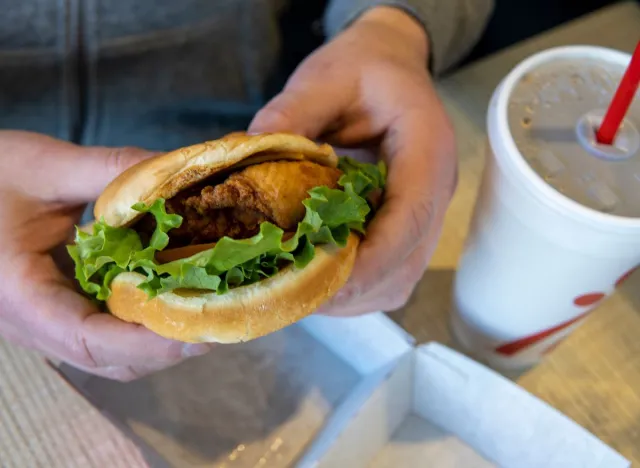
Unhealthy Ingredients: High amounts of fat, sodium, and artificial ingredients
Fast food is alright every once in a while, but research has shown that continuous consumption of fast food can lead to heart disease, cancers, and even premature death. Some research even suggests it can be just as bad for you as smoking.
This goes for all types of fast food, including those beloved fried chicken sandwiches. Not only are these sandwiches full of ultra-processed ingredients, but their levels of total fat and sodium can be dangerously high.
Eat this instead: Sometimes you just need to satisfy a craving, so if you must have a fast-food chicken sandwich, we suggest one of these healthier, dietitian-recommended options.
Fast-Food Smoothies
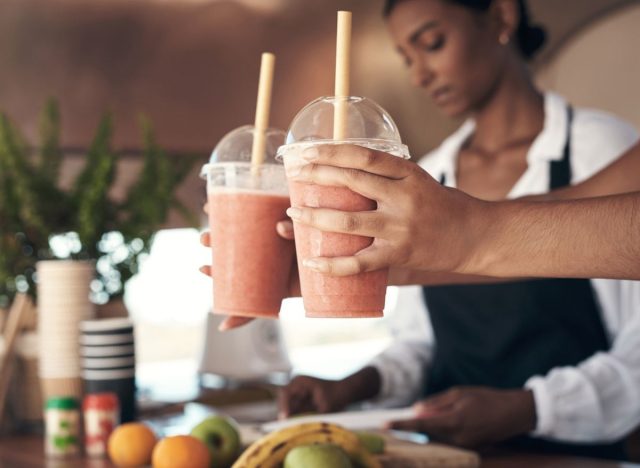
Unhealthy Ingredients: Added sugars, very little fiber.
Heading to smoothie chains like Planet Smoothie, Smoothie King, or Jamba Juice may feel like a healthy choice for your body, but unfortunately, these smoothie chains often pack their smoothies full of added sugar with very little protein or fiber to keep you full.
For instance, if you were to head to Jamba Juice and get a medium size of their Peanut Butter Mood Smoothie, you'd be getting 120 grams of carbohydrates and a whopping 102 grams of sugar with only 5 grams of fiber. You could also order one of Smoothie King's meal replacement smoothies, like The Hulk Strawberry, which may have 7 grams of fiber and 25 grams of protein, but it also serves up 91 grams of added sugar!
Eat this instead: When you can, make your smoothies at home! You can use veggies, fruit, protein powder, nut butter, and your favorite milk for a fiber-rich, protein-heavy smoothie. If you want some inspiration, try one of these 25 Weight Loss Smoothies.
Fast-Food Desserts

Unhealthy Ingredients: High levels of added sugar and saturated fat.
There are a ton of different fast-food desserts available, depending on which chain you choose. McDonald's has their famous Apple Pie or McFlurry, Burger King has their shakes and Sundae Pie, and Taco Bell has their super soft and warm Cinnabon Delights.
Of course, these treats always taste delicious, but they're almost loaded with excess added sugars, sodium, or saturated fat—and sometimes all three. And when you add this to your already calorie-laden fast-food entree, you may well surpass your recommended daily limits.
Eat this instead: If you're going to go for dessert at your favorite fast-food chain, there are ways you can indulge while not going fully overboard. For instance, you can order a Wendy's Frosty in a junior size, which has fewer calories and added sugars. Or if you're at McDonald's, you can go for their Vanilla Soft Serve Cone, a much lighter choice compared to their other desserts.
Fast-Food Breakfasts
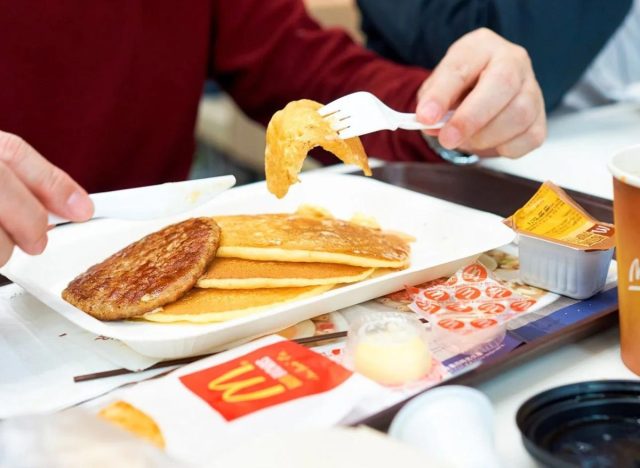
Unhealthy Ingredients: High amounts of sodium, saturated fat, and calories
Pulling into the drive-thru for breakfast is a convenient way to eat a meal on your busiest days, but it's not always the best way to start your morning when you're focusing on your health. For starters, fast-food breakfast is usually high in calories, sodium, and saturated fat. On top of that, these meals are more often on the lower end of fiber and protein, which means they may not fill you up as much and may contribute to you feeling hungry shortly afterward.
Take the Sausage, Egg & Swiss Croissant from Wendy's, for example. It has 16 grams of saturated fat and over 1,000 milligrams of sodium but contains zero grams of fiber to help balance out your meal.
Eat this instead: Making breakfast at home is almost always going to be your best bet when it comes to making a nutritious breakfast, but we know this sometimes isn't an option. For days when you're in a rush and need to resort to fast food, try looking for lighter options like a McDonald's Egg McMuffin, a Chick-fil-A Egg White Grill, or Starbucks Egg Bites.
You can also enjoy frozen breakfast sandwiches that are made with quality ingredients, like Red's All Natural Frozen Breakfast Sandwiches," says Manaker. "The Red's Turkey Sausage Egg'Wich is made with two fluffy cage-free eggs instead of bread, real cheese, and an antibiotic-free sage flavored sausage patty—all for under 200 calories per serving."
Fast-Food Burgers
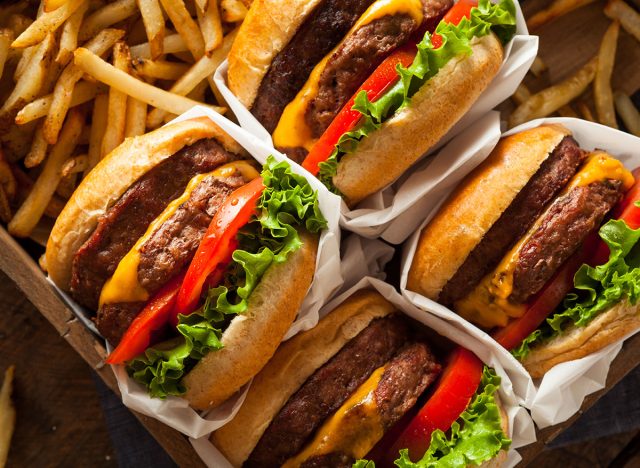
Unhealthy Ingredients: Too much sodium, saturated fat, and trans fat.
Fast food is convenient and delicious, but it's considered one of the unhealthiest types of food you can eat and has been consistently linked to health issues like heart disease, diabetes, and obesity. Fast-food hamburgers and cheeseburgers are some of the worst culprits because of their extremely high fat and saturated fat counts.
Eat this instead: If you are in a rush or just want to treat yourself to some fast food, we recommend trying one of these low-sodium fast-food orders or one of these fast-food meals under 500 calories.
Fast-Food French fries
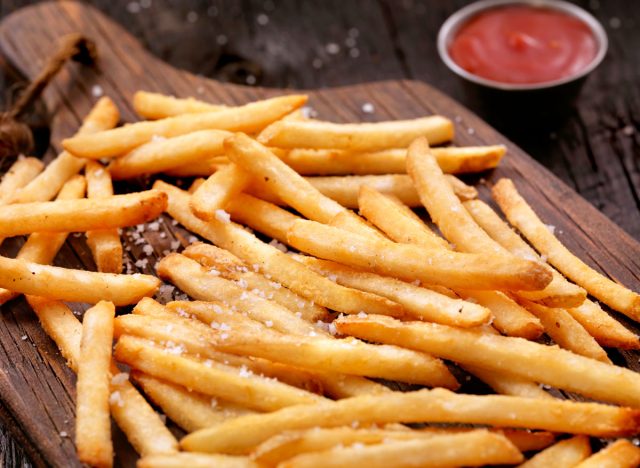
Unhealthy Ingredients: High amounts of sodium, fat, and empty calories
It's only natural that you'd want to order a side of fries with your fast-food meal, but adding this side item to your order is going to pile on the sodium, fat, and empty calories. Not only that, but fries usually contain lower amounts of protein, which means they won't fill you up.
For example, Arby's famous curly fries have over 1,250 milligrams of sodium and only 6 grams of protein, and Popeye's fries have 590 milligrams of sodium and only 5 grams of protein.
Eat this instead: For a fast-food French fry that has a bit less sodium, you can try the fries from Chick-fil-A, which have only 240 milligrams per serving. Or, if you're at home and craving some savory fries, try a healthier frozen option.
Soda
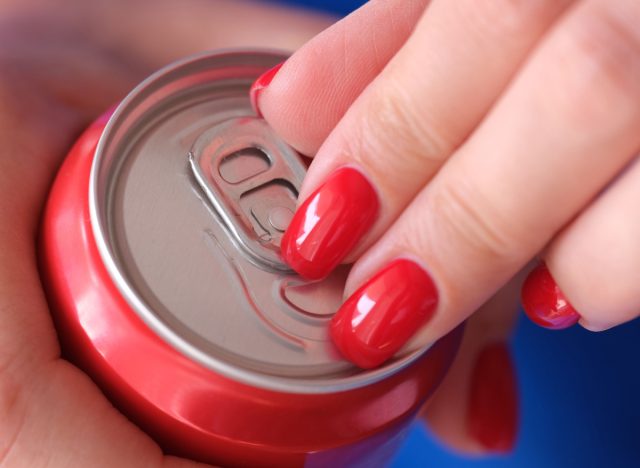
Unhealthy Ingredients: Added sugar and artificial colors.
There's no way around it: regularly consuming soda can lead to a handful of health risks. These sugar-loaded drinks have been linked to an increased risk of heart disease, diabetes, and certain cancers.
Unfortunately, sugar isn't even the only culprit in the health risks associated with sodas. Many sodas—like Crush, Mello Yello, and Mountain Dew—also contain artificial dyes such as Red 40, Blue 1, and Yellow 5. Many of these dyes have been labeled as carcinogens (chemicals that may be capable of causing cancer) and have been linked to potential behavioral changes in children.
Drink this instead: "Raspberry Lychee from Wildwonder is an effervescent drink that contains both pre and probiotics to support gut health, a sweet taste thanks to the addition of raspberry puree, and no artificial ingredients," says Manaker. "Plus, each can contains only 40 calories and 6 grams of sugar—a far cry from the 30+ grams found in regular sodas. And of course, it is free from artificial colors, too."
White Chocolate
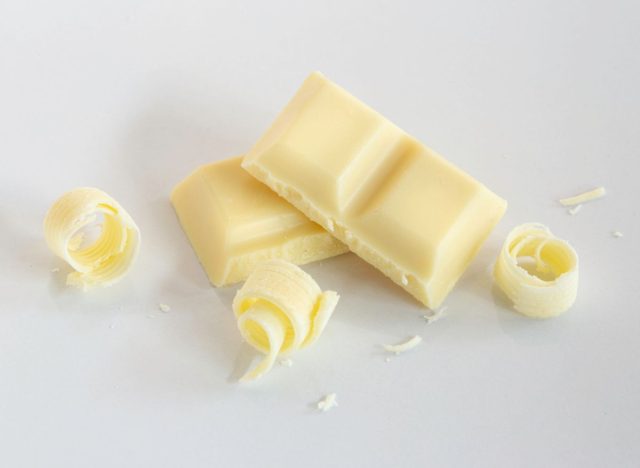
Unhealthy Ingredients: Added sugar.
There are some benefits to eating dark chocolate and products rich in cacao because cacao is rich in antioxidants and has been linked to reduced inflammation and even the reduction of cardiovascular risk. However, a mistake that many people often make (understandably so) is thinking that white chocolate is still mostly made of chocolate.
White chocolate lovers may be disappointed to learn that this type of chocolate is made mostly of just sugar, cocoa butter, and milk. For instance, the first ingredient in Lindt White Chocolate is sugar, followed by cocoa butter, which explains its 17 grams of sugar in just a few pieces.
A nostalgic choice for white chocolate lovers—the Hershey's Cookies N' Creme Bar—is another great example, as its first few ingredients are sugar, vegetable oil, skim milk, and corn solids, and contains less than 2% cocoa.
Eat this instead: "Try EVOLVED, a chocolate brand made with wholesome ingredients and ethical sourcing," says Manaker. "Their dark chocolate boasts antioxidants and plant compounds that support our health. The signature dark is 72% cacao and it is USDA certified organic."
Corn Dogs

Unhealthy Ingredients: Saturated fat, sodium, preservatives.
We get it, there's something comforting and nostalgic about corn dogs in the summertime. If this is a beloved food of yours, it may be helpful to keep it as a special occasion treat that you enjoy in moderation or find some healthier, more natural brands at the grocery store.
Most corn dog brands, like Foster Farms, for example, contain a ton of preservatives. When you have a food that is made of hot dogs covered in batter, it's hard not to use preservatives, after all. These particular corn dogs are made with both sodium phosphate and sodium nitrite—two potentially harmful additives often found in processed meat like hot dogs, bacon, and sausage.
Eat this instead: It's tough to find healthier corn dog brands, so if you're truly craving this savory snack, we just suggest you enjoy it in moderation. Or, if you're feeling adventurous, you can also grab one of these healthier hot dogs and try making your own!
Delivery Pizza
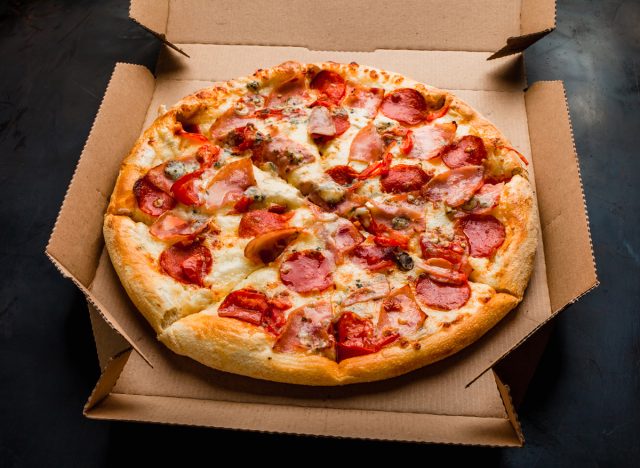
Unhealthy Ingredients: High levels of saturated fat, sodium, and a lack of fiber.
Pizza Hut, Domino's, Papa Johns: all of these pizza chains come with the same issues in their pies. Even though delivery pizza is convenient (and let's face it, delicious), it's almost always going to be higher in saturated fat, sodium, and calories than what you'd make at home and what you can find if you look carefully at the grocery store for healthier options. (See: 10 Unhealthiest Pizza Slices With More Fat Than an Entire Pack of Bacon.)
Let's look at Pizza Hut's selections. Even if you go a simpler route and stick to their regular Pepperoni Pizza, each slice will still bring in almost 600 milligrams of sodium and 6 grams of saturated fat. If you go for a fancier option like their Stuffed Crust Meat Lover's Pizza, you're looking at 420 calories, 940 milligrams of sodium, and 10 grams of saturated fat per slice.
Eat this instead: We would never dare tell you to avoid pizza forever. So if you find yourself with a hankering for some delivery, we suggest trying one of these "healthier" fast-food pizza pies.
Microwave Popcorn
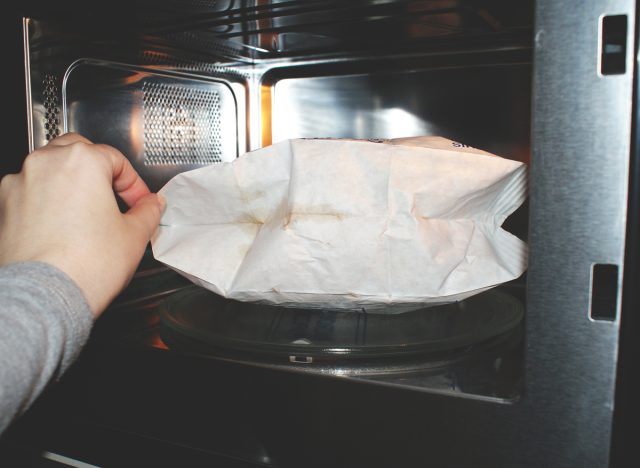
Unhealthy Ingredients: Large amounts of sodium, and palm oil.
Popcorn has the potential to be the perfect healthy snack. Some healthier bagged popcorn brands contain fiber and very few calories, and some brands are even making healthier microwave options as well.
But you still have to be careful when choosing a microwave popcorn to take home, as many popular brands—such as Act II Movie Theater Butter—are full of sodium and palm oil—a type of oil high in saturated fats and one that has been linked to increased risks of heart disease.
Act II also makes a microwave popcorn called Hot & Spicy, which along with palm oil also contains the artificial dye Red 40, which has been linked to possible behavioral changes and hyperactivity in children and adolescents.
Eat this instead: "For a convenient popcorn nosh, skip the microwaving altogether and grab a bag of pre-popped Lesser Evil Himalayan Pink Salt Organic Popcorn," says Manaker. "Made with three ingredients—organic popcorn, extra-virgin coconut oil, and Himalayan Pink Salt, this popcorn is free from any of the potentially harmful chemicals found in many microwavable popcorn options. And best of all? No popping required!"
Breakfast Sausage
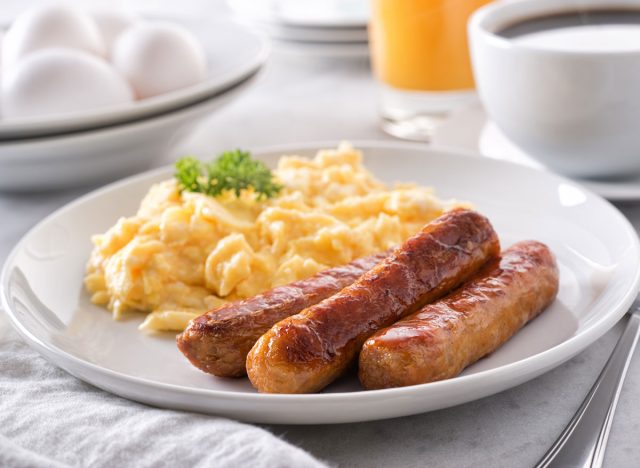
Unhealthy Ingredients: Sodium, saturated fat, sodium phosphates.
Starting your day with a breakfast sausage can certainly amp up your protein, but many brands contain large amounts of sodium and saturated fat, and some contain additives that have been linked to potential health risks.
A great example of this is the original Jimmy Dean Maple Pork Sausage Links. In each 3-link serving, you're looking at 9 grams of saturated fat and almost 500 milligrams of sodium. Plus, these pork links contain sodium phosphates—a preservative that has been linked to a potential increase in heart disease.
Eat this instead: "Applegate Naturals Chicken and Maple Breakfast Sausage is a better-for-you choice when it comes to breakfast sausage," says Manaker. "Free from synthetic nitrates and nitrites and made with humanely raised chicken, this sausage is packed with flavor without questionable ingredients. And with 9 grams of protein per serving, it certainly provides some serious staying power."
Bottled Ketchup
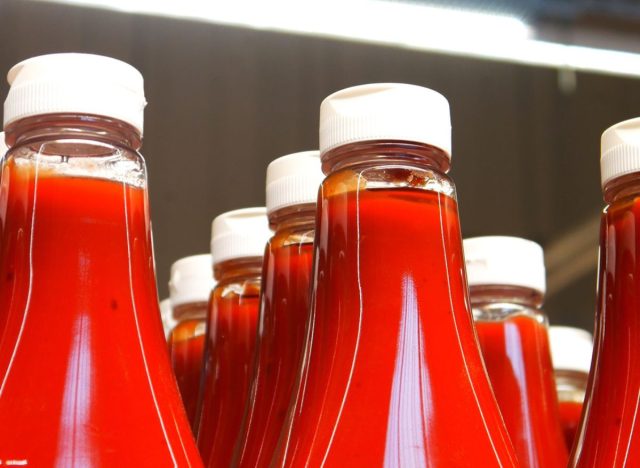
Unhealthy Ingredients: Added sugars and sodium.
At its foundation, ketchup is made of ingredients like tomatoes or tomato concentrate, garlic, vinegar, and salt. Unfortunately, many store-bought ketchups use added sugars and higher levels of sodium to make their products taste better. Even one of the original ketchup—Heinz Tomato Ketchup—comes with 4 grams of added sugar and 180 milligrams of sodium. That may not sound like a lot at first, but with a small serving size of one tablespoon, these numbers can add up quickly.
Eat this instead: "Ketchup may be known as a condiment packed with added sugars, but Primal Kitchen Ketchup is free from any added sugars, and it is made with quality ingredients like organic balsamic vinegar and organic garlic powder," says Manaker.
Alcohol

Unhealthy Ingredients: Toxins that, in excess amounts, can be harmful to your health.
For most people, alcohol in moderation is perfectly fine. Some studies even support drinks like red wine as heart-healthy because of their high antioxidant levels.
On the other hand, excessive alcohol consumption has a proven link to a multitude of health risks, like an increased risk of inflammation, liver disease, and in some cases, cancer.
According to the CDC, excessive drinking is 4 or more drinks per occasion for women, and 5 or more for men, or 8 or more drinks per week for women and 15 or more for men.
Drink this instead: "Mingle Mocktails are ready-to-drink mocktails that satisfy a desire to sip on something fun for cocktail hour, sans booze," says Manaker. "The Sparkling Raspberry Rosé is a perfectly bubbly mocktail that sips just as nicely as an alcohol-filled wine."
Cocktail Mixes
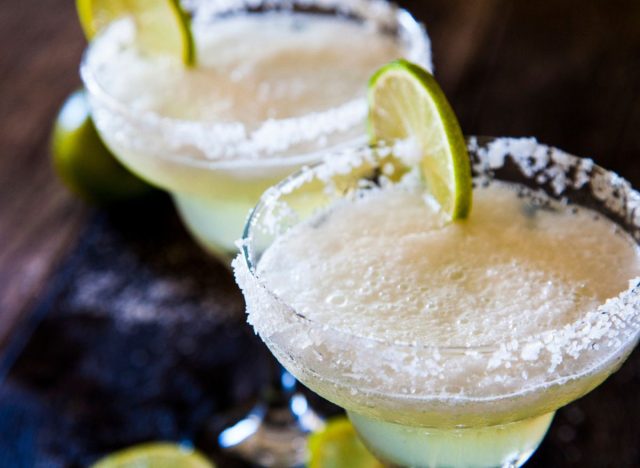
Unhealthy Ingredients: High amounts of added sugar.
Summer is around the corner, which means margaritas, daiquiris, and piña coladas will be flowing. But when you head to the store to pick out your mix, check the label for the amount of added sugars—you may be shocked at what some of your favorites contain.
One of the most popular margarita mixes—Jose Cuervo Classic Margarita Mix—comes with 24 grams of added sugar in each serving. Surprisingly, it can get much worse, with products like Master of Mixes Strawberry Daiquiri/Margarita Mix, which has a shocking 46 grams of added sugar per serving.
Drink this instead: "Combine lime, orange juice, and agave with your tequila for a DIY margarita that is far lower in added sugars than the pre-made mixes," suggests Manaker.
Bacon
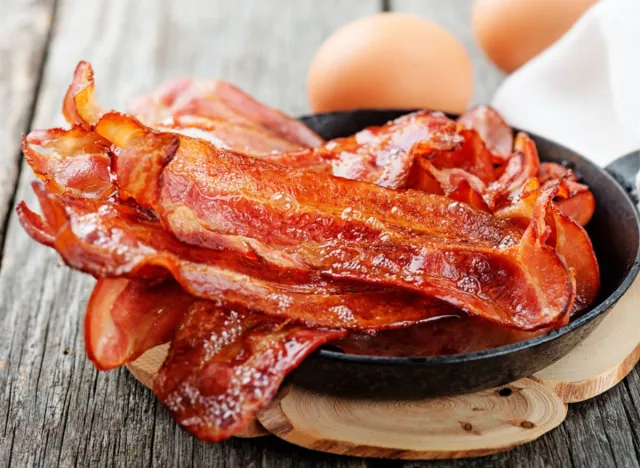
Unhealthy Ingredients: Sodium nitrite, sodium nitrate, and sodium phosphate
Waking up to the enticing smell of bacon is enough to get most people out of bed in the morning. However, if you're a regular bacon eater, you may want to be aware of some of the unhealthy ingredients lurking inside. Bacon is a processed and preserved meat, and it is often preserved with artificial ingredients like sodium nitrite and nitrates, as well as sodium phosphate. Unfortunately, these preservatives have been linked to various health issues like accelerated aging, vascular damage, and breast and prostate cancer. Not only that but high consumption of red processed meat (like bacon) has been linked to a greater risk of disease.
Eat this instead: Thankfully, there are a handful of bacon brands that come without these preservatives. A safe way to find healthier bacon is to look for the term "uncured," which means it hasn't undergone a preservation process using synthetic nitrates or nitrites. We love options like Pederson's Farms No Sugar Added Uncured Bacon or Nature's Rancher Uncured Applewood Smoked Bacon.
Opting for turkey bacon can also help you keep your saturated fat at a minimum, but it's still important to look out for artificial preservatives in this type of bacon as well.
Sugar-Loaded Granola
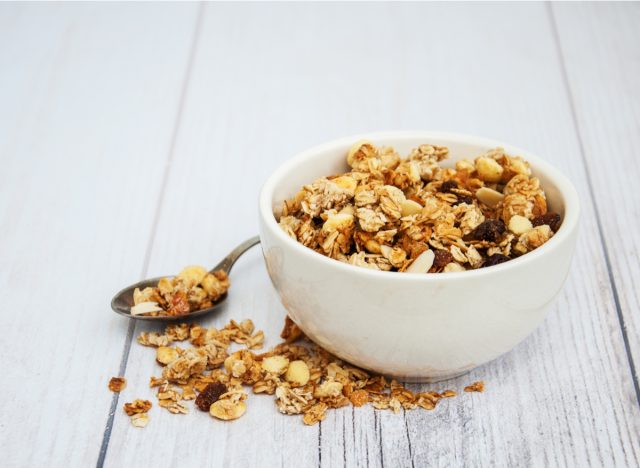
Unhealthy Ingredients: Added sugar
Granola is marketed as being a healthy breakfast food or snack, but many popular granola products are full of more added sugars than anything else. For instance, Nature Valley Oats & Dark Chocolate Protein Granola may have 13 grams of protein per serving, but it also serves up 17 grams of added sugar, an amount that gets you close to your recommended daily limit. Quaker Simply Granola is another example, with 10 grams of added sugar and only 7 grams of protein per serving.
Eat this instead: You can find healthier granolas on the grocery store shelf if you know what to look for! Varieties like Go Raw Organic Raisin Crunch Sprouted Granola have zero added sugars, or check out 13 Healthiest Granola Brands, According to Dietitians.
Milkshakes
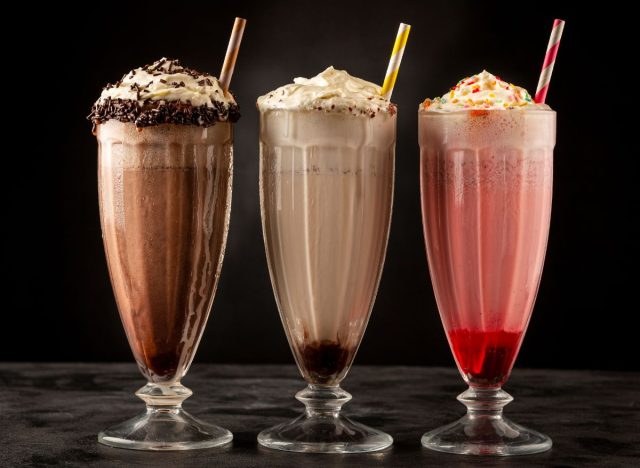
Unhealthy Ingredients: High levels of added sugar and saturated fat
They're satisfyingly sweet and make for the perfect dessert on a hot day, but there is sadly nothing nutritious about a milkshake. They're more often than not loaded with large amounts of added sugar, which can contribute to an increased risk of diabetes and heart disease, as well as saturated fat, which can lead to increased cholesterol and heart problems.
Sipping on a chocolate shake from Arby's will give you 20 grams of saturated fat and a whopping 140 grams of added sugar, while a shake from White Castle will deal out 19 grams of saturated fat and an enormous 179 grams of added sugar.
Eat this instead: If you're craving a frozen sweet treat, skip the milkshake and opt for a scoop or two of vanilla ice cream. You'll still get the sugar and cold texture that you want but with less sugar and saturated fat.
Donuts
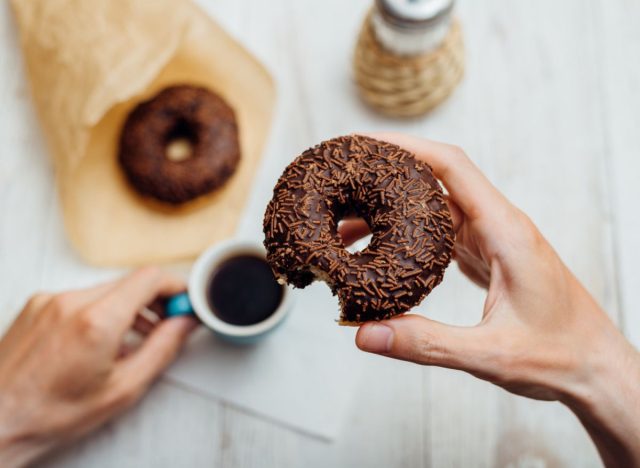
Unhealthy Ingredients: Too much added sugar
The best way to start your day is with a balanced breakfast containing protein, fiber, and other helpful nutrients, which can help keep you energized and satisfied until lunchtime. On the flip side, if you start your morning with a breakfast lacking in fiber and protein, you may find yourself feeling lethargic and hungry before ever reaching your lunch break.
This is the main problem with sugary breakfast items like donuts. They are often high in refined sugars and low in helpful nutrients, and although a donut tastes amazing, eating one will leave you feeling unsatisfied. For instance, ordering something like a Caramel Chocoholic from Dunkin' will give you 38 grams of sugar with only 1 gram of fiber and 4 grams of protein.
Eat this instead: You don't have to give up donuts, but when a craving strikes, try splitting one with a friend as dessert instead of eating it as your first meal of the day.
And if you're looking for a healthier donut product to indulge in, we love Deux Donut Holes, which are lower in added sugars and "have ingredients added to help support energy, like vitamin B12 and L theanine," says Manaker.
Coffee Creamer

Unhealthy Ingredients: Mono and diglycerides
The problem with certain unhealthy coffee creamers is that some don't have that much cream. For example, the first three ingredients listed on Nestle's Coffee-Mate's Vanilla Bean Liquid Creamer are water, sugar, and vegetable oil. Is that what you want to add to your morning cup of joe? Coffee creamers can also have synthetic additives like mono and diglycerides. Although the FDA says that monoglycerides are safe in small amounts, many monoglycerides contain trans fat. According to the National Library of Medicine, trans fat can raise cholesterol levels, as well as increase your risk of heart disease and diabetes.
Drink this instead: If you can drink dairy, cow's milk is an option that can provide a nice protein boost in your morning cup of coffee. If you want something with more flavor, you can also try a low-sugar, plant-based creamer like Natural Bliss Vanilla Almond Milk Creamer.
Bleached White Flour Bread
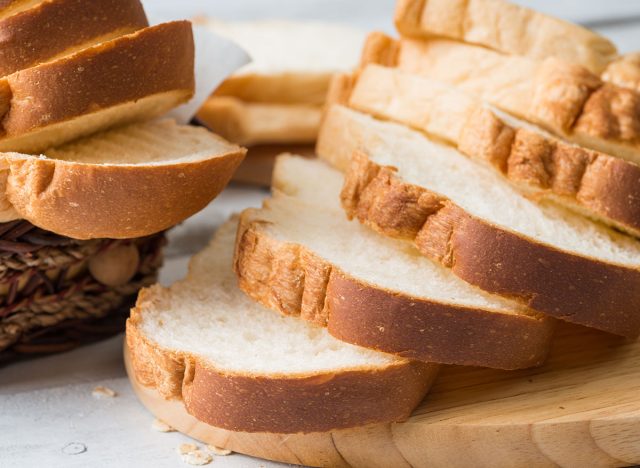
Unhealthy Ingredient: Bleaching chemicals such as azodicarbonamide
If the ingredients label on your loaf of bread mentions bleached flour, you're very likely munching on some undesirable chemicals. Some manufacturers use an ingredient called azodicarbonamide, a plastic dough conditioner used to make bread dough fluffier. The Center for Science in the Public Interest says you should avoid it, citing evidence that azodicarbonamide breaks down into a chemical called urethane during the baking process, and this chemical is considered a carcinogen—AKA a substance that can lead to cancer.
Eat this instead: There are plenty of whole-grain and whole-wheat breads that don't include bleaching chemicals. Not only that, but they are better for you in a variety of other ways, too because many of them include sprouted or whole grains, providing you with much more fiber. For instance, try one of Dave's Killer Bread loaves or Mighty Manna bread.
Sugar-Added Fruit Juice
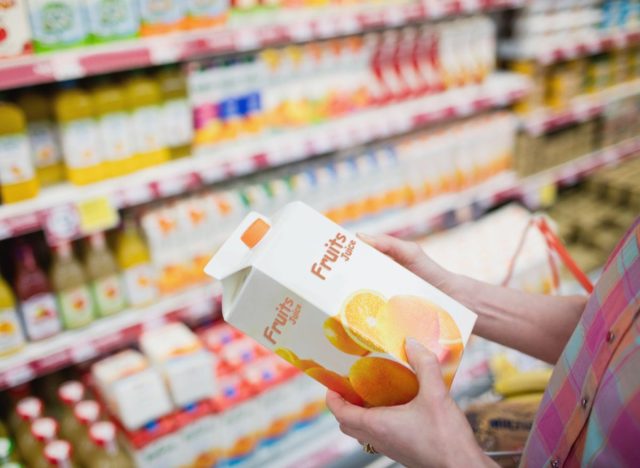
Unhealthy Ingredient: Added sugars, fiber-less fruit, high-fructose corn syrup
Juice may seem like a healthy choice at first, but not all fruit juices are created equal. While things like 100% pomegranate juice offer tons of antioxidants and vitamins, as well as natural sugars, some store-bought juice brands just sell products that have more added sugar than actual fruit.
For example, Simply Cranberry Cocktail contains 29 grams of added sugar per serving, and according to their website, only 27% of this drink is made with not-from-concentrate cranberry juice. What's more, most of the sweetness in juice comes from fructose, a type of sugar associated with the development of visceral adipose tissue in overweight people—yep, that's belly fat—according to a study in the Journal of Clinical Investigation.
Drink this instead: Stick to 100% juice and avoid things with "cocktail" in the name to cut out added sugars from your drink.
Diet Sodas

Unhealthy Ingredients: Aspartame
What do artificial colors, flame retardants, and fake sugars all have in common? They're ingredients in your favorite diet fizzy drinks. Nearly all popular diet sodas contain aspartame, an artificial sweetener that was initially developed to aid weight loss, but that has recently been found to have the opposite effect, like raising glucose levels, overloading the liver, and causing the excess to convert into fat, according to a study in Applied Physiology, Nutrition, and Metabolism. Not only that, but recent research from PLOS Medicine found that aspartame was linked to an increased risk of cancer.
Eat this instead: If you want something more exciting than a plain old glass of water, you're in luck. Plenty of companies out there now make healthier soda alternatives that still satisfy your cravings for something sweet and bubbly but without the scary ingredients.
Fried Foods
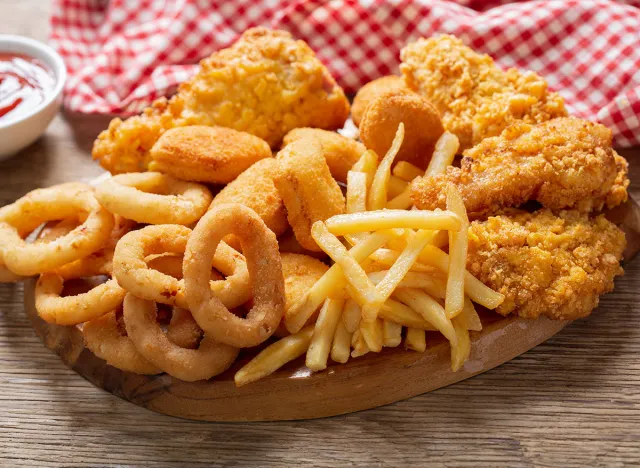
Unhealthy Ingredient: High heat, inflammatory oil
Fried chicken, fried calamari, pork rinds, chicken-fried steak. Aside from the very high fat and calorie count, the main issue with these fried foods is that they contain high levels of inflammatory Advanced Glycation End products (or AGEs). These compounds form when animal-derived products are cooked at high temperatures for a prolonged period. According to a 2015 review published in the journal Advances in Nutrition, experts conclude that when we are exposed to AGEs consistently over time, it can lead to inflammation and oxidative stress in the body, which can then contribute to an increased risk of disease.
Eat this instead: When you can, opt for baking or air frying your food instead of throwing it in oil to fry.
Sausage

Unhealthy Ingredients: Nitrates and nitrites, high-heat cooking methods
Processed meats like sausage are the worst of both worlds. For one, they're typically made from red meat, which is high in saturated fats. And while red meat alone isn't terrible for you, processed red meat often contains high levels of sodium, as well as additives like nitrates and nitrites. Research has shown that nitrites can lead to certain cancers, and these additives can turn into carcinogenic nitrosamines when exposed to high heat, according to a study published in the journal Meat Science. (And you're typically roasting your sausages on a flame-flickering grill or in a frying pan, right?)
Eat this instead: Although some ultra-processed food companies are making food with fewer nitrites than they once did, you can take extra precautions to limit your nitrosamine exposure by purchasing uncured meats that use no nitrites—only salt—and try turning down the heat. "Just keep in mind that the nitrates present in food sources like celery juice or spinach extract (which are used in some 'nitrite-free' options) are reduced to nitrites by the addition of starter bacterial cultures and contribute to nitrosamine formation just as synthetic versions do. Some meat-free hot dog alternatives can satisfy a craving without the risk of including these potentially harmful ingredients in your diet," shares Manaker.
Sugary Cereal
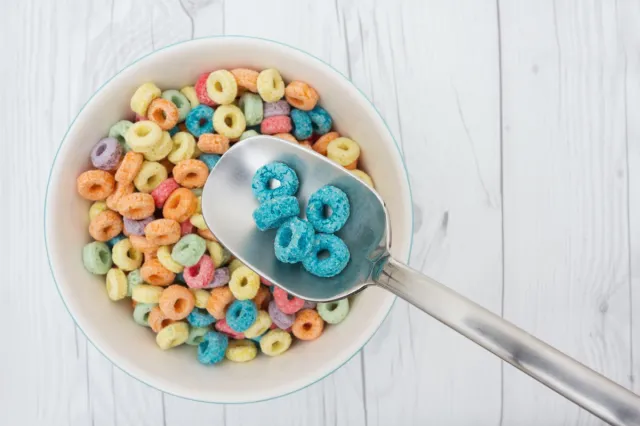
Unhealthy Ingredients: refined carbohydrates, added sugar
There's no sugar-coating it: sugar wreaks havoc on the body. Consuming too much of the stuff can lead to obesity, which may cause other health problems like diabetes and heart disease. Unfortunately, many unhealthy cereals pack more sugar into one bowl than you'll find in a Boston Cream Donut, making these some of the unhealthiest foods you can eat for breakfast!
As an example, Fruity Pebbles have 12 grams of added sugar per cup but only contain 1 gram of protein and no fiber at all, and Golden Crisps have 21 grams of added sugar, 2 grams of protein, and no fiber either. Without fiber or protein to back up these sugar bombs, you won't feel satiated after breakfast at all.
Eat this instead: Look for cereals that have less added sugar, as well as more fiber and protein. Purely Elizabeth's Vanilla Blueberry cereal has only 8 grams of added sugar and contains 5 grams of protein and 6 grams of fiber.
Frozen Entrées
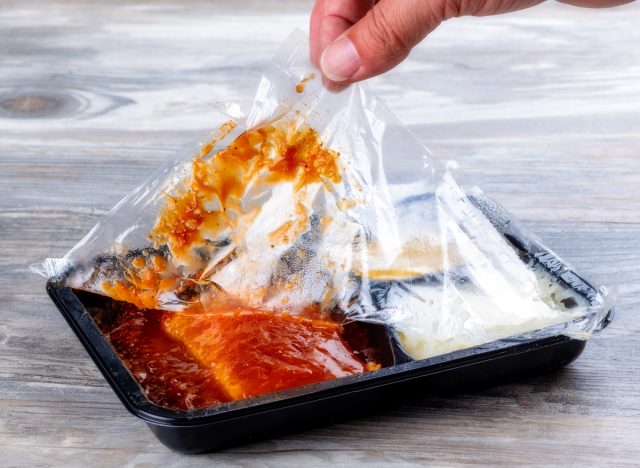
Unhealthy Ingredients: Too much sodium, preservatives
Freezing food is a terrific way to make it last longer, so why add preservatives? Unfortunately, many manufacturers pile them on when making frozen food. For instance, if you treat yourself to Marie Callender's Cheesy Chicken & Bacon Pot Pie frozen meal, you'll be consuming a whopping 28 grams of saturated fat and 1,500 milligrams of sodium. When you realize that the daily recommended maximum for sodium is 2,300 milligrams, you'll see that these choices come close to the limit in just one meal.
Eat this instead: Opt for low-sodium, low-sugar frozen options that contain fewer additives. Amy's Kitchen is a great brand that makes healthier frozen versions of entrées like enchiladas, pad thai, mac and cheese, and more!
Restaurant Desserts
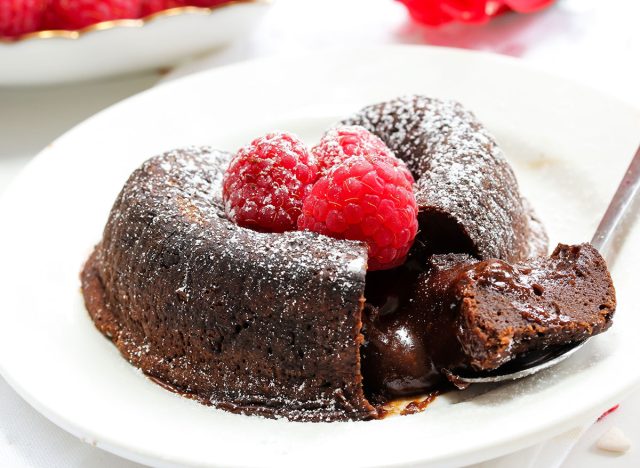
Unhealthy Ingredient: Too much saturated fat, sodium, and added sugar
While restaurant desserts are often more harmful to your health because the portions are so oversized, it's the fact that most of these dessert dishes are high in everything: think calories, total fat, saturated fat, sodium, and sugar, that make them some of the unhealthiest foods around. Take the Chili's Skillet Chocolate Chip Cookie Cake, for example, which has 1,210 calories, 50 grams of fat, 25 grams of saturated fat, 0.5 trans fat, 890 milligrams of sodium, and a whopping 105 grams of sugar.
Eat this instead: A small scoop of sorbet or a scoop of vanilla ice cream is a low-risk way to satisfy that sweet tooth at the end of a meal.
Added Sugar
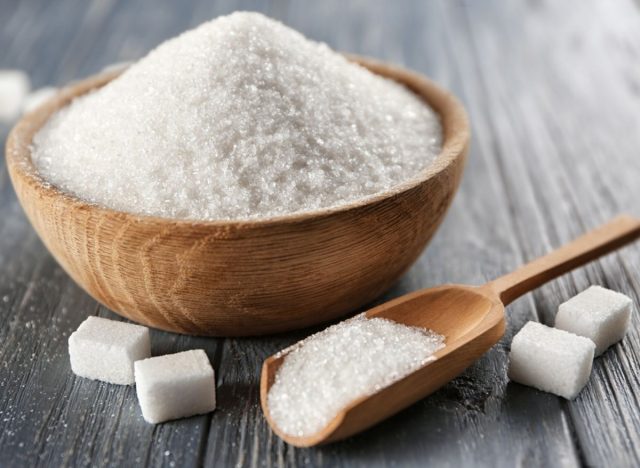
Unhealthy Ingredient: Sugar (when consumed in excess)
According to the American Heart Association (AHA), adults in America consume about 77 grams of sugar per day—which is more than 20 grams above the FDA's recommended intake of 50 grams per day. And the AHA recommends that Americans eat even less than that amount with just 25 grams for women and 36 grams for men! Americans' high consumption of refined, white sugar has been linked to an increased risk of type 2 diabetes, heart disease, and obesity.
Eat this instead: You don't have to eliminate sugar from your diet by any means, but if you're looking to lower it while still satisfying your sweet cravings, you could always try a zero-calorie sweetener. (Just make sure you're looking for the ones without aspartame.) "Allulose is another option that provides a natural sweetness that won't spike blood sugars. It is a rare sugar, making it a perfect choice for people who are avoiding anything artificial," says Manaker.
Cake Frosting
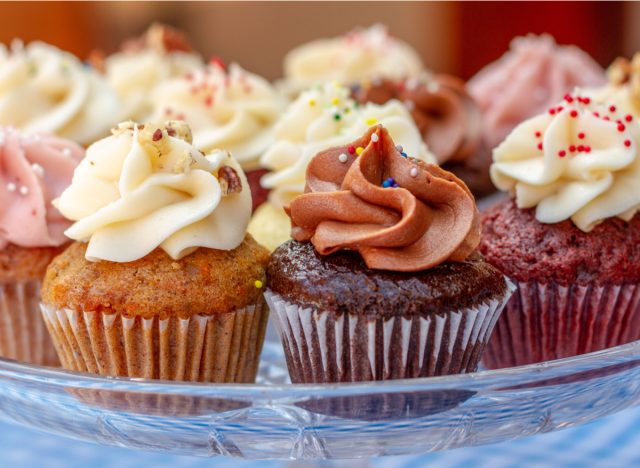
Unhealthy Ingredients: Titanium dioxide, caramel color, artificial colors
Birthdays are a time to celebrate. Something you shouldn't celebrate? Your frosting is made with chemicals. Many brand-name frostings, such as Duncan Hines' Creamy Home-Style Classic Vanilla, are tinted with potentially carcinogen-contaminated dyes (such as caramel color and titanium dioxide) and artificial colors, making this one of the unhealthiest foods to eat. "Just remember that 'the dose makes the poison,'" says Manaker. "So, a slice of birthday cake on your big day is unlikely to cause harm. Eating birthday cake made with these ingredients every single day? That's another story."
Eat this instead: Healthier, homemade frosting is as easy to make as it is delicious. For example, using avocados and dark chocolate, you can create a decadent buttercream-like frosting that takes just seconds to prepare. "For people who want to skip the homemade process, Miss Jones makes frostings that are almost as good as what mama makes, and they are free from questionable ingredients," says Manaker.
Pancake Syrup
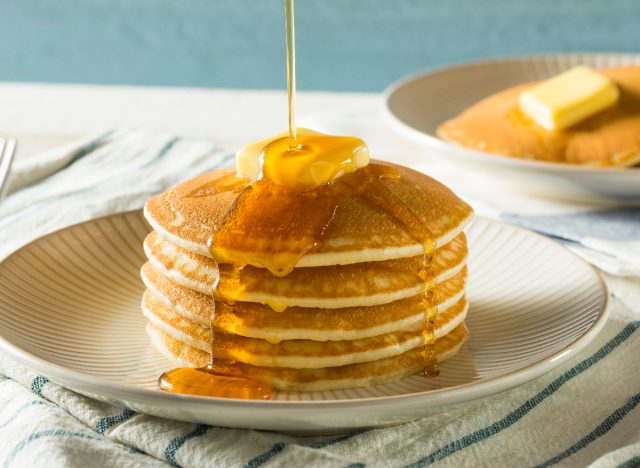
Unhealthy Ingredients: High fructose corn syrup, caramel coloring
There's a big difference between natural maple syrup and extra sugary pancake syrup. Famous syrup brands like Aunt Jemima and Mrs. Butterworth's aren't maple syrup at all and are made with two ingredients we're constantly telling readers to avoid—liver-damaging high fructose corn syrup and carcinogen-contaminated caramel coloring.
Eat this instead: Your safest bet is going with something like this Grade A Medium Amber Pure Maple Syrup. Because the flavor is so concentrated, a little goes a long way, saving you calories and sugar. "And pure maple syrup contains natural antioxidants that the sugary pancake syrups can't claim to have as well," says Manaker.
Bottled Smoothies
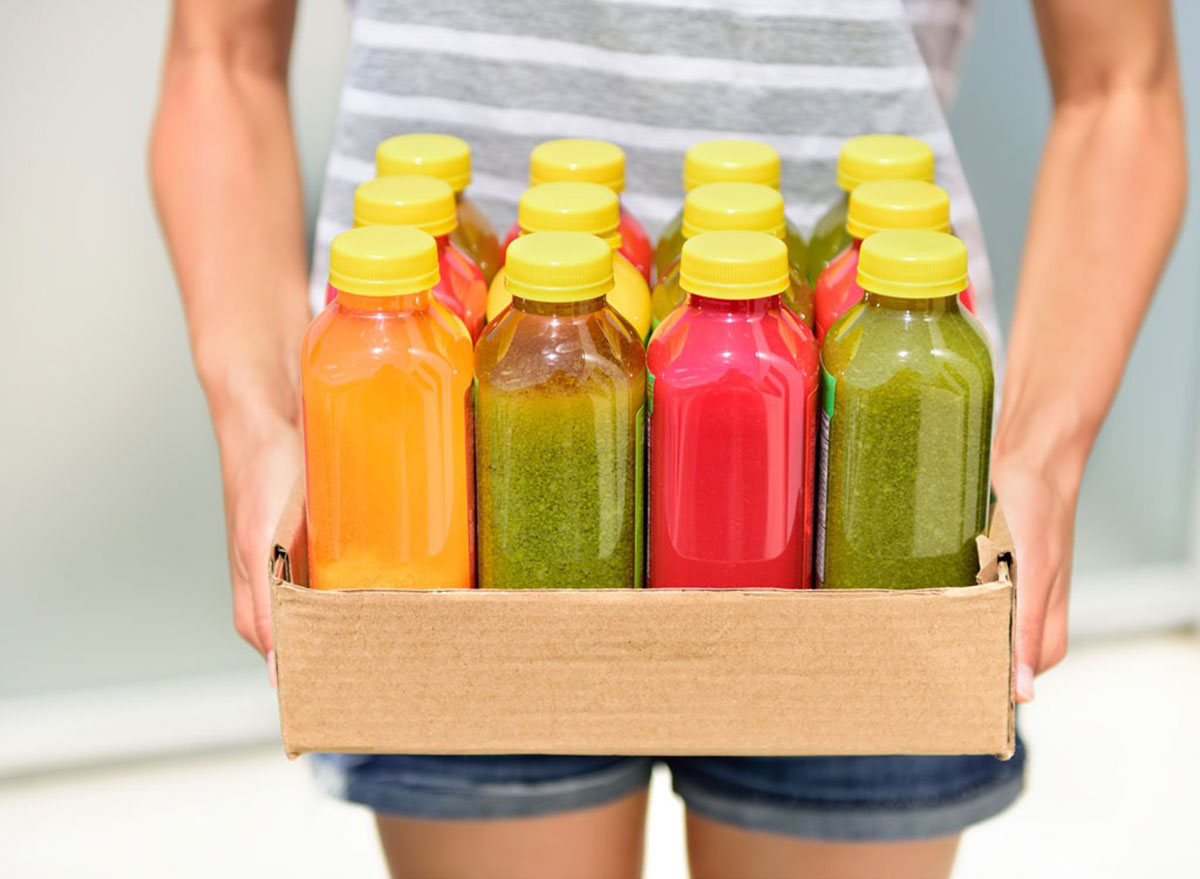
Unhealthy Ingredients: Fiber-less fruit and too much sugar
Busy mornings and grab-and-go breakfasts are practically synonymous—so it's easy to see the appeal of store-bought smoothies. They seem like the best way to get what you're craving in a pinch. But the timesaving drinks have a downside: Compared to freshly made smoothies, most of them fall short on nutrition and are so calorie and sugar-filled that your blood sugar is sure to skyrocket.
Just take Naked's Strawberry Banana Smoothie as an example: Downing this entire bottle will fill you up with a whopping 44 grams of sugar and absolutely zero fiber, which means there's nothing to help keep your blood sugar in check.
Drink This! instead: We know it takes more time and effort, but blending up a homemade smoothie will help you keep some of the fiber from the fruit and vegetables, as well as help you control how much sugar you're using and allow you to add in some protein powder if you'd like. "Keep a stock of frozen fruit and veggies to make smoothie making easier by saving the effort of chopping and keeping fresh options on hand at all times," says Manaker.
Charred Meats
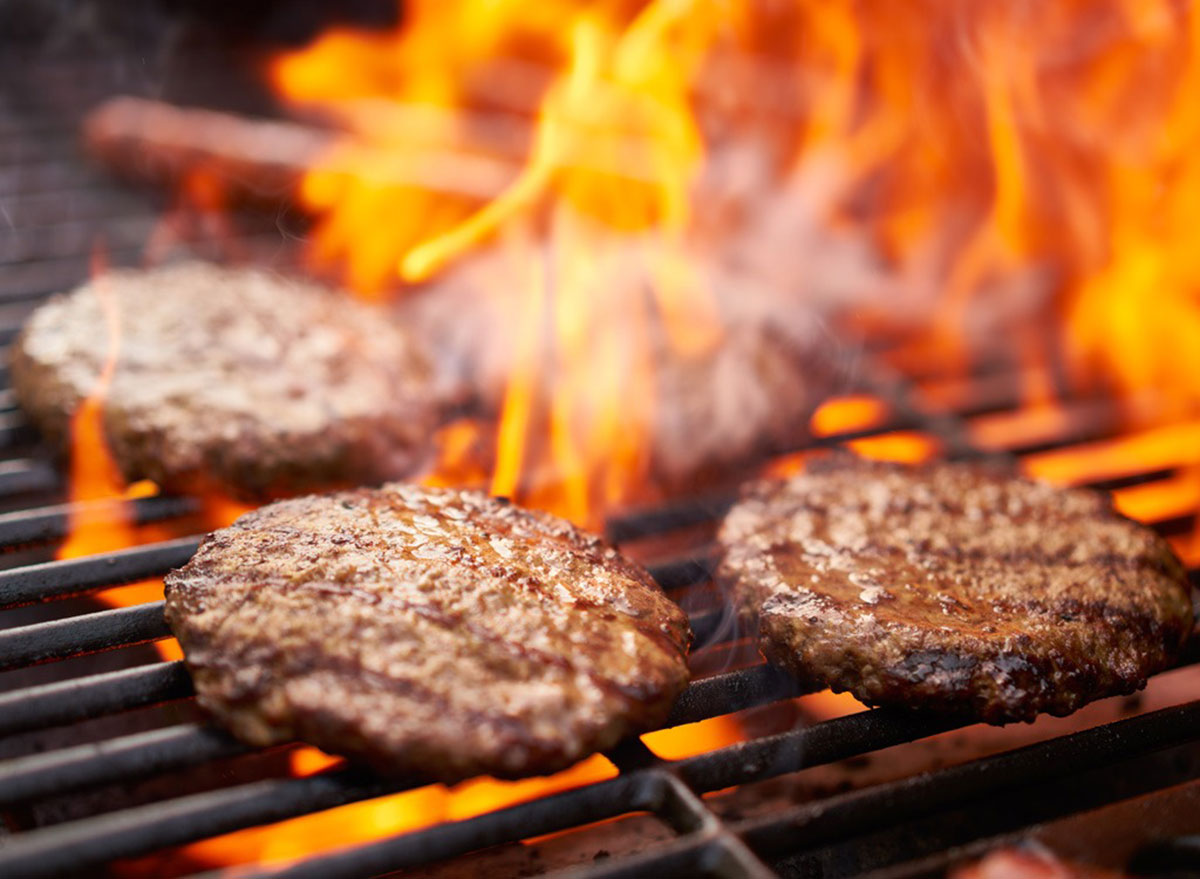
Unhealthy Ingredients: High heat combined with muscle meat from beef, pork, poultry, and fish
Grilling is awesome, but you have to watch your char! When you char meat, something called heterocyclic amines (or HCAs), develop as the creatine, sugars, and amino acids in meat react to your grill's high temperatures. Several studies published have linked HCAs with an increased risk of certain cancers—including pancreatic cancer.
Eat this instead: To chop your risk, spice it up! Adding antioxidant-rich spice extracts, like rosemary, to beef patties or marinating it in wine or beer can help reduce HCAs in your grilling process. Manaker shared that the same risk does not apply when you eat grilled veggies, so a charred portobello mushroom cap can satisfy a craving safely.
Energy Drinks
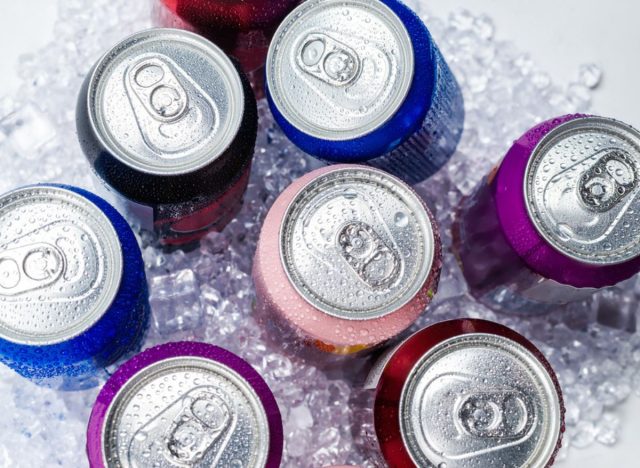
Unhealthy Ingredient: Too much sucrose, glucose, and caffeine
Energy drinks are simply overpriced chemical cocktails with the caffeine content of a strong cup of coffee and a lot of sugar (or scary artificial sweeteners). Here's why you should be concerned: A University of Maryland study found energy drinks to be 11 percent more corrosive to your teeth than regular soda. Gross, right?
Another unsettling finding came from a case study of a 50-year-old construction worker; having too many energy drinks could destroy your liver. The report, published in BMJ Case Reports in 2016, found that the man developed acute hepatitis after consuming four to five energy drinks every day over three weeks.
Drink this instead: Green tea—it's all-natural and one of the best energy boosters around. Or, if you're someone who can drink coffee without feeling the jitters, try a cup in the morning. Just make sure you don't go overboard on the caffeine, as you may experience anxiety, increased heart rate, or trouble sleeping.
Ready-to-Bake Pie Crust
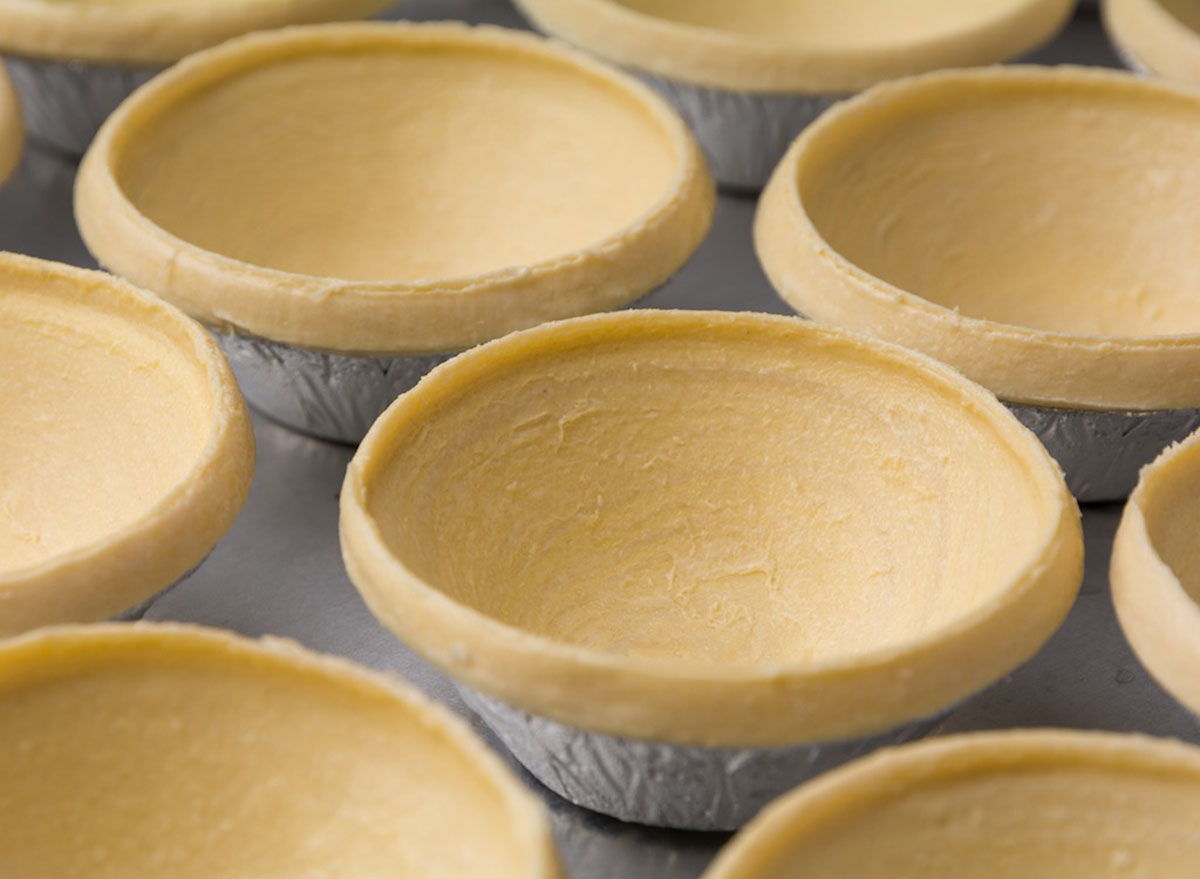
Unhealthy Ingredients: BHA and BHT
Using a premade pie crust might save you some time when you're baking, but what's on store shelves is anything but healthy for you. Popular brands like Pillsbury's Refrigerated Pie Crust contain BHA and BHT, two preservatives that have been banned in some European countries, as well as unbleached flour as their number one main ingredient.
Eat this instead: We suggest making sure the ingredients list is free from these preservatives if you're going to buy one in the store, or you can make your own at home. "You can also skip the crust and make a crustless pie," says Manaker. "Try topping it with graham crackers for an appealing crunch."
Sucralose
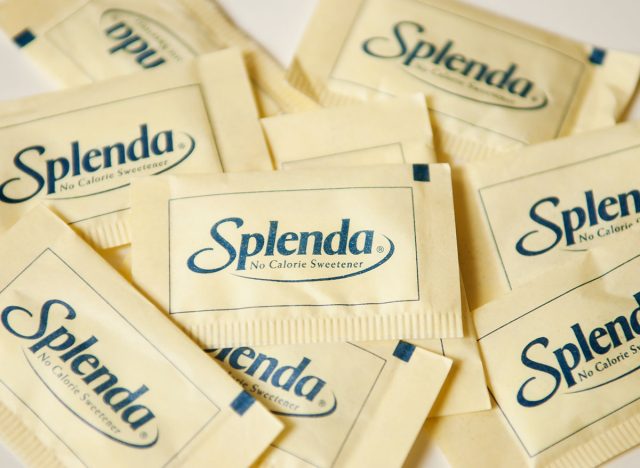
Unhealthy Ingredient: Sucralose
Sweeteners with sucralose might have zero calories (like Splenda), but that doesn't mean it has zero effects on your health. A recent Canadian Medical Association Journal review of 37 studies analyzed the dietary habits of nearly 406,000 people. The researchers discovered that non-nutritive, artificial sweeteners, such as sucralose, don't support weight management and may be associated with weight gain and cardiometabolic risk if consumed regularly.
In addition, a study in Cell Metabolism found that sucralose consumption led to increased cravings and hunger. It has also been found to possibly alter the gut microbiome and lead to glucose intolerance.
Eat this instead: Before sugar was widely available, people's go-to sweetener was honey, and it still stacks up. Although honey is high in fructose, it also contains a lot of cancer-busting antioxidants. Additionally, local honey has been said to help alleviate allergy symptoms. If you're still looking for a zero-calorie sweetener, you can also try monk fruit. "Allulose is a rare sugar that doesn't spike blood sugars like sugar does," says Manaker. "It can be another nice alternative if you're avoiding sucralose."
Manaker also notes, "While the data surrounding sucralose is concerning, more quality data is needed to determine if sucralose is something all of us should be avoiding entirely."
Breakfast Biscuits
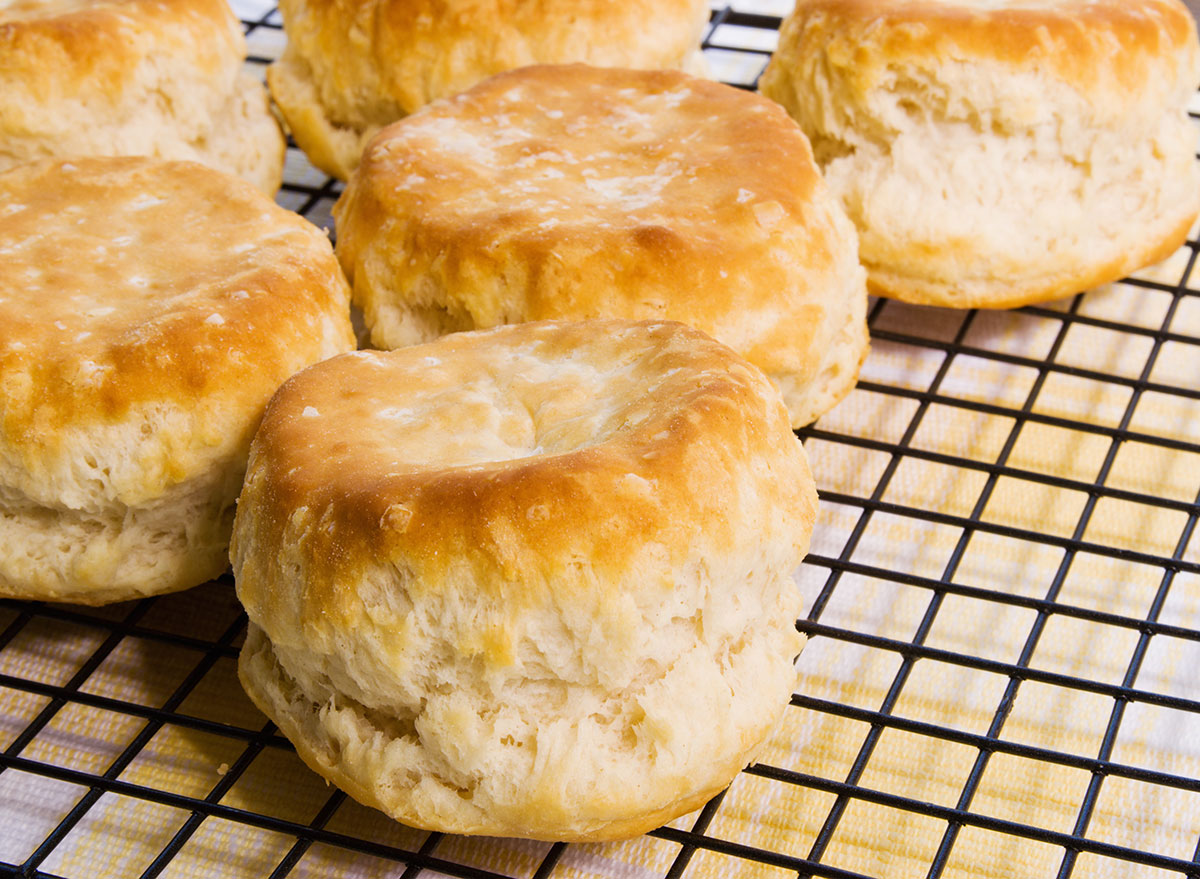
Unhealthy Ingredient: bleached flour, too much sodium, partially hydrogenated oil
Making biscuits from scratch can take forever, but the packaged kind that you just pop in the oven—like Pillsbury— are often full of sodium, bleached flour, and partially hydrogenated oil. In 2015, the FDA declared that partially hydrogenated oils were not safe and that they could contribute to cardiovascular events or heart disease.
Eat this instead: Your best solution is to just make biscuits at home, even though we know it takes much more time and energy. However, our recipe for Southern-Style Biscuits is easier and has fewer ingredients than most.
BBQ Sauce
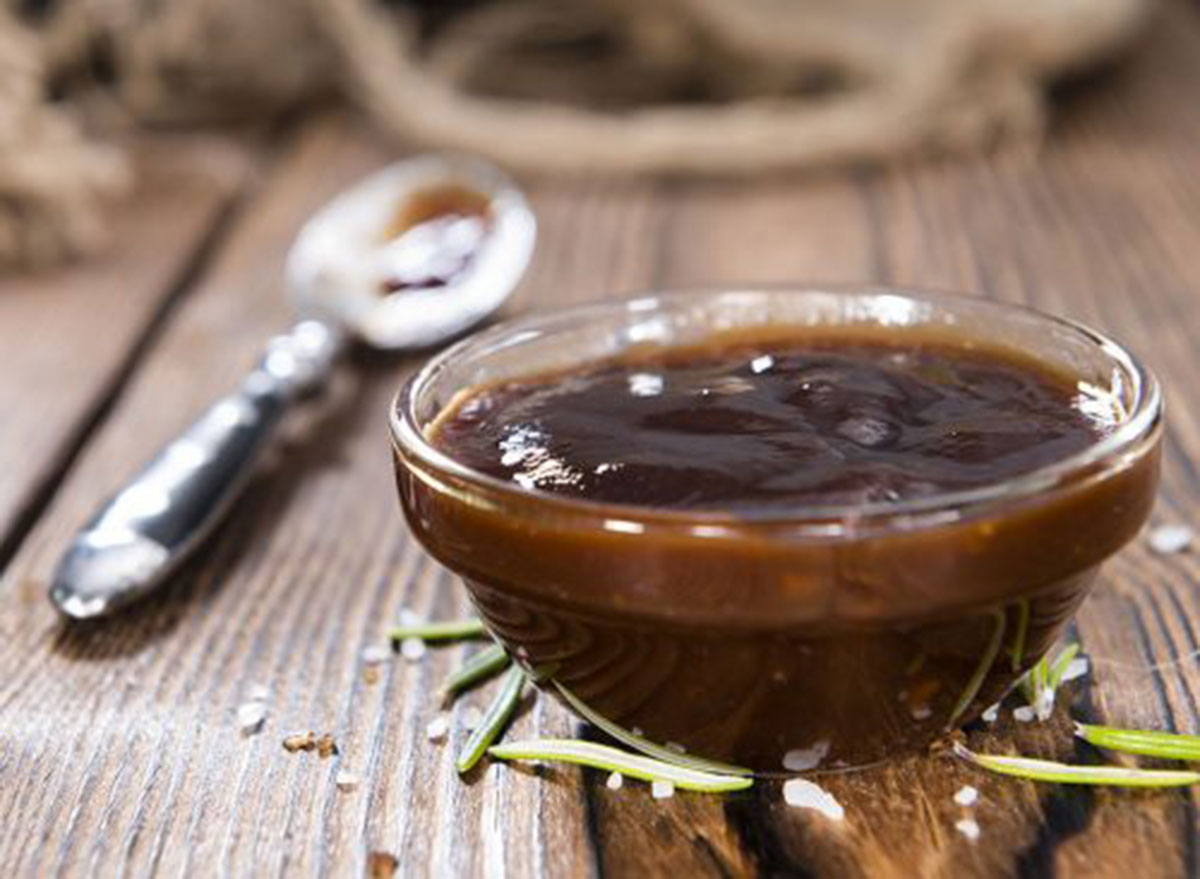
Unhealthy Ingredient: High fructose corn syrup
Barbecue sauce may be the condiment of choice for people who love something smoky and sweet, but it can do damage to your waistline. Most bottled BBQ sauces are packed with tons of added sugar and sugar variations. Take Sweet Baby Ray's Honey Barbecue Sauce—not only does it have 15 grams of sugar in just two tablespoons, but the first ingredient listed is high fructose corn syrup.
HFCS has been linked to an increased risk of heart disease, according to a study from the American Journal of Clinical Nutrition. Also made with corn syrup and sugar, this sauce is the equivalent of pouring almost four sugar packets on your pulled chicken or bratwurst.
Eat this instead: If you need a condiment for your hot dog, opt for mustard instead. It's super low-calorie at just 3 calories per teaspoon and packs a flavorful punch. If you must have BBQ sauce, make a low-sugar version yourself with some tomato paste, vinegar, Worcestershire sauce, liquid smoke, and spices.
You can also find some healthier store-bought bottles, like the BBQ Sauce from Primal Kitchen. "Primal Kitchen Classic BBQ Sauce is made with quality ingredients and only contains 3 grams of sugar (0 grams added sugar)," says Manaker. "It is organic and unsweetened, and it leans on ingredients like organic date paste and organic apple cider vinegar for its satisfying flavor."
Sports Drinks
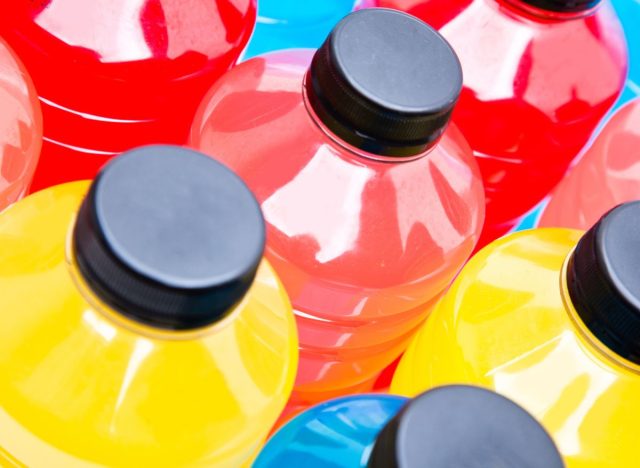
Unhealthy Ingredients: Too much sugar, artificial dyes
Whoever invented the Gatorade Dunk—the tradition in which winning sports teams dump coolers of the stuff on their coaches—was really on to something. One scan of the nutrition label and it's clear: the sports drink is better off seeping into the sidelines than your stomach.
Sure, it provides critical post-workout electrolytes, like sodium and potassium, but it also serves up a hearty helping of calories and sugar. In fact, there are 48 grams of the sweet stuff in a bottle of Gatorade. With the daily recommended limit being 36 grams for men and 24 grams for women, it's clear that these drinks are far too sugary. What's more, the beverage is teeming with additives and artificial dyes like Red 40—which has been recently linked to irritable bowel disease.
Drink this instead: If you need some helpful electrolytes to rehydrate, ditch the Gatorade or sports drink and opt for an electrolyte powder like these 9 Healthiest Electrolyte Powders.
Restaurant Cheesecake
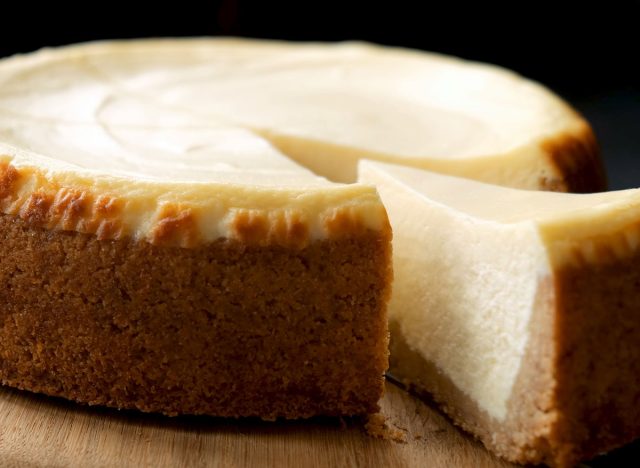
Unhealthy Ingredient: Too much sugar, fat, and saturated fat.
Cream cheese is indulgent on its own, but it soars to new heights when it's made into a decadent, creamy cake. Cheesecake is almost always filled with high amounts of fat, sugar, and sodium, and it will set you back an astronomical amount of calories for one slice of a treat you usually eat after dinner. Just take a look at any cheesecake from The Cheesecake Factory. The Original Cheesecake option has 830 calories, 59 grams of fat, 37 grams of saturated fat, and 51 grams of sugar.
Eat this instead: If you're feeling adventurous and want to try your hand at making your own cheesecake, you can try one of these healthier cheesecake recipes at home. "Or, try a Clio's Bar — made with Greek yogurt and tastes just like cheesecake," says Manaker.
Restaurant Tiramisu
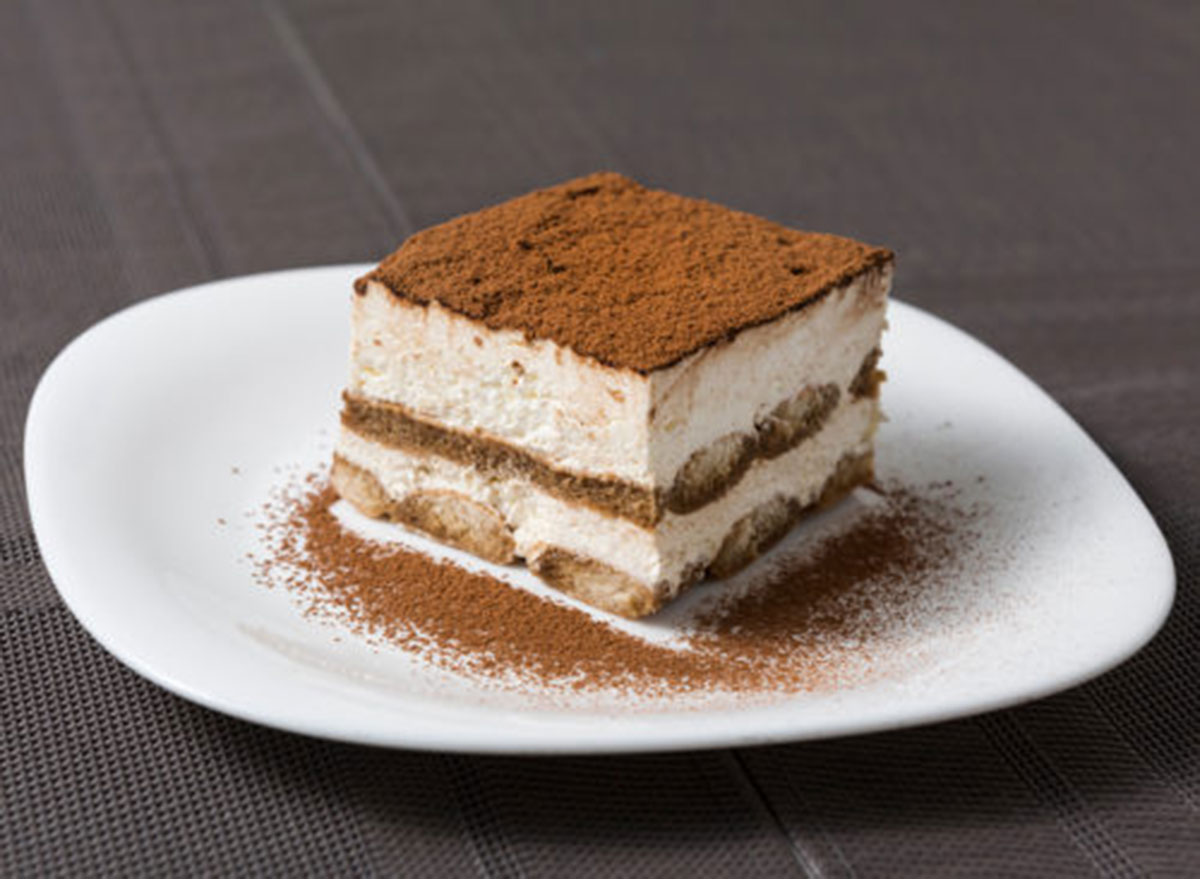
Unhealthy Ingredient: Too much sugar
This creamy dessert is on the decadent side, thanks to confectioners' sugar, whipped cream, espresso, ladyfingers, egg yolks, and mascarpone, just to name a few of the ingredients that quickly make this dessert into a high-calorie, sugar-heavy dish. Just take The Cheesecake Factory's version as an example, which comes in at more than 1,200 calories, 66 grams of sugar, 94 grams of total fat, and 52 grams of saturated fat. This dessert certainly isn't worth it when you realize that the recommended daily maximum of saturated fat comes in at around 13 grams.
Eat this instead: While this is always a "sometimes" dessert, try making your own version at home. You're not only in control of the portion size, but also what you're putting in the cake, so you can make substitutions, such as using egg whites and lighter whipped cream cheese.
Margarine
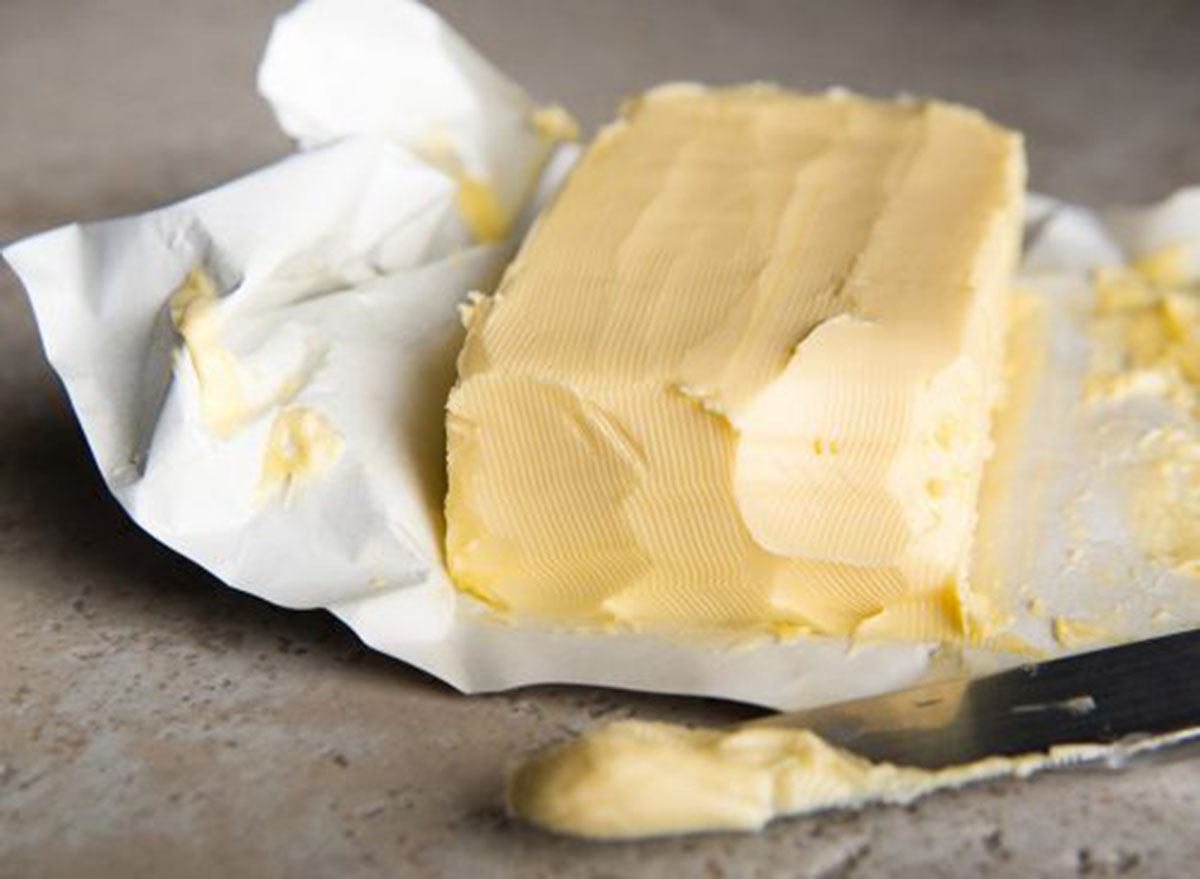
Unhealthy Ingredient: Palm oil
You know the creamy taste of margarine had to come from somewhere, and usually, it's from the addition of vegetable oils—and many blends can include palm oil, which has a high saturated fat content (over 13 grams for just two tablespoons), and research suggests that there may be a link between palm oil and cardiovascular disease risk.
Eat this instead: Instead of spreading your bread with margarine, why not swap in olive oil instead? Just make sure you're using exact measurements so you're not overdoing it, as one tablespoon has 120 calories. According to Manaker, "A quality finishing oil, like Graza, can give dishes a rich flavor with a boost of healthy fats."
Taco Bowls
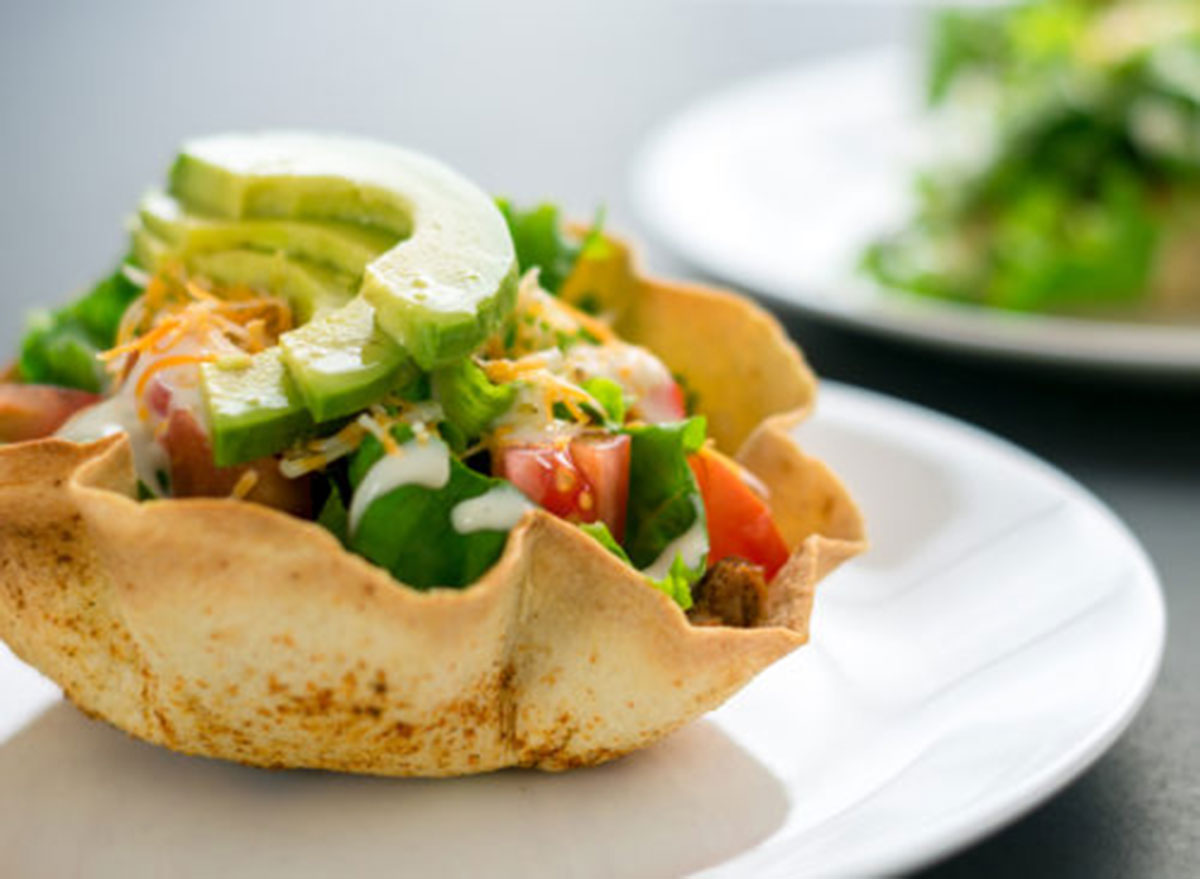
Unhealthy Ingredient: Too much sodium and fat
A taco bowl is one of the quickest ways to consume a lot of calories, fat, and sodium all at once. Between the fried tortilla, filling of meat, rice, cheese, sour cream, sauces, and other toppings, things can get out of control quickly, and it can take a regular burrito bowl or taco salad and turn it into a calorie-heavy dish.
Eat this instead: If you're craving a taco salad, we suggest making one at home and skipping the taco shell bowl. All you need is lettuce as your base, protein, some beans, and salsa. If you want to keep things even more lean, try skipping the sour cream, or substituting in some Greek yogurt instead. When you're in full control of the ingredients, that's always the best-case scenario.
For seasoning, Manaker suggests Just Spices, "which offers a variety of spice blends that can enhance a taco bowl with quality ingredients. Each blend is made with 100% natural and vegan-friendly ingredients."
Frozen Pizza

Unhealthy Ingredient: Too much sodium, food additives
Popping a frozen pizza in the oven might save you more time than ordering one from your local pizza shop, but with high sodium counts and scary food additives, you might want to keep these slices in the freezer section.
Red Baron's Classic Crust 4 Cheese Pizza has ingredients such as ammonium sulfate (a commonly used lawn fertilizer), along with 720 milligrams of sodium and 9 grams of saturated fat per serving, while Digiorno Croissant Crust Three Meat Pizza contains a whopping 1,200 milligrams of sodium, 25 grams of saturated fat, and the additive sodium nitrite.
Eat this instead: At the end of the day, it's best to just make your own pizza! If you're craving a Hawaiian-style pie or a breakfast-friendly variety, a homemade pie is never a bad idea, as you're in complete control of the ingredients. Start with whole-wheat pizza dough, a low-sodium marinara sauce, a light sprinkle of cheese, and your absolute favorite toppings.
Fettuccine Alfredo
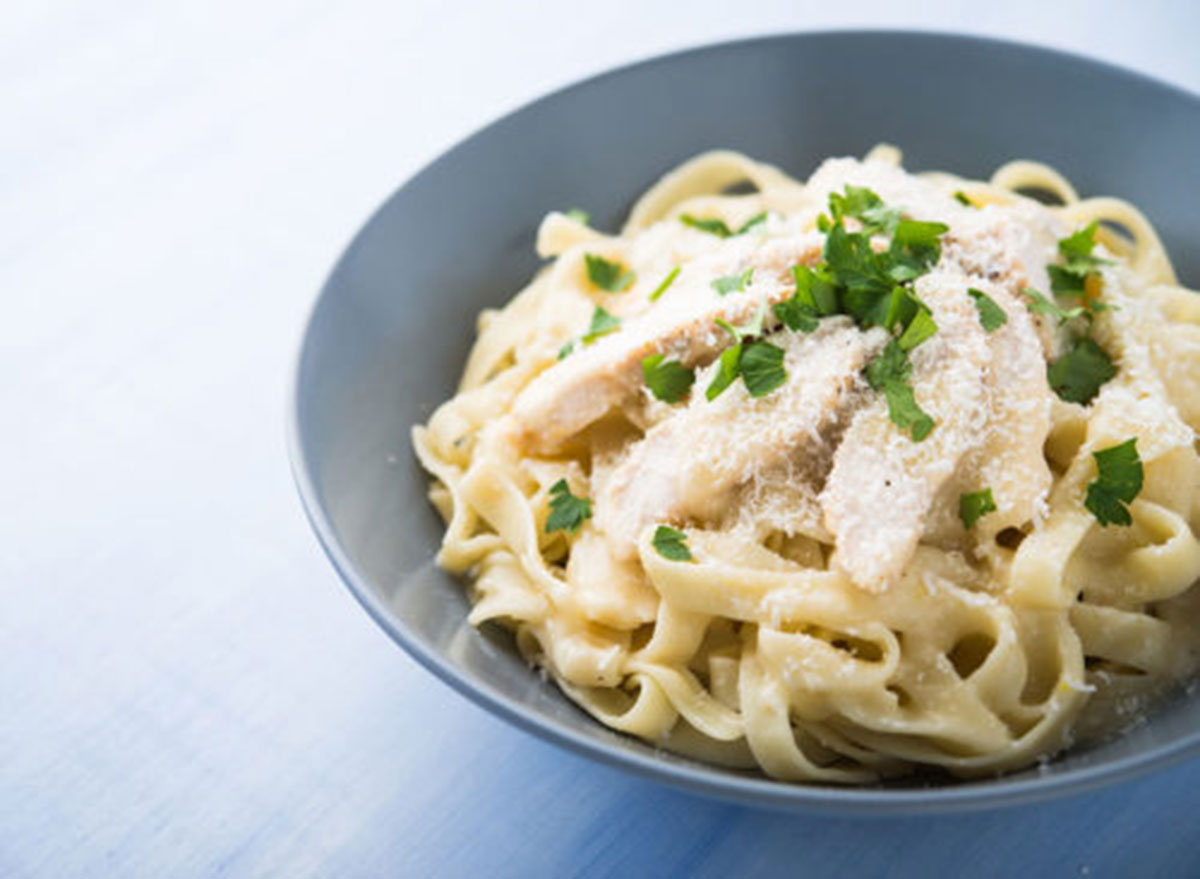
Unhealthy Ingredient: A ton of cream, butter
Alfredo sauce is made from cream, parmesan cheese, and a lot of butter, which together just wreak havoc on your waistline. Cream is rarely used in authentic Italian pasta dishes, so if you visit Italy, there's a good chance you won't find this dish on restaurant menus. It is present on the Olive Garden menu, however, and it comes in at 1,310 calories, 55 grams of saturated fat, and 1,200 milligrams of sodium, proving this is another all-American version of a classic dish you're better off without.
Eat this instead: If you're craving pasta, go with a classic spaghetti aglio e olio recipe, as this dish has very few ingredients: garlic, oil, salt, and pasta, which gives it fewer overall calories, saturated fat, and sodium.
"A tasty pasta that can be enjoyed in minutes and is made with quality ingredients like cauliflower is Kevin's Natural Foods Chicken Piccata with Cauliflower Pasta," says Manaker. "This sauce is dairy-free and made with only quality ingredients. It's also totally Paleo-friendly and gluten-free too."
Belgian Waffles
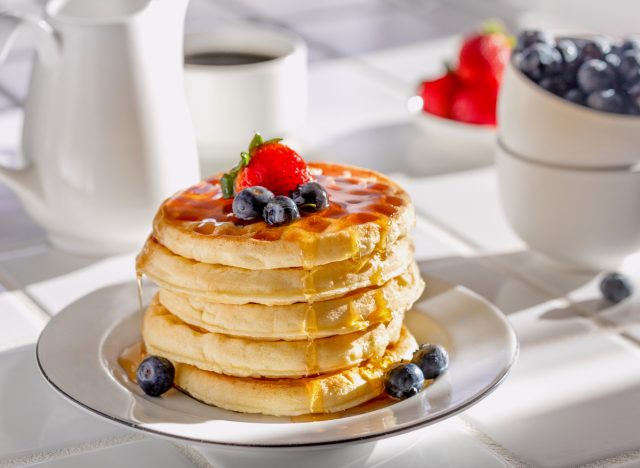
Unhealthy Ingredient: Too much sodium, refined carbohydrates
Belgian waffles tend to be bigger and thicker with deeper grids meant to hold even more syrup, butter, and cream so that right there is reason enough to avoid choosing this as a breakfast option when you find yourself out to eat at a diner. Plus, they are often loaded with sugar and sweet batters, which means they can go from bad to worse. These waffles are also loaded with simple refined carbohydrates, which make them too easy to digest and not very promising when it comes to keeping you full and focused.
Eat this instead: Go with a traditional waffle you can whip up at home and make sure to top with fruit and pure maple syrup. Using Kodiak Cakes as batter helps boost the nutrition found in these breakfast items, too, Manaker says.
Onion Rings
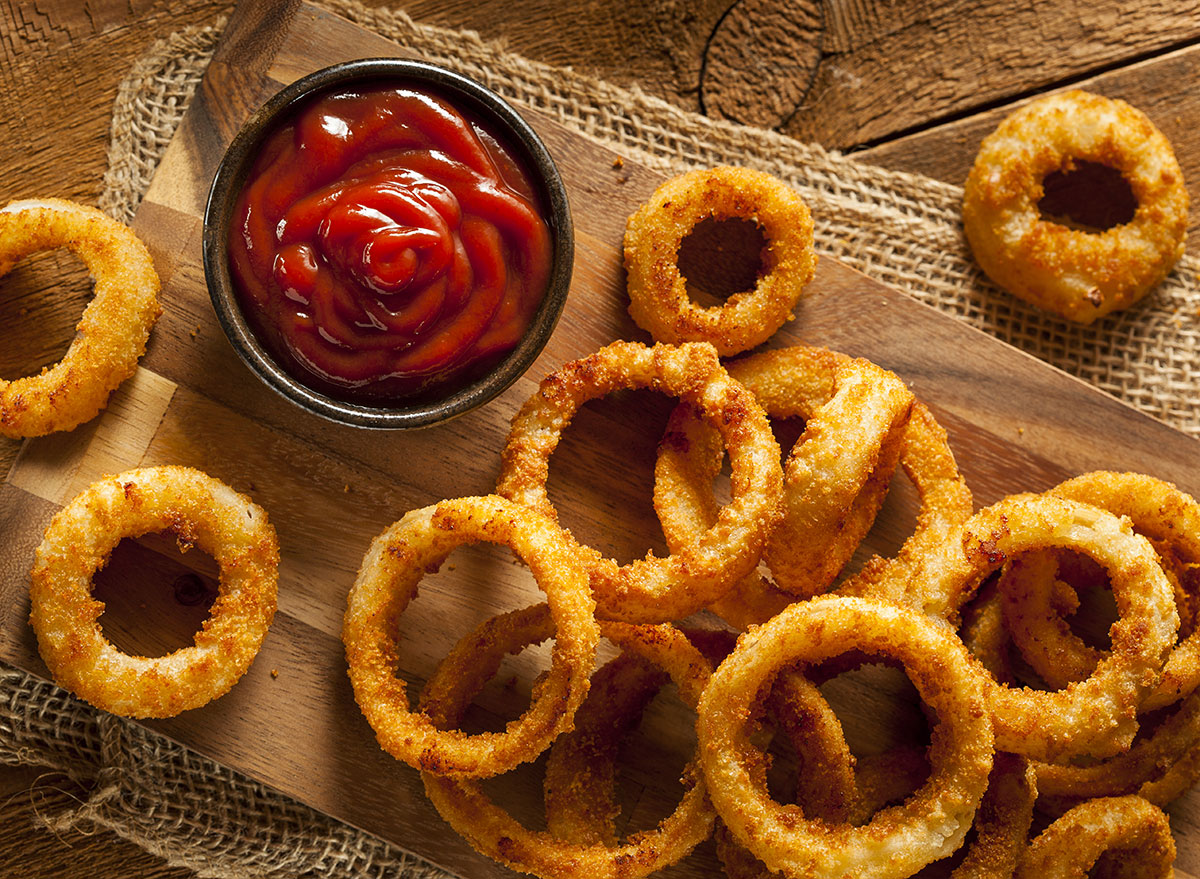
Unhealthy Ingredient: Sugar and saturated fat
The onion ring is a great example of how everything good about a vegetable can be expunged after being deep-fried. Depending on the restaurant where they are served, onion rings are oftentimes worse than even fries because they tend to have more calories, saturated fat, and total fat.
For example, Sonic Onion Rings have 580 calories, 29 grams of fat, 5 grams of saturated fat, and 570 milligrams of sodium, and their fries only have 290 calories, 13 grams of fat, 2.5 grams of saturated fat, and 300 milligrams of sodium.
Eat this instead: Restaurant appetizers like onion rings are almost always going to be loaded with calories. If you want something to munch on before your main dish, order the grilled calamari, a house salad, or some chips and salsa instead. Or, if you want some onion rings, make sure you share them with the table.
Mayonnaise
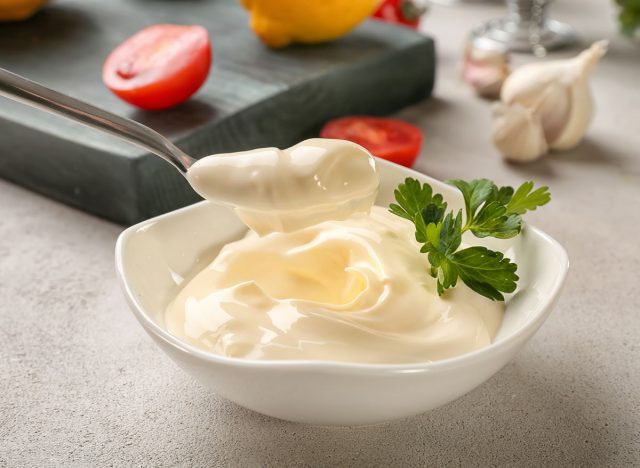
Unhealthy Ingredient: Too much fat
Mayo is delicious, but this condiment contains a ton of fat per serving. For instance, there are 10 grams of fat and 1.5 grams of saturated fat in one tablespoon of Kraft Mayo, and we know how easy it is to go beyond just one tablespoon of this creamy condiment. When it comes to preventing disease and maintaining a healthy heart, saturated fat is the thing you want to keep an eye on, and mayo is usually decently low in this type of fat. But with 10 grams of total fat per serving, it may cause you to consume excess calories, which may lead to weight gain.
Eat this instead: You can make a healthier version of mayo at home by blending Greek yogurt, lemon juice, mustard, pepper, and spices. You'll save more than 200 calories and 20 grams of fat per quarter-cup serving. Plus, Greek yogurt is rich in protein and calcium, so it makes for a heartier, healthier spread. "Primal Kitchen Mayo is made with avocado oil for mayo lovers who are trying to avoid seed oils and questionable ingredients," says Manaker.
Nachos
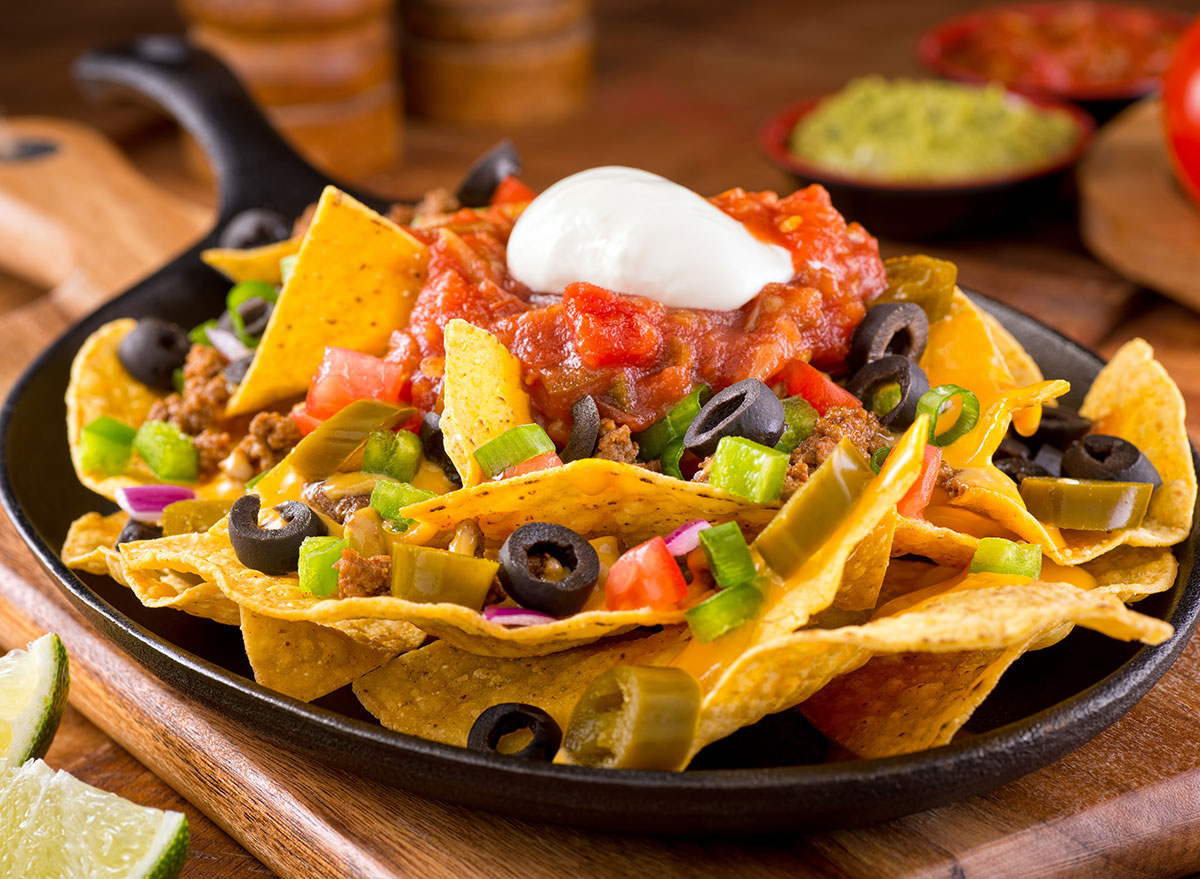
Unhealthy Ingredient: Too much sodium
The basis of nachos consists of tortilla chips, which although not generally all that bad for you, don't provide any sort of nutrients. Then you add on ground beef or pulled pork, sour cream, guacamole, and an unseemly amount of yellow cheese, and you're in calorie and fat overload. And, this unhealthy bar-food staple is often a go-to appetizer at many restaurants. Just take Applebee's for example, whose beef nachos come in at 1,990 calories and over 4,000 milligrams of sodium—which is almost twice your daily limit.
Eat this instead: If you're going to indulge, make sure you do it at home where you can make your own steak or chicken and bean nachos for far fewer calories, fat, and sodium than any you would order at a restaurant. "Don't forget to top your nachos with avocado for a boost of healthy fats," suggests Manaker.
Fish and Chips
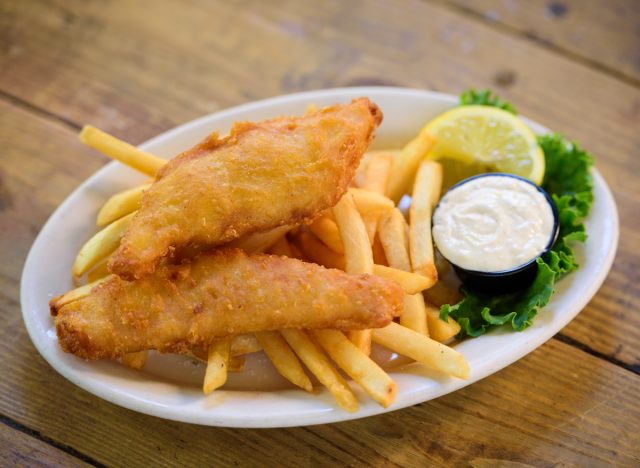
Unhealthy Ingredient: Sodium
Attack of the beige! Whenever your dinner is monochromatic (in this case, the off-brown hue of deep-fried), you know you're in trouble. Don't blame the fish though—the seafood is packed with lean, muscle-building protein and heart-healthy fats. But the trouble here lies with a massively unbalanced fish-to-fat ratio. A coating of crispy batter and a pile of deep-fried potatoes is just loaded with sodium and fat.
Eat this instead: When it comes to seafood, abandon ship on fried fish and opt for grilled instead.
Mozzarella Sticks
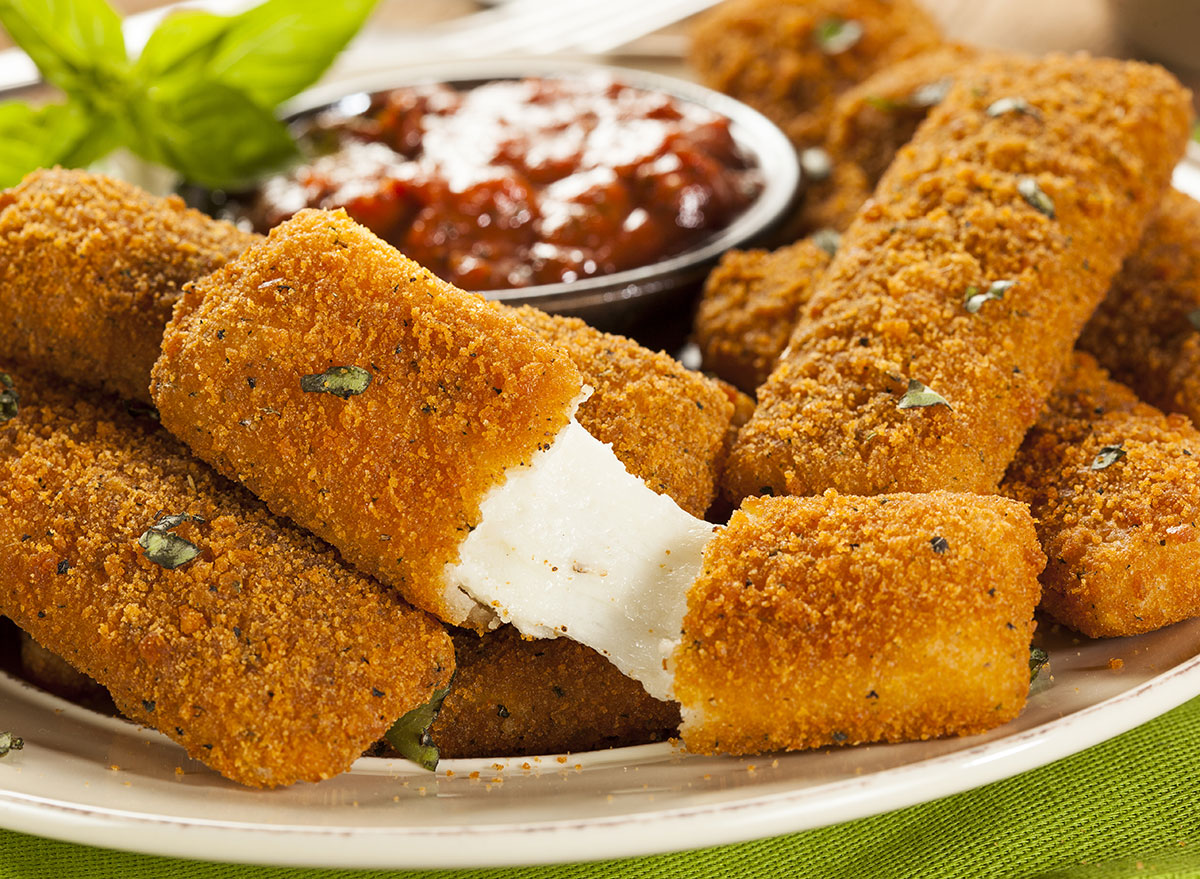
Unhealthy Ingredient: Sodium and saturated fat
Although there is some protein in mozzarella sticks, this popular appetizer choice happens to be fried, and fried foods in particular up the calories, sodium, and saturated fat of everything they encounter. Just look at the mozzarella sticks from Applebee's. This appetizer comes in at 18 grams of saturated fat and 2,450 milligrams of sodium—both of which are above the daily recommended limit.
Eat this instead: Skip the whole breaded and fried aspect and just munch on pure cheese sticks, which you can pair with some grapes or almonds for a filling snack. If you're at a chain restaurant like Applebees, try an appetizer like the bone-in wings (which have only 3 grams of saturated fat and 300 milligrams of sodium) or a house salad.
Restaurant French Toast
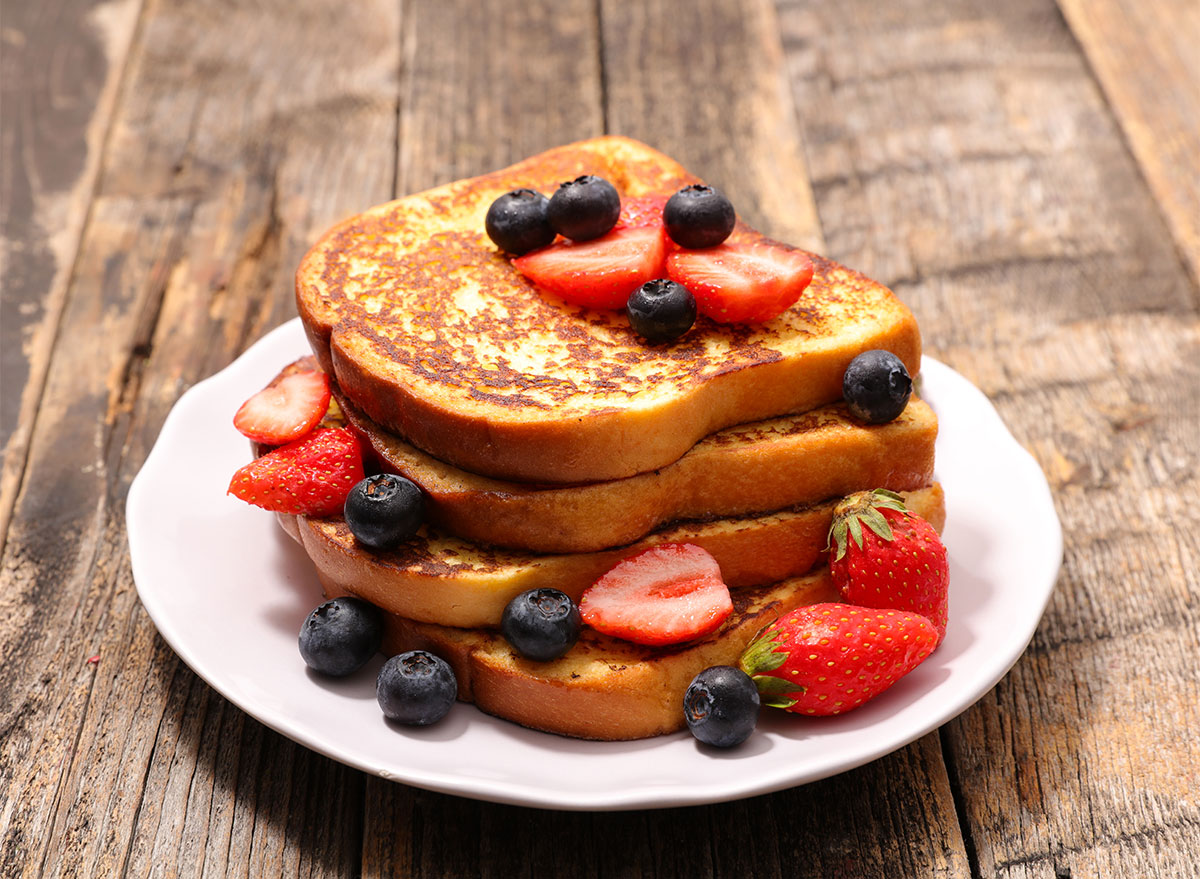
Unhealthy Ingredient: Added sugar
If you make French toast at home, it isn't necessarily all that bad, but ordering this breakfast dish out at a restaurant changes everything, as it just adds more fat, sugar, and salt to a meal already high in these things as it is. Cheesecake Factory's Bruléed French Toast has nearly 2,000 calories, which is about a day's worth of calories in your first meal of the day. It also has a whopping 64 grams of saturated fat (almost five times your daily limit) and 4 grams of trans fat, which is twice the intake recommended by the World Health Organization (WHO). In fact, according to the WHO, larger consumption of trans fats is connected to higher cholesterol and an increased risk of coronary heart disease deaths, heart disease, and all-cause mortality.
Eat this instead: To quell your sweet tooth craving at breakfast, make a smoothie alongside a breakfast sandwich with a side order of eggs. That way your meal will be balanced with fiber, protein, and natural sugars. Or, try your hand at making our French Toast recipe, which only has 370 calories, 12 grams of fat, and 4 grams of saturated fat per serving.
Store-Bought Croissants
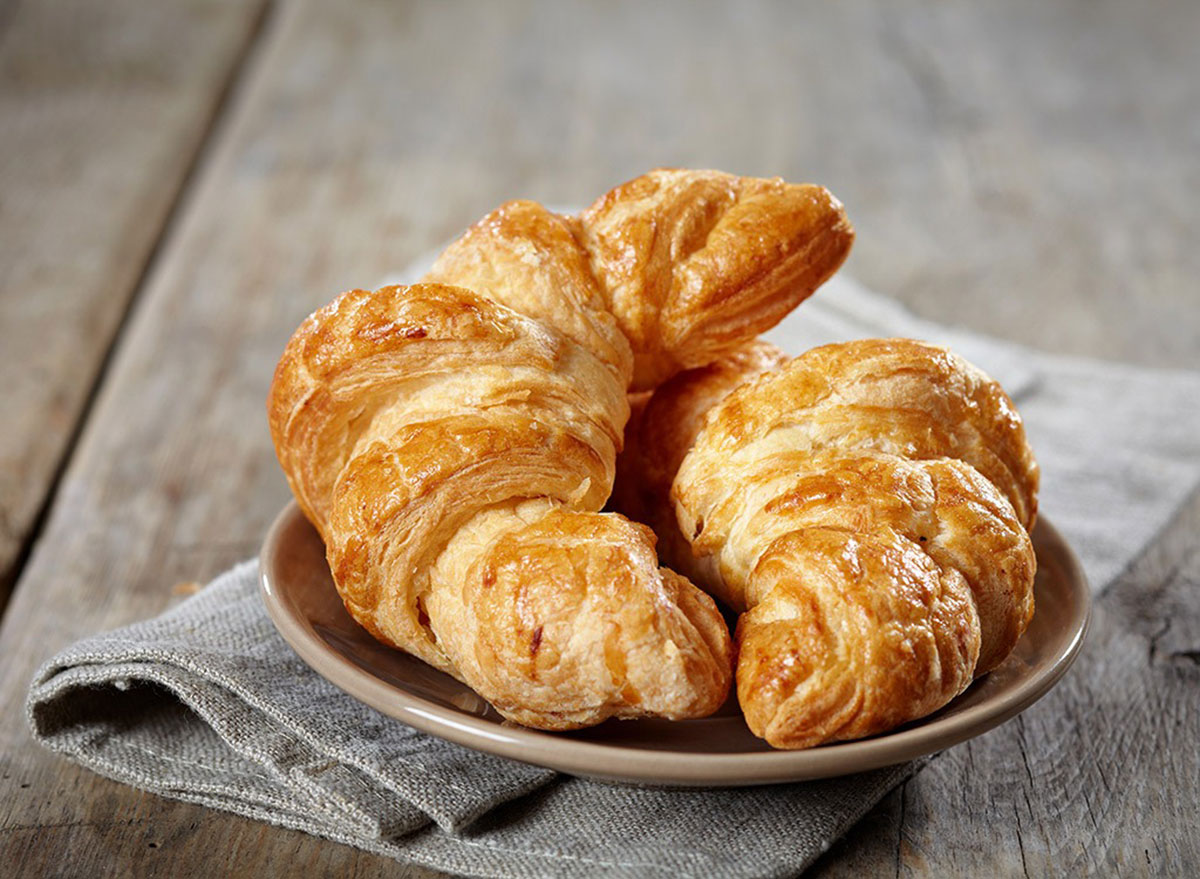
Unhealthy Ingredient: High amounts of butter, sometimes margarine
We know, we know—biting into a buttery, flaky croissant is unlike anything else. But eating this pastry in the morning will give your body a heaping amount of fat and saturated fat, without protein or fiber to help keep you full. Let's look at a plain Butter Croissant from Dunkin' Donuts. It has 19 grams of fat, 340 calories, and 8 grams of saturated fat (which is about 60% of your recommended daily limit), and only 1 gram of fiber and 6 grams of protein. And that's just for the plain one. If chocolate croissants are your go-to, you're looking at consuming upwards of 25 grams of total fat and 16 grams of saturated fat per pastry from Au Bon Pain, which is over your daily limit of 13 grams.
Eat this instead: For a more balanced breakfast that will leave you feeling full throughout the morning, grab some oatmeal instead of a croissant to start your day. Oats have plenty of fiber, and if you add in some fruit, you'll get a boost of antioxidants and even more fiber.
Soybean Oil
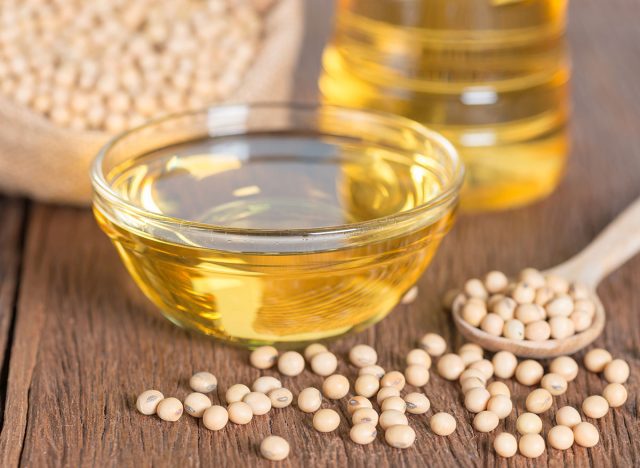
Unhealthy Ingredient: Soybean oil
It's found in so many processed and packaged foods, but soybean oil has gotten some negative attention lately in the nutrition world. Some animal studies claim this oil can be linked to obesity and that it may even affect neurological conditions like Alzheimer's or depression. Studies on the effects of soybean oil on humans are very limited so far, so more research needs to be done.
Eat this instead: When in doubt, it's best to avoid foods that contain soybean oil, which we know, is very hard to do as it seems to be in everything—especially fast food and chain restaurant items. When you're cooking though, there are tons of other oils you can turn to, such as avocado oil or olive oil.
Canned soup
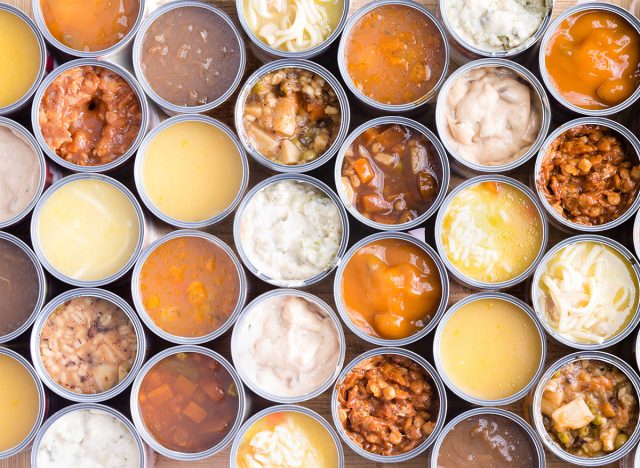
Unhealthy Ingredient: Too much sodium
Typically dubbed a healthy, soothing meal, soup truly is one of the least suspicious diet saboteurs of them all. However, that's not the case with certain canned varieties. Many popular soup brands add excess amounts of salt, and consuming too much salt can cause us to overeat, according to a study published in the Journal of Nutrition.
Some brands like Campbell's Homestyle Chicken Noodle contain 890 milligrams of sodium in just a half cup, but many of us are probably eating more than just half a cup of soup at a time.
Besides disrupting satiety cues, when you constantly flood your system with sodium, you can overwork your kidneys. As a result, the sodium sits in your bloodstream where it attracts water, causing water retention and bloat.
Eat this instead: If you need a quick and easy soup, look for canned options that are lower in sodium. But if you have the time and energy, try making your own soup to be able to better control your ingredients and salt levels.
Bouillon Cubes
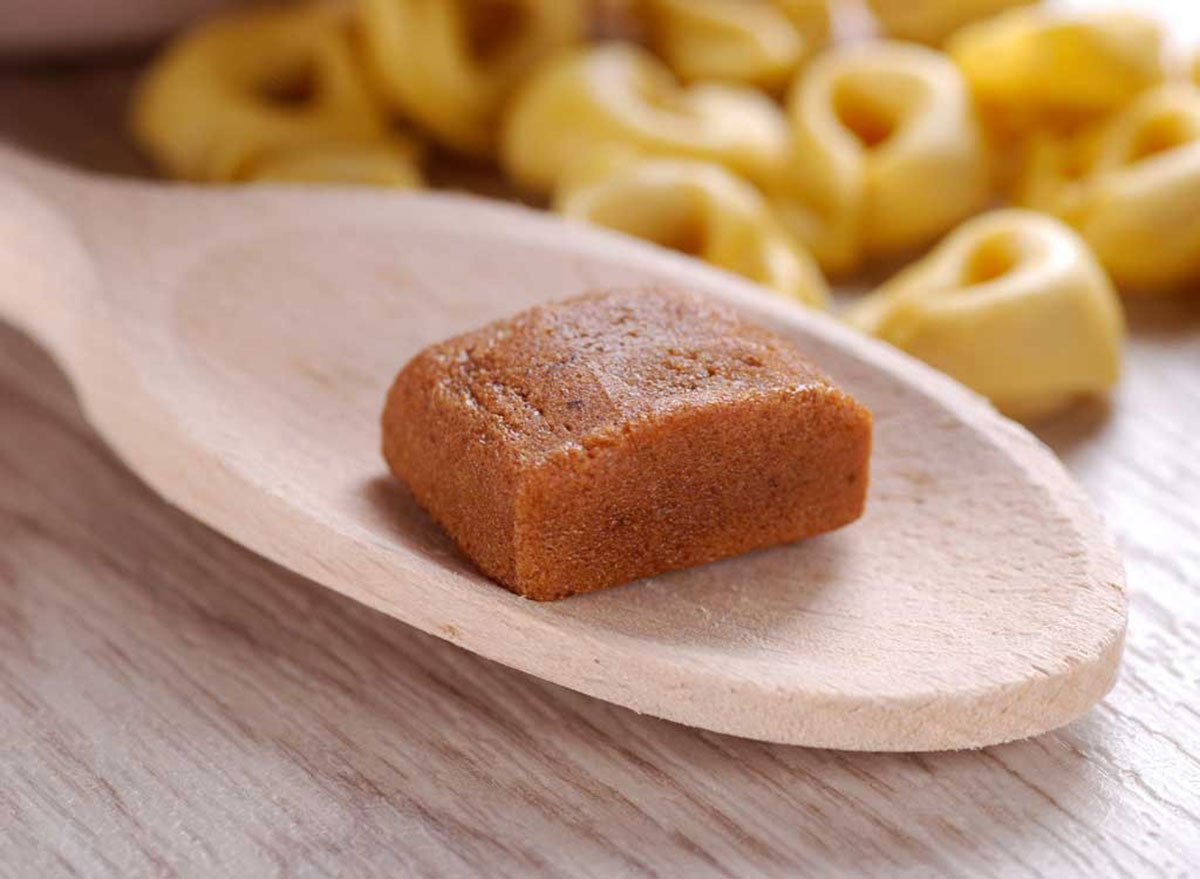
Unhealthy Ingredients: Palm oil, caramel color, Yellow 6
Palm oil, caramel color, and Yellow 6 are just a few of the unsettling ingredients found in a typical bouillon cube, such as Knorr's Chicken Bouillon Cubes. In regards to palm oil, a meta-analysis in the Journal of Nutrition found this specific fat significantly increases low-density lipoprotein (LDL), or bad cholesterol, compared with vegetable oils low in saturated fat. Followed by potentially carcinogen-contaminated caramel color, it's in your best interest to be aware of what bouillon brand you're buying.
Eat this instead: Consider using an organic broth or chicken stock. Separately, Better Than Bouillon Reduced Sodium Chicken Base contains less sodium and fewer additives.
Store-Bought Muffins
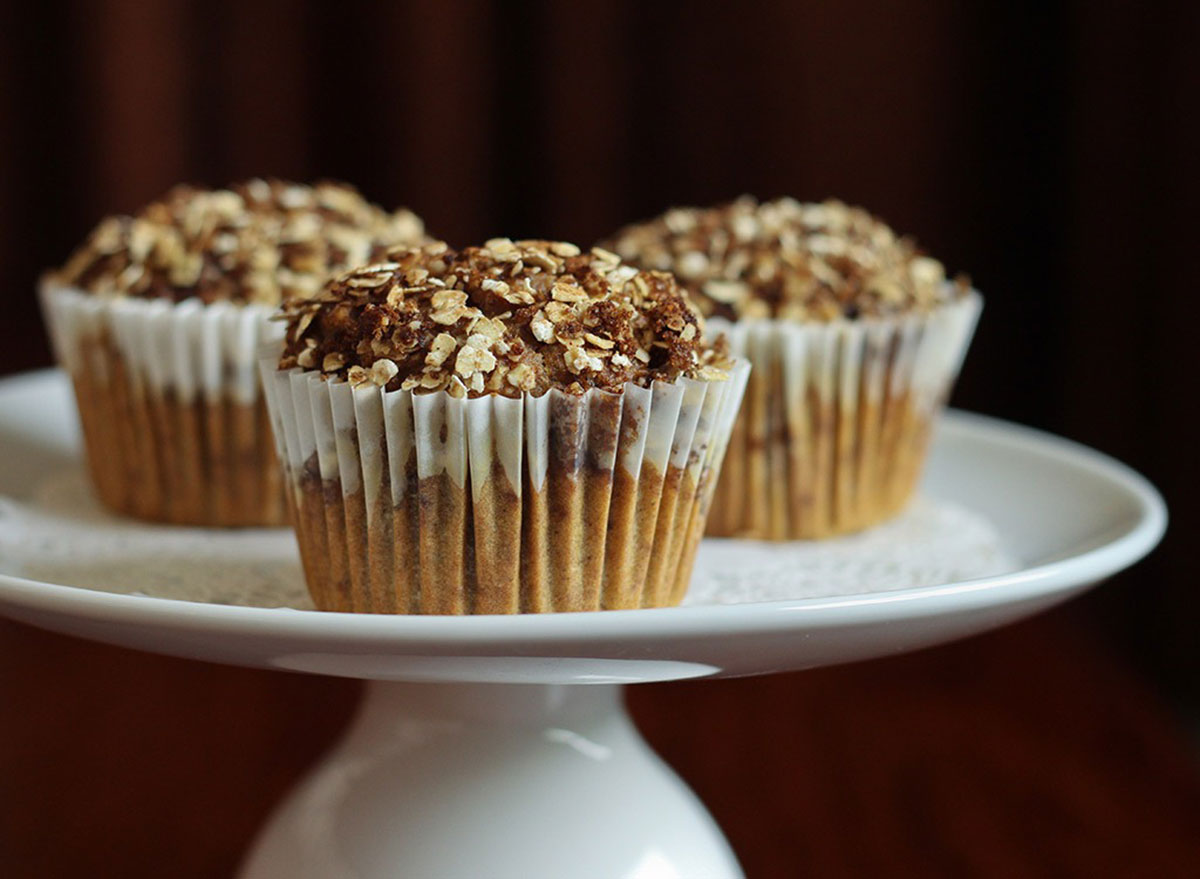
Unhealthy Ingredients: Soybean oil, sugar, mono and diglycerides
Can someone explain to us why a product that's packed in a box marked "Baked Fresh Daily" contains at least two preservatives? Entenmann's isn't the only one with misleading labeling. Otis Spunkmeyer Muffins look healthy, coming in at 210 calories per serving, but then you see there are two servings per muffin. Typically, store-bought muffins contain a lot of calories and fat, and eating half now and "saving the rest for later" is near impossible—likely because foods rich in carbs, fat and sugar can be downright addicting. Plus, many commercial muffins are also spiked with bleached flour, soybean oil, and additives like mono- and diglycerides.
Eat this instead: If you want something quick, easy, and delicious for breakfast, try one of these 5 Healthiest Muffins at the Grocery Store. Or find an easy recipe and make your own at home. You can always save the extra and keep them for a grab-and-go breakfast in the coming week.
Boxed Mac & Cheese
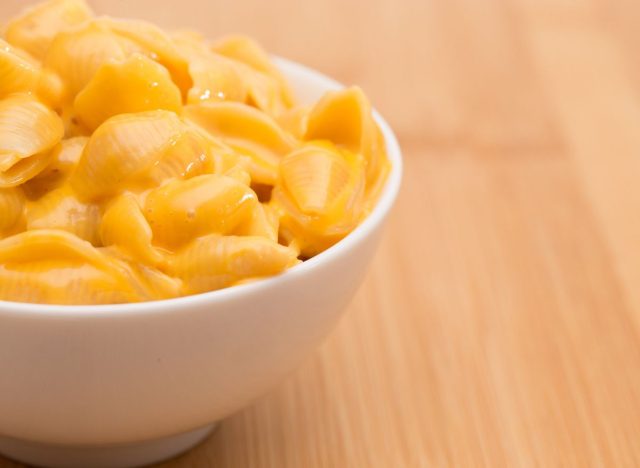
Unhealthy Ingredients: Tons of sodium
If you have it in you to eat a mere 1-cup serving of Kraft's Three Cheese Mac & Cheese, you'd still consume at least 750 milligrams of sodium—and that's not including your salted pasta water or salted butter you add to bring this cheesy concoction to perfection. As prepared, you hit a third of your day's recommended intake of sodium per serving, and if you eat half the box (which is easy to do), you could end up consuming half of your entire day's allotted sodium. High sodium intake is associated with ailments such as hypertension and heart disease, according to the CDC.
Eat this instead: If it's boxed Mac & cheese you're craving specifically, don't worry. Check out some of the Best & Worst Boxed Mac and Cheese, According to Dietitians.
Frozen Pies
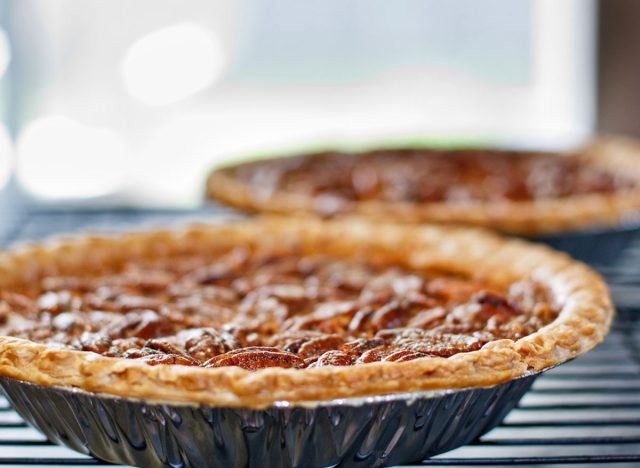
Unhealthy Ingredients: Hydrogenated soybean oil
That pesky ingredient is very much present in frozen pies, especially in Marie Callender's line of apple pies. While there is zero trans fat listed on the frozen desserts' nutrition labels, the presence of soybean oil and hydrogenated soybean oil is still concerning, as this type of oil has been linked to weight gain.
Eat this instead: We'd always go for a homemade pie when we get the chance, but if you're in a time crunch and need to whip up a quick and delicious dessert for you and the family, just make sure that the two words "partially hydrogenated" are missing from your frozen pie's ingredient label.
Hot Dogs

Unhealthy Ingredients: Sodium phosphate, sodium, sodium nitrite
There are plenty of good reasons not to eat hot dogs—their high levels of sodium and carcinogen-producing nitrites are just two—but if you need another, here you go. The BBQ staple is also preserved with sodium phosphates: a food additive linked to potential health consequences. Studies have connected high levels of serum phosphates (due to dietary consumption) to higher rates of cardiovascular disease and chronic kidney disease.
Eat this instead: If you're jonesing for a juicy dog, opt for an organic, uncured option like Applegate Farms' Great Organic Uncured Beef Hot Dog.
Deli Meat
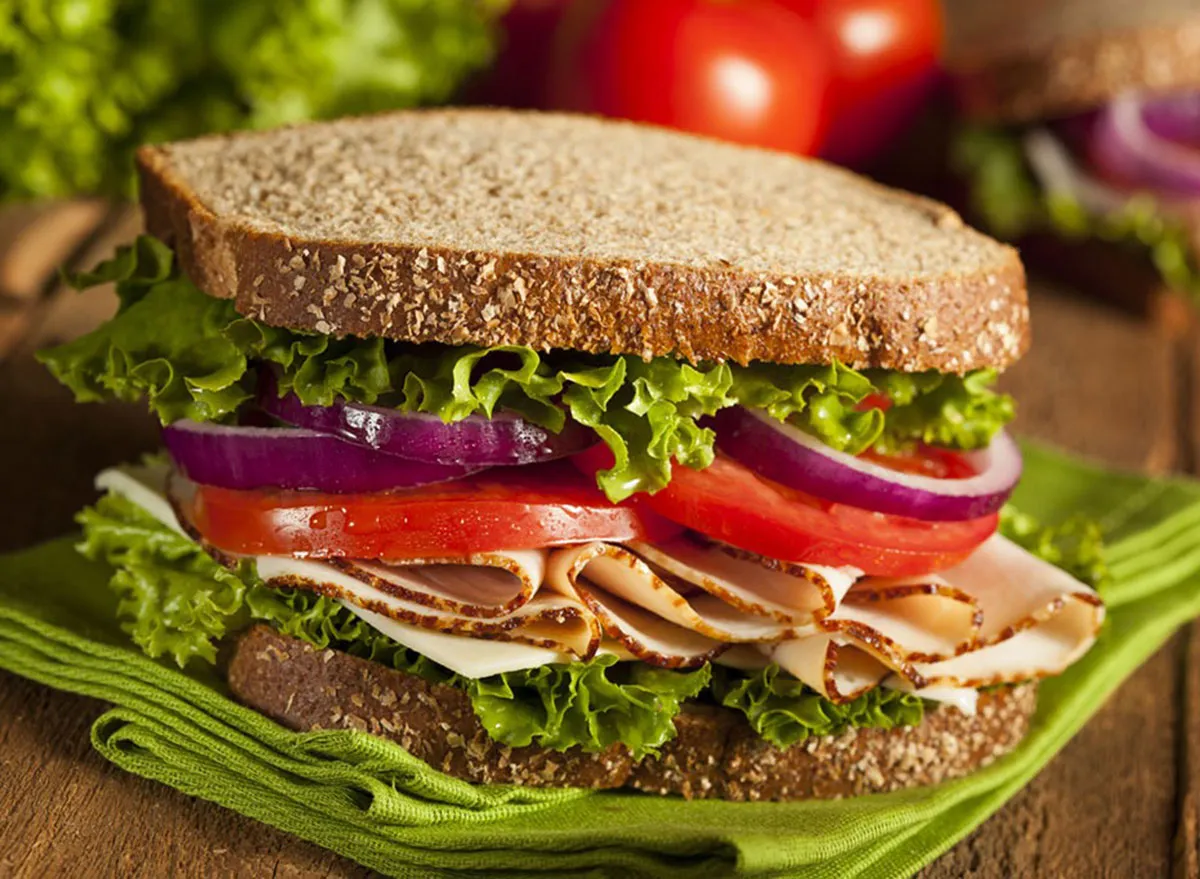
Unhealthy Ingredients: Excess sodium
The deli meats you use to make your lunch may be putting your life at risk. How? Because these processed meats are loaded with sodium and preservatives. For example, a 2-ounce serving of Boar's Head Smoked Turkey has 500 milligrams of sodium—but many of us will easily go past this small serving when making ourselves a sandwich, which can increase our sodium intake even more. And, a diet high in sodium puts many at risk for high blood pressure (hypertension) and heart disease, and with the average American consuming 3,400 milligrams of sodium each day according to the American Heart Association, you should try to choose lower-sodium options whenever they are available. Along with the sodium, many deli meats like this Boar's Head option are made with sodium phosphate—a common food additive known to potentially increase serum phosphate levels in the body, which can increase cardiovascular risk factors over time.
Not only that, but research has shown a connection between higher consumption of processed meat in general (deli meat included) and diseases like diabetes, heart disease, and certain cancers.
Eat this instead: The American Institute for Cancer Research (AICR) recommends avoiding processed meats as much as possible and suggests focusing on fresh poultry, as well as nut butter or hummus that you can throw on a couple of slices of bread.
"If you simply must have your classic turkey sandwich or other deli meat sammie, Prime Roots is a meat-free deli alternative made from Koji culture for a gut health-supporting option free from synthetic nitrates or nitrites," says Manaker.
Instant Oatmeal Packets
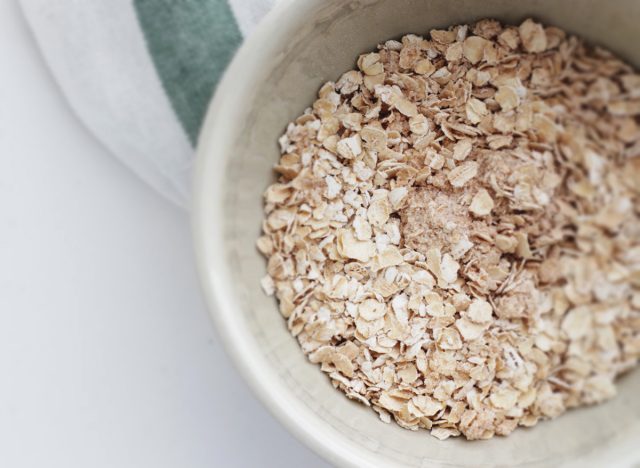
Unhealthy Ingredients: Sodium, added sugar
If you pick up an instant oatmeal packet like Quaker Raisins & Spice, you'll end up consuming much more sugar and sodium than you would by just making your own plain oatmeal and adding your toppings. The Quaker instant oats have 14 grams of sugar and 8 grams of added sugar, which is a lot to consume first thing in the morning, especially because if you were to make your own oatmeal and add fruit for sweetness, you'd be able to avoid these added sugar levels.
Eat this instead: Again, we recommend making your oatmeal at home because this is the best way to make sure you have complete control over your ingredients and toppings. But if you prefer being able to throw a packet in the microwave," look for a sugar-free option, like Bob's Red Mill Organic Classic Oatmeal Cups, and top it with fresh berries and a sprinkle of cinnamon for some added sweetness," suggests Manaker.
Candy
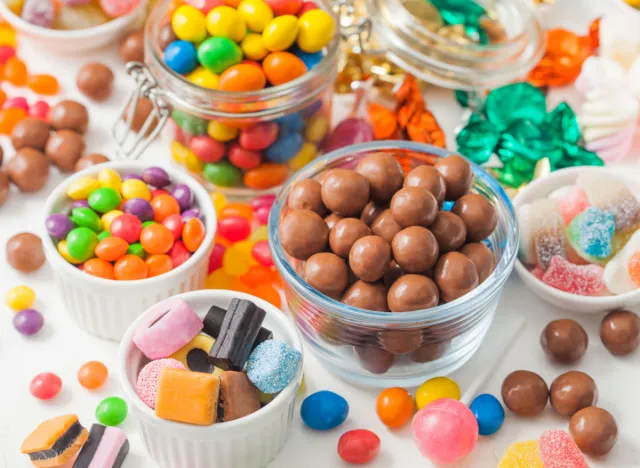
Unhealthy Ingredients: Artificial coloring, added sugar, saturated fats
You already knew all the artery-clogging fats and addicting sugars in candy weren't doing you any favors, but you likely didn't realize that certain candies can make it more difficult for your little ones to concentrate. A few years ago, researchers discovered that the artificial colors, Yellow No. 5 and Yellow No. 6 (found in M&Ms), may promote Attention Deficit/Hyperactivity Disorder (ADD) in children.
Eat this instead: M&M fans should check out Unreal's Milk Chocolate Gems. It's a similar taste and feel, but it's free of all the ingredients that many of us are trying to avoid. "They are 'colored by nature,' not by artificial colors," says Manaker.
Boxed Cake Mixes
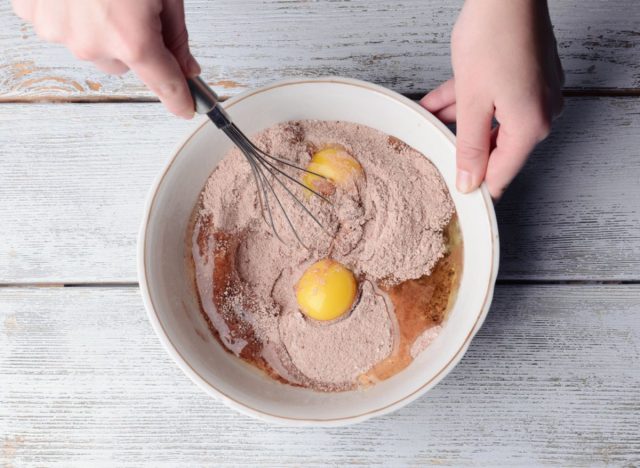
Unhealthy Ingredients: Artificial flavors and artificial colors
Nothing says "Happy Birthday!" like a slice of sugary, chemical-laden cake, right? Whipping up a cake from a box is much easier than gathering all the ingredients and baking it from scratch. But taking this shortcut could cost you in the health department. The Duncan Hines Yellow Cake Mix, for example, comes packed full of questionable ingredients like Red 40, Yellow 6, sodium phosphate, and palm oil, just to name a few. These chemicals are nothing to celebrate.
Eat this instead: We know it may feel like a pain, but your best bet is to make cake at home from simple ingredients like flour, sugar, eggs, etc. If you simply must have a boxed mix, you can opt for something like the Madhava Super Yummy Yellow Cake Mix. This one still contains a few additives, but it has much less than the Duncan Hines version.
Pre-Packaged Baked Goods
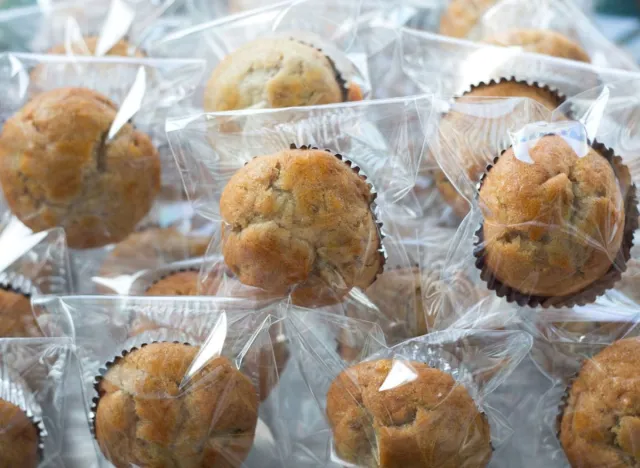
Unhealthy Ingredient: Potassium bromate (bromated flour)
Banned in the United Kingdom and Canada, potassium bromate is still lurking in some U.S. foods such as pizza, wraps, rolls, bread crumbs, and bagel chips, according to a 2015 analysis by the non-profit Environmental Working Group (EWG). The issue? A 1982 study found the dough strengthener induced tumors in rats and led the EPA to conclude bromate is a "probable human carcinogen." The Office of Environmental Health Hazard Assessment has also placed this ingredient in the carcinogen category.
While the FDA encouraged bakers to voluntarily stop using it in 1991, the EWG found evidence of it lurking in 86 different baked goods products, including GOYA dough and Fresh Daily Nutmeg Bread.
Eat this instead: This will take a little investigative work on your part, but take a moment to scan the ingredients list next time you're at the market. If you pick up a package with potassium bromate or bromated flour on the label, you may be better off opting for an alternative treat.
Bottled Water
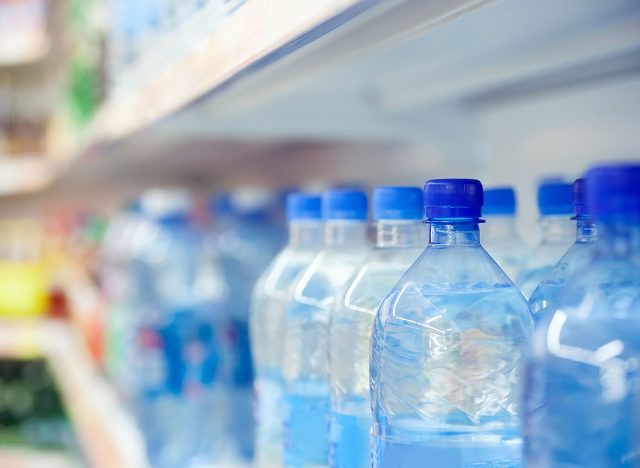
Unhealthy Ingredient: BPA (Bisphenol-A)
BPA is a hormone-mimicking chemical found in nearly all food packaging plastics (including water bottles), and it's potentially bad news. According to a study in the International Journal of Endocrinology, chronic ingestion of this chemical can lead to a variety of hormonal changes and fertility issues, such as cryptorchidism, certain cancers, testicular health issues, as well as decreased fertility in males. "This may be more of a concern if the water bottle becomes hot," says Manaker. "But this should not sway people away from drinking water."
Drink this instead: Join the increasing amount of people who want to stay hydrated and healthy by pouring filtered water into a metal flask or non-BPA bottle. "For a pre-packaged water option sans plastic, Liquid Death is going to be your best bet," says Manaker.
Dried Fruit Snacks
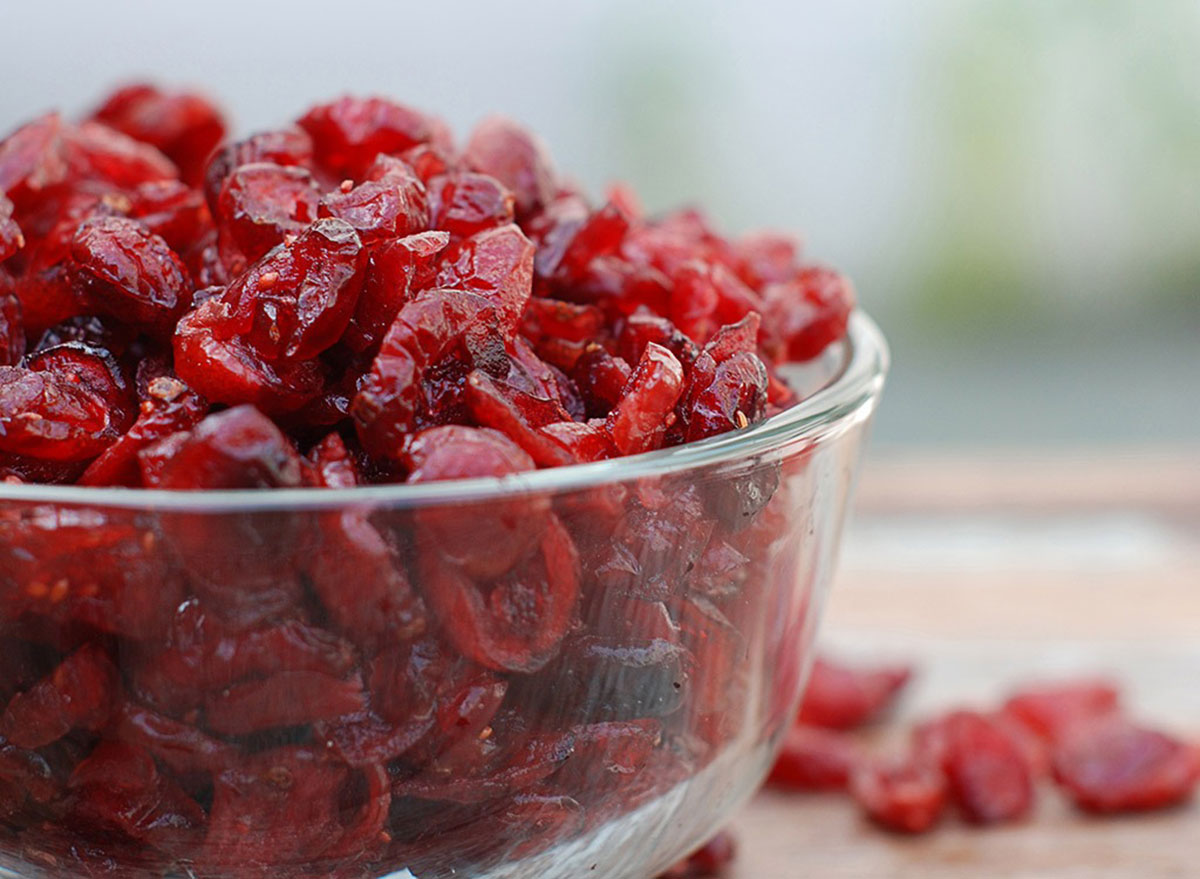
Unhealthy Ingredients: Sulfites, added sugars, or fruit juice infusions
Sulfites, which are used to keep prepared foods fresh, are often used in dried fruit snacks. According to some research, asthmatics may be at an elevated risk for a reaction to sulfites (though anaphylaxis and life-threatening reactions are rare). You should also watch out for dried fruits that have added sugars. "Dried cranberries are notorious for having additional sweet stuff added to the mix," says Manaker.
Eat this instead: Look for dried fruit that either says "sulfite-free" or "unsulfured"—like these Organic Dried Figs.
American Cheese
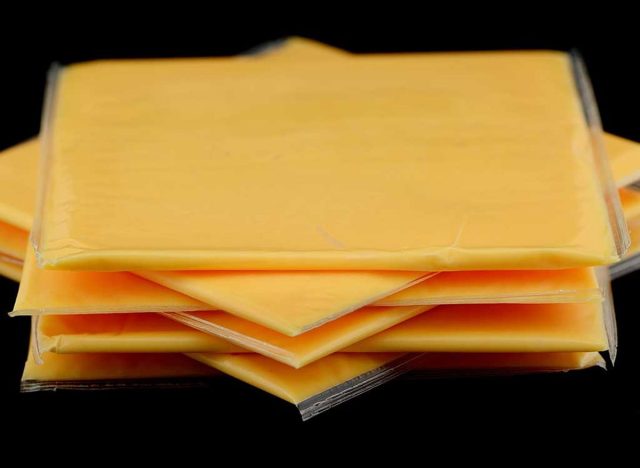
Unhealthy Ingredients: Sodium citrate and phosphate
That brick of orange cheese sitting in the dairy case at your supermarket is more than just a flavorless lump of dairy-ish ingredients —it's usually loaded with icky additives, too. While many companies are thankfully opting for natural colors to give their cheese that trademark orange hue, they're still loading those slices with ingredients that can seriously harm your health.
For instance, Kraft Singles contain sodium phosphate, an ingredient used to prevent the crystallization of meat and dairy products, which has been linked to an increased risk of bone demineralization, osteoporosis, and kidney health issues.
Eat this instead If you can't fight your cheese cravings, opt for an organic cheese that's made without preservatives or artificial colors. If you're trying to be particularly gentle with your body, opt for an aged white cheddar or parmesan —they're the cheeses with the lowest lactose levels, which make them the least likely to cause digestive distress.
'Wheat' Bread That Isn't 100% Whole Grain
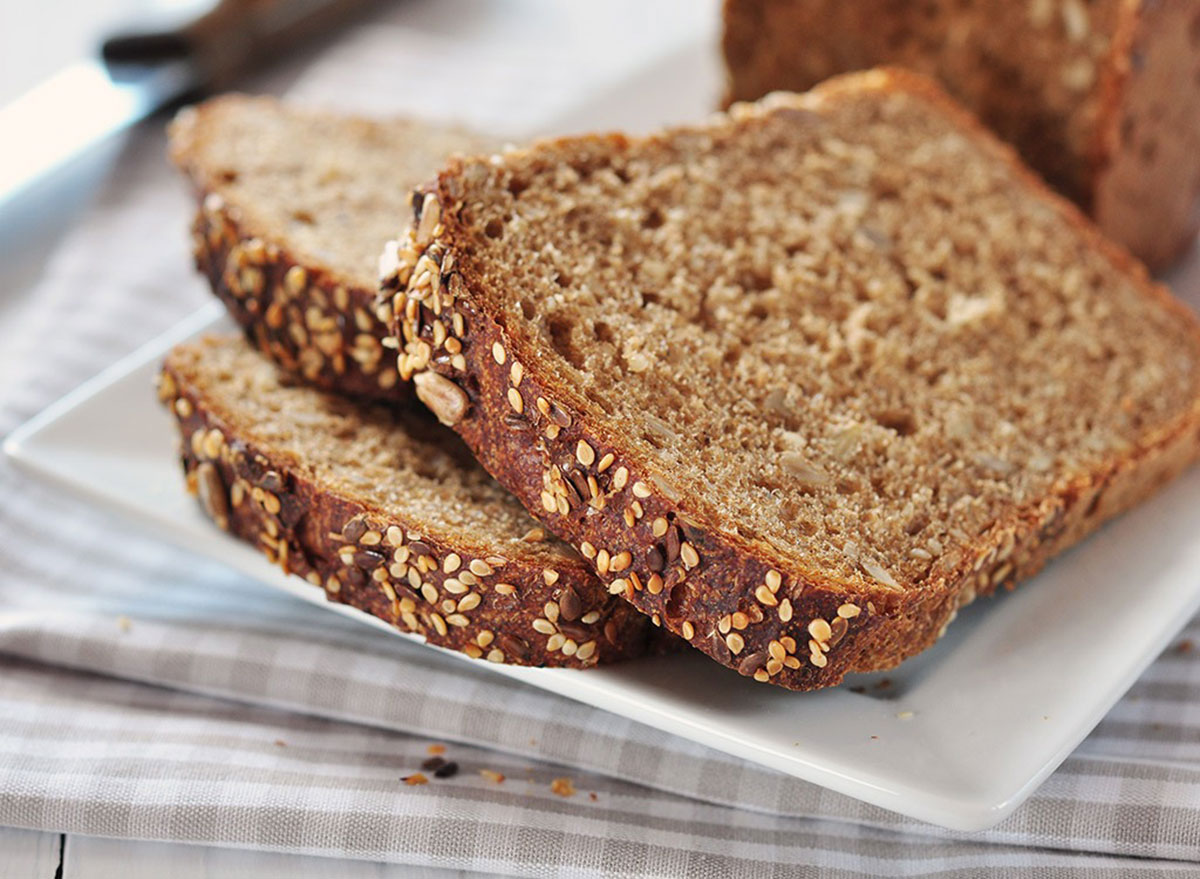
Unhealthy Ingredients: Sugar, refined white flour
Unless it says 100% Whole Wheat, don't be fooled into thinking your "wheat" bread is that much better for you than the white version. Most loaves contain a small amount of actual whole grains mixed with unhealthy refined flour.
Take Bimbo Bakery's Made With "Whole Grain" White Loaf as an example. It says "Made With Whole Grain" on the front, and by that, they mean whole grain flour is listed as the third ingredient: behind regular old white flour and water.
What's even more surprising to us is that this two-slice serving has 2 more grams of sugar than Bimbo's Soft Wheat Bread. That's because manufacturers often increase the amount of added sugar in bread made with whole grains. After all, consumers still look for that sweet taste of white bread with the "healthy" feeling of eating whole grains.
Another example is Nature's Own Honey Wheat, which contains "unbleached enriched whole wheat flour" but it isn't 100% whole wheat.
Eat this instead: To ensure you're picking a healthier bread full of actual whole grains and whole wheat, we suggest something like the Ezekiel 4:9 Sprouted Grain Bread.
Foods Coated with Artificial Chocolate

Unhealthy Ingredient: Polysorbate 60
Short for polyoxyethylene-(20)-sorbitan monostearate, this emulsifier is widely used in the food industry. Made of corn, palm oil, and petroleum, this gooey mix can't spoil, and it often replaces dairy products in baked goods. It's commonly contaminated with 1,4 dioxane, a chemical that has been shown to cause cancer in animals and could be toxic for humans as well, according to the CDC.
Eat this instead: Foods coated with real chocolate, like one of these 13 Chocolate Brands That Use the Highest Quality Ingredients.
Shelf-Stable Pickles
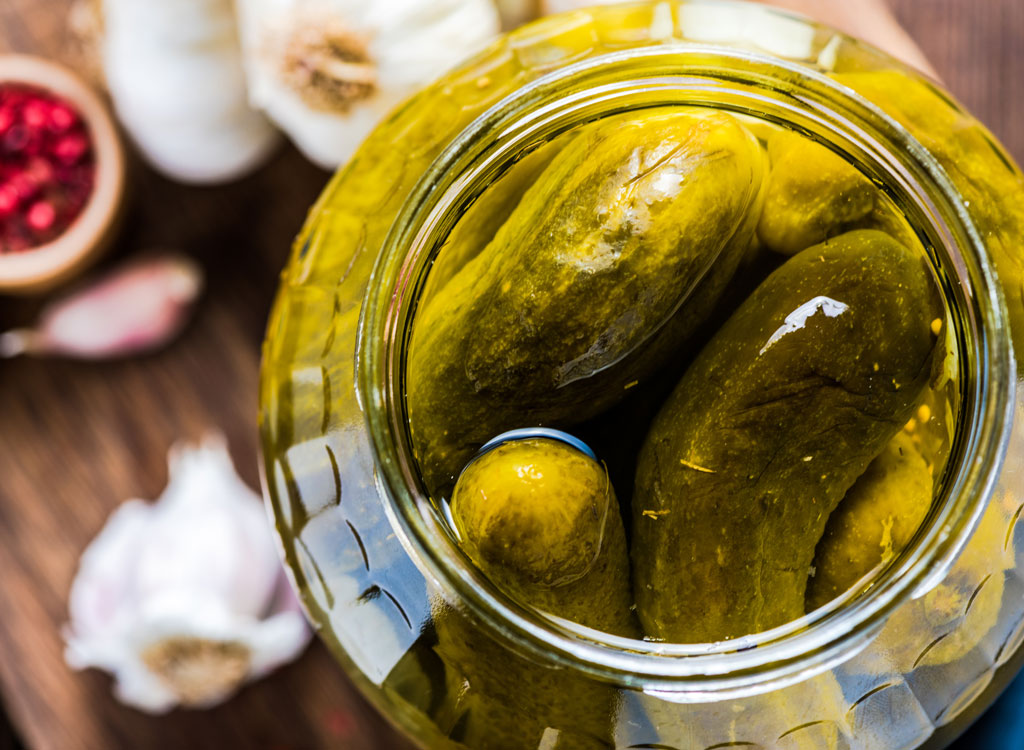
Unhealthy Ingredients: Polysorbate 80, sodium benzoate, sodium
Vlasic uses polysorbate 80 in their Kosher Dill Spears, the same emulsifier used in some diet ice creams that have been linked to causing cancer in mice. Additionally, several pickle jars are also filled with sodium benzoate, which has been linked to possibly increasing inflammation in the body. Additionally, it's important to monitor how much sodium is used in your favorite pickles, because this can quickly add up depending on which brand you choose.
Eat this instead: You don't have to go too far out of your way to find pickles without this additive. For example, Woodstock Farms Organic Baby Kosher Dill Pickles don't have benzoate or polysorbate on their ingredients list.
Chewing Gum
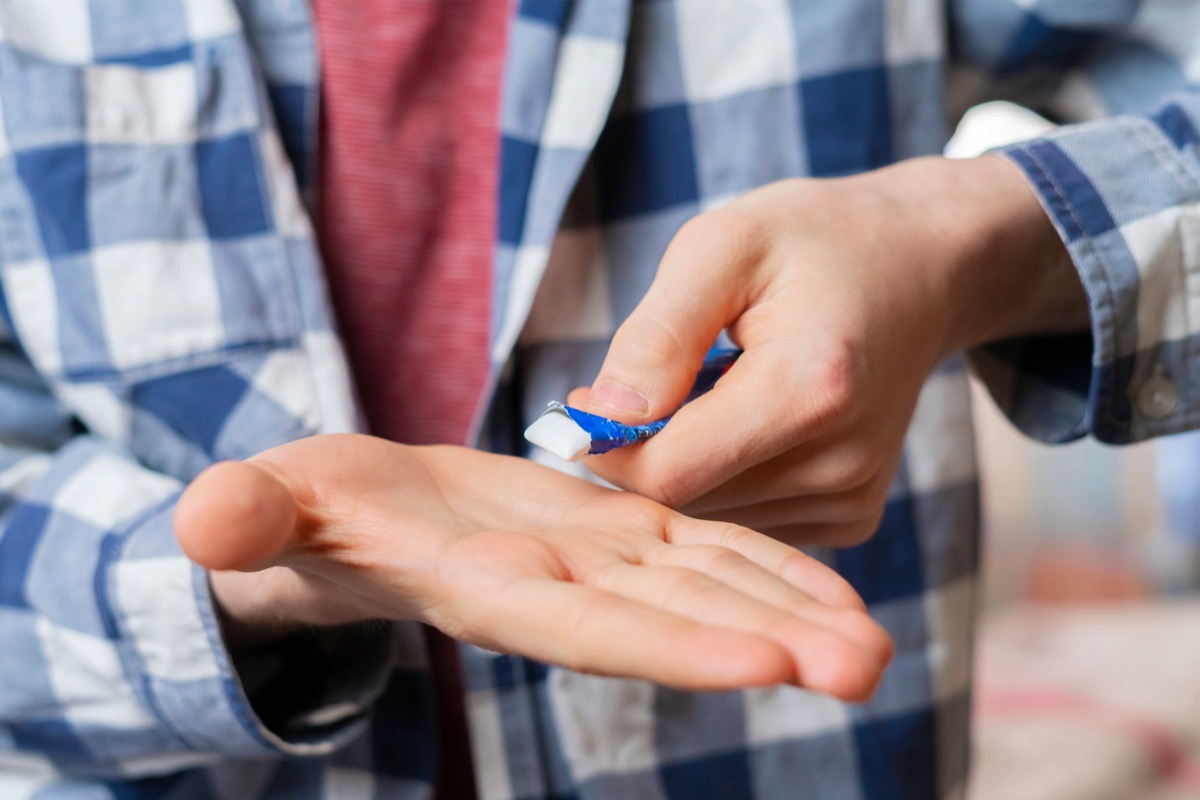
Unhealthy Ingredient: Sugar alcohols, artificial sweeteners
If you don't swallow it, can chewing gum count as food? Kinda. The point is this: Although the bulk of gum is indigestible, some ingredients are, like sugar alcohols and artificial sweeteners. Sugar alcohols are sugar substitutes that have been shown to cause bloating and other gastrointestinal distress. Sorbitol, in particular, takes a relatively long time to digest, and any undigested sugar alcohol in your small intestine acts as the perfect environment for the fermentation of bacteria, thus, causing even more bloating and flatulence. As for artificial sweeteners found in popular gums, you're looking at ingesting additives that have been scientifically shown to trigger your sweet receptors and increase hunger—hence another reason why you're always hungry.
Eat this instead: If you've got a chewing habit, try sunflower seeds. Not only are they tasty, but they are also an excellent source of vitamin E, the body's primary fat-soluble antioxidant.
Reduced-Fat Peanut Butter
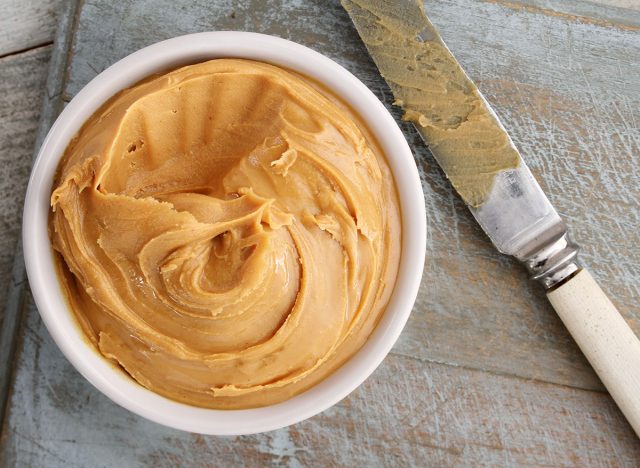
Unhealthy Ingredients: Added sugar
Don't let its reduced fat content fool you: low-fat peanut butter is in no way a healthy food, and certain brands can make this one of the unhealthiest foods you can snack on. While peanuts on their own are a good source of protein and fiber, the other ingredients used in low-fat peanut butter will have you running for the hills. When the naturally occurring fats are stripped from peanut butter, they're often replaced with tons of sugar and excess salt to make up for what would otherwise be a bland and flavorless product. Take Skippy Reduced Fat Peanut Butter for example. This product has less fat, but it has 4 grams of added sugar per serving, and corn syrup solids are its second ingredient.
Eat this instead: Skip all the added sugar and enjoy some full-fat, natural peanut butter instead. Spread the Love brand peanut butter is made without added salt, sugar, or oils, and has all the cholesterol-lowering MUFAs that you get from peanuts in their natural state. Peanut butter is also incredibly easy to make on your own: throw some peanuts and a little bit of oil or honey, as per your taste, into a blender and puree until smooth.
Sugar-Free Chocolate
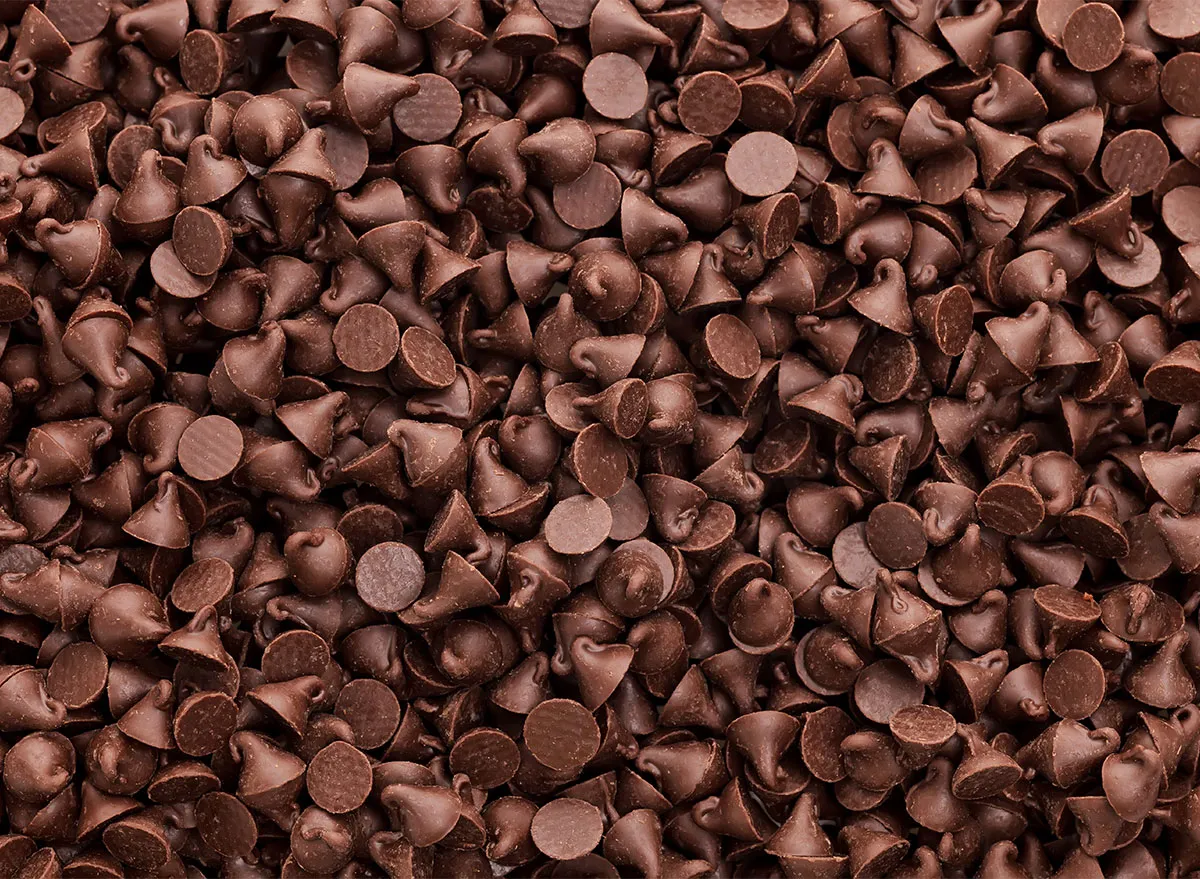
Unhealthy Ingredients: Sucralose, maltitol, additives, palm oil
It's completely understandable if you're trying to reel in your sweet tooth a bit—just don't use sugar-free sweets as a crutch. Instead of sugar, manufacturers (like Russell Stover) add artificial sweeteners like Splenda and sugar alcohols like maltitol. You'll also find a mixture of palm oil and hydrogenated palm oil, as well as a cocktail of additives like potassium sorbate, Sodium benzoate, and sorbitol.
Eat this instead: If you're looking for a treat that will make your taste buds sing—and not send you running straight for the bathroom—skip this bar and check out a dark chocolate bar instead.
Instant oatmeal cups
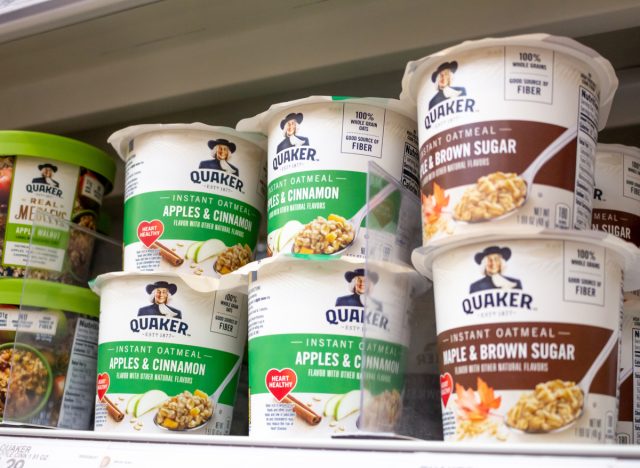
Unhealthy Ingredients: Sugar
Oatmeal, a food so innocent, can, unfortunately, be corrupted. But with what, you ask? A whole lot of sugar. And it's even worse in the new way brands are packaging instant oatmeal: with cups! Even though these instant cups are convenient and require fewer steps to make, they are more often than not full of sugar. Even seemingly healthy options like McCann's Steel Cut Irish Oatmeal Vanilla Honey packs 17 grams of added sugar into one serving. That's 70% percent of the recommended intake of added sugars for the entire day for women, and over 47% for men—and it's not even noon!
Eat this instead: Start your morning off on the right foot by opting for some unflavored oats instead, "like Bob's Red Mill Organic Classic Oatmeal," says Manaker. Not only will this save you some serious calories, but it also lends the possibility of adding healthy, filling ingredients, like raw almonds and fruit, to your recipe instead.
Bottled Lemonade
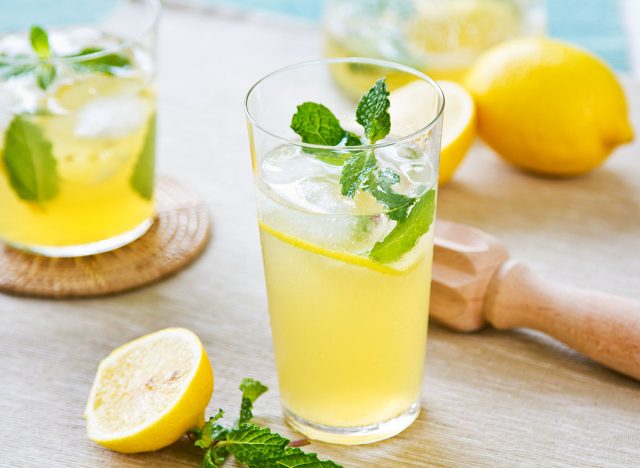
Unhealthy Ingredients: Sugar, high fructose corn syrup, and yellow #5
Beyoncé's Lemonade? Great. Pretty much every other kind of lemonade? Mostly garbage. On top of the boatload of sugar that's in most lemonade recipes, brands like Minute Maid give their bottled and canned lemonade drinks a vibrant hue by using yellow #5, which has been linked to hyperactivity and impaired renal function in animal test subjects. Not to mention that water and high fructose corn syrup are the first two ingredients, followed by lemon juice from concentrate, which certainly explains the 27 grams of added sugar per bottle.
Eat this instead: Opt for some infused lemon water with a small amount of sweetener instead, and you'll save yourself a huge number of calories and a ton of added sugar. "You can also DIY your lemonade and use allulose or Stevia as a sweetener instead," says Manaker.
Sprinkles
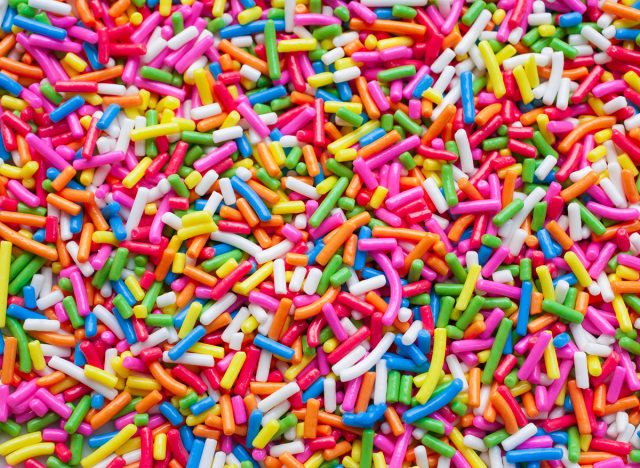
Unhealthy Ingredients: Sugar, artificial colors, carnauba wax
You know those scented candles that smell so delicious you almost want to take a bite? That's pretty much what you're consuming when you add some sprinkles to your ice cream. These small sugary ice cream accessories are little more than sugar, artificial colors, and actual wax, just like your favorite candle. Take the Betty Crocker Rainbow Sprinkles as an example. Not only are there 18 grams of added sugar in just two tablespoons, but these delicious decorations are made with Red 40, Yellow 5, Yellow 6, and Red 3.
Eat this instead: Give your favorite frozen treat a little bit more texture and flavor by adding some slivered almonds or cacao nibs. Not only will they make your ice cream more pleasing to your palate, but they'll also add some healthy fiber and antioxidants to your snack. If you're truly craving sprinkles, try a more natural brand like Rainbow Softies Natural Sprinkles. They're lower in sugar and free of artificial coloring, but they're unfortunately still made of wax.
Maraschino Cherries
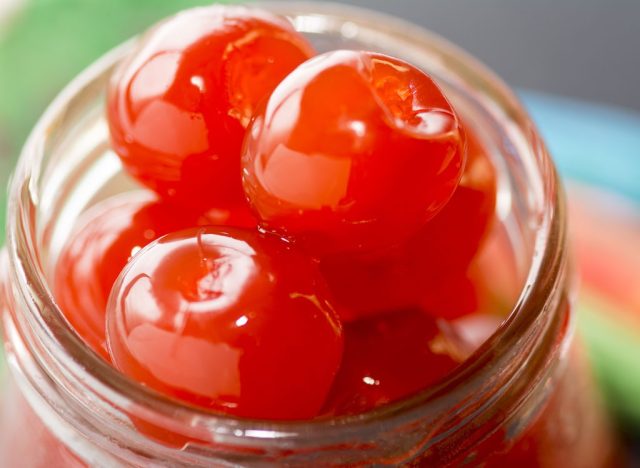
Unhealthy Ingredients: Sulfur dioxide, calcium chloride, sodium benzoate, potassium sorbate, high fructose corn syrup, red #40
Mix up some preservatives, corn syrup, and dyes and you've got… a sundae topping or addition to your favorite cocktail. Maraschino cherries, known for their vibrant hue and perplexing flavor, are an engineered food that has no place in a healthy diet. When you consider that they can last up to three years in their high fructose corn syrup bath before they even get near their expiration date, you'll want to put them back on the shelf.
Eat this instead: Instead of pulling a syrupy, radioactive-looking cherry out of a jar, try getting it the old-fashioned way: from nature. Cherries are plenty sweet on their own, and even without the aesthetic benefit of potentially toxic dyes, they've already got a very pretty color to them. Cherries are also a good source of resveratrol, which can help fight excess abdominal fat and may even help fend off dementia.
Fruit-on-the-Bottom Yogurt
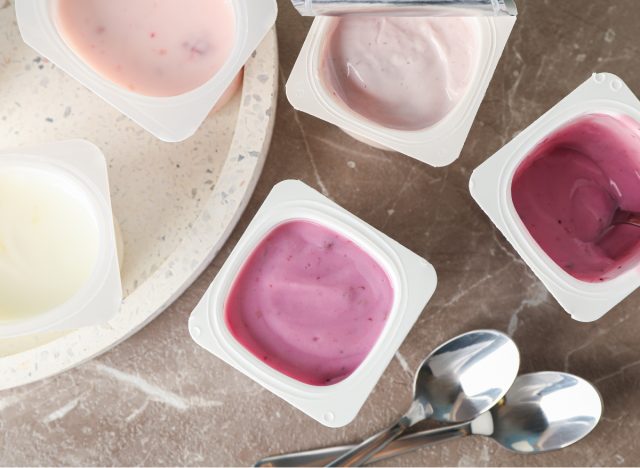
Unhealthy Ingredients: Excess sugar and a lack of protein.
All those smiling models in yogurt commercials haven't checked out the ingredients list on their purportedly healthy snacks. Most fruit-flavored yogurts on the market contain very little actual fruit, sweetening their recipes with sugar instead. And those brilliant hues you thought were the result of fresh fruit in the recipe? They're usually just from fruit juice concentrate. With this added sugar and very little protein, yogurts like these will just leave you feeling hungry.
Eat this instead: While sugary, flavored yogurts are not the best choice, there are many yogurt options low in sugar and higher in protein. Plain, unsweetened yogurt is full of live cultures that can benefit your gut bacteria and boost your immune system. Greek or Icelandic yogurts are also great options because they're naturally higher in protein.
Bottled Coffee
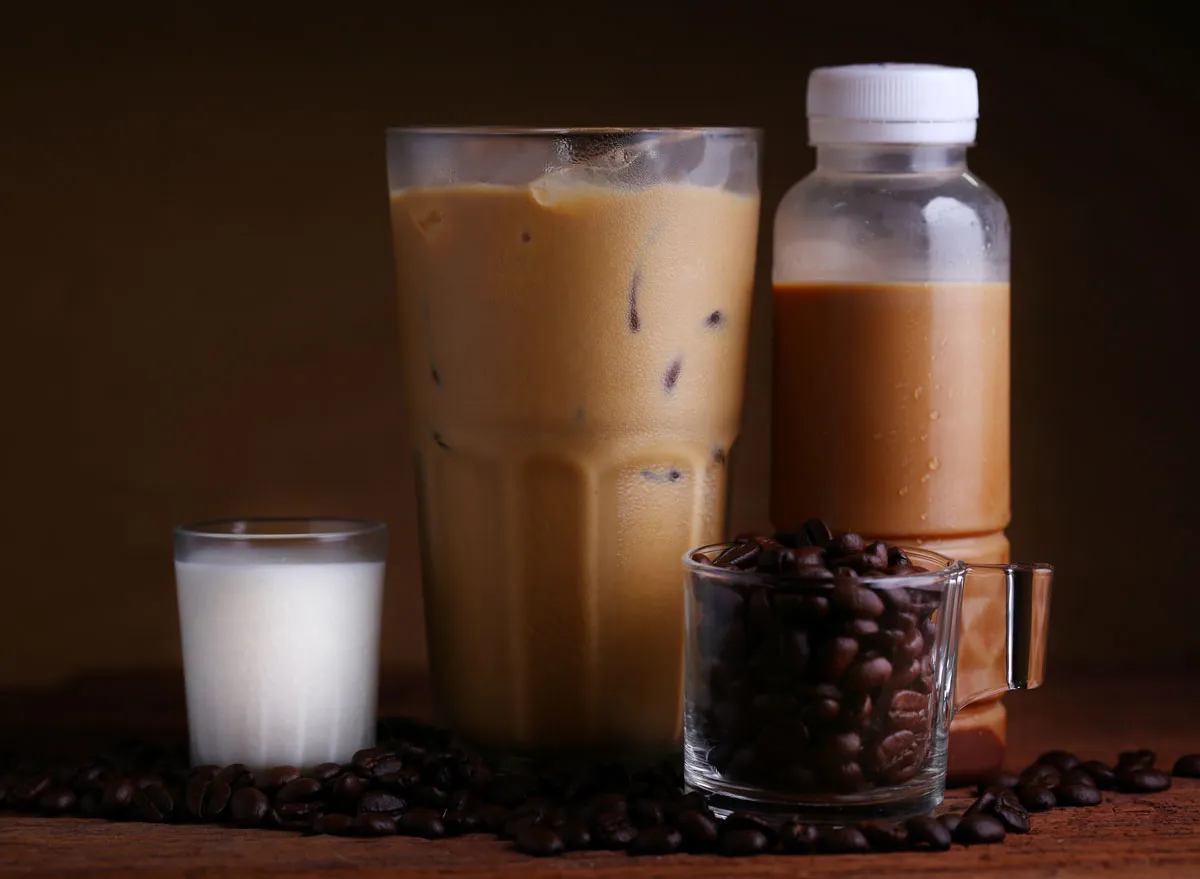
Unhealthy Ingredients: Sugar
When reaching for a bottled coffee beverage, you're probably more concerned with how under-caffeinated you're feeling and less about what could be lurking under that label. Unfortunately, some of these sickly sweet drinks are loaded with more added sugars than you should consume in an entire day.
For example, one 14-ounce bottle of Gold Peak Almond Toffee Coffee Drink contains a staggering 270 calories and 53 grams of sugar. Another shocker? The whole bottle only dishes out 77 milligrams of caffeine, which is significantly less than the 166 milligrams you'd get for an equal serving size of black coffee. Other popular drinks, such as the bottled version of the Starbucks Coffee Frappuccino, are nearly as bad, doling out 34 grams of sugar and 300 calories per bottle.
Drink this instead: Keep the convenience and toss out all the added sugar by opting for cold brew instead. This refreshing pick-me-up skips those high-calorie ingredients and gets you more of what you really want: sweet, sweet caffeine. Fortunately, ready-to-drink cold brew is becoming more widely available, with companies like Chameleon, Blue Bottle, Stumptown, and High Brew offering their flavorful, antioxidant-rich coffees in convenient to-go bottles and cans. If you don't like your coffee black, add in a little bit of your favorite creamer and sweetener, which gives you the ability to control how much you want.
Water Enhancers
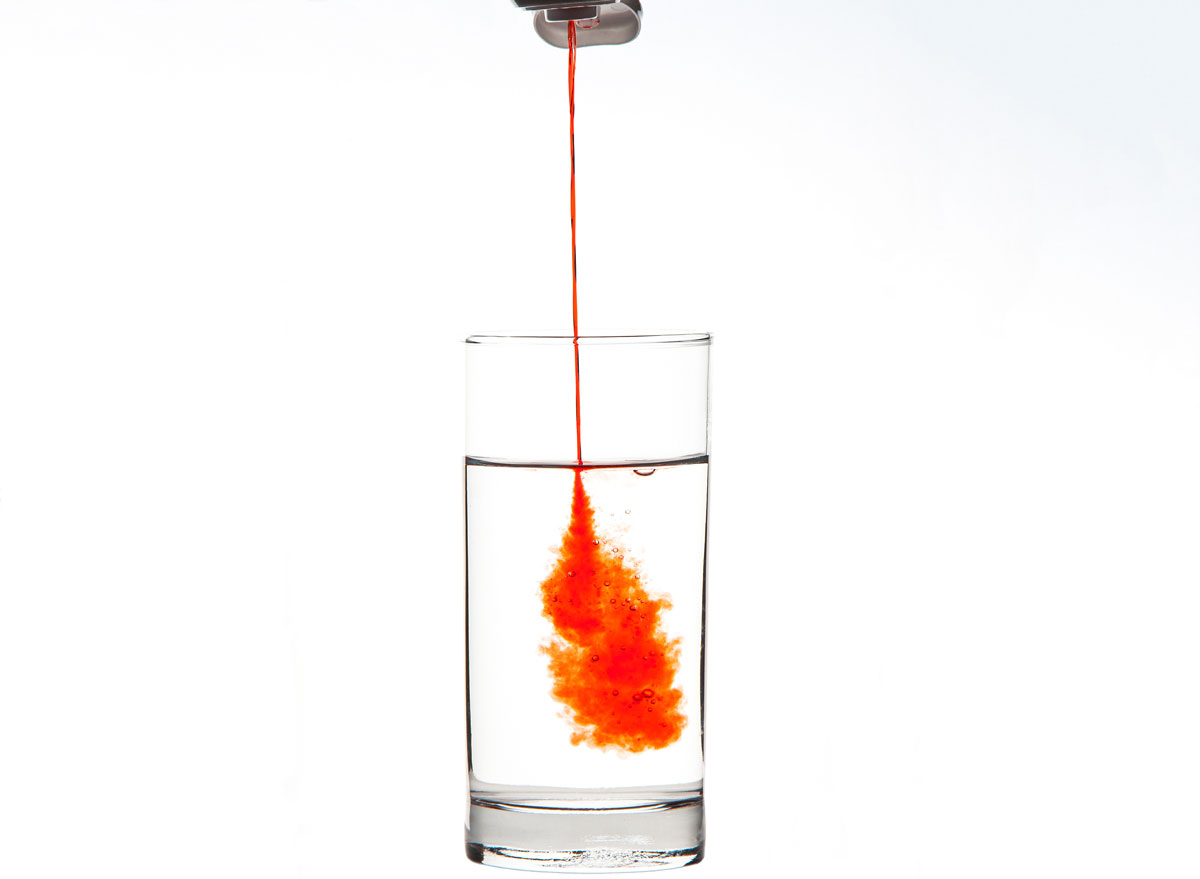
Unhealthy Ingredients: Sucralose, acesulfame potassium, propylene glycol, artificial colors
Looking to add a little zing to your drink? Don't reach for these manufactured water enhancers. Brands like Mio are made up almost entirely of artificial ingredients, but almost most alarming is Mio's use of artificial, non-nutritive sweeteners sucralose and acesulfame potassium, which a study published in Frontiers in Nutrition linked to weight gain and metabolic disorders. On top of that, Mio's Fruit Punch flavor gets its bright color from Red Dye 40.
Drink this instead: Throw a couple of fruit slices into your water for that extra zing of flavor you're looking for.
Frozen Fish Products
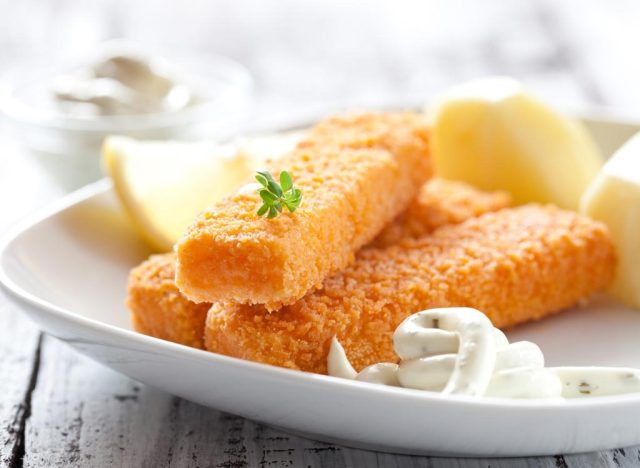
Unhealthy Ingredient: Sodium tripolyphosphate (STPP)
Something fishy is going down in the frozen food aisle. To help lower-quality fish retain moisture and to lessen the amount of water expelled during thawing, manufacturers soak fish in a bath of sodium tripolyphosphate (STPP)—as they do in Mrs. Paul's Beer Battered Fillets. STPP is a suspected neurotoxin and registered pesticide that the FDA considers "generally recognized as safe" to eat. However, adding STPP to fish can significantly increase the levels of sodium in the item—which can counteract the countless positive heart-health benefits of consuming fish in the first place. It can also increase your intake of dietary phosphates, which are connected to an increased risk of death from cardiovascular disease in patients with chronic kidney disease or prior heart problems.
Eat this instead: Europe, Canada, and other countries have limits on the total level of STPP allowed in seafood (0.1 to 0.5 percent), but the US has no such regulations. Companies aren't required to label this additive, but some packaged products do. When in doubt, stay dry. Seafood labeled as "dry" has not been treated with STPP; seafood marked as "wet" has been soaked in it. Or, to make it even simpler, try fresh fish whenever you are able.
Granola Bars
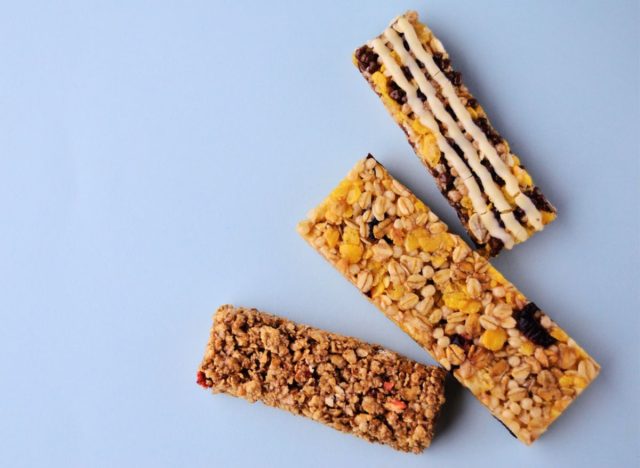
Unhealthy Ingredients: Sugar, corn syrup, sorbitol, soybean oil
Granola has long been associated with healthy living, although considering all the added sugar and additives that are put in certain granola bars, the link is a bit unclear sometimes. The combination of sugar, corn syrup, and sorbitol, a weight gain-inducing trifecta found in Quaker Chewy Chocolate Chip Granola Bars should be enough to have most health-conscious consumers steering clear, but the fact that these bars contain 7 grams of added sugar and only 1 gram of protein renders them almost completely pointless when it comes to nutritional value.
Eat this instead: "KIND Bars are made with wholesome ingredients like nuts and real chocolate, making for a satisfying snack that is loaded with nutrients," says Manaker. "The fiber and protein found in these bars will give them some serious staying power too." We also love that you can pick one of these up at Starbucks as a healthy snack alternative.
Meal Replacement Shakes
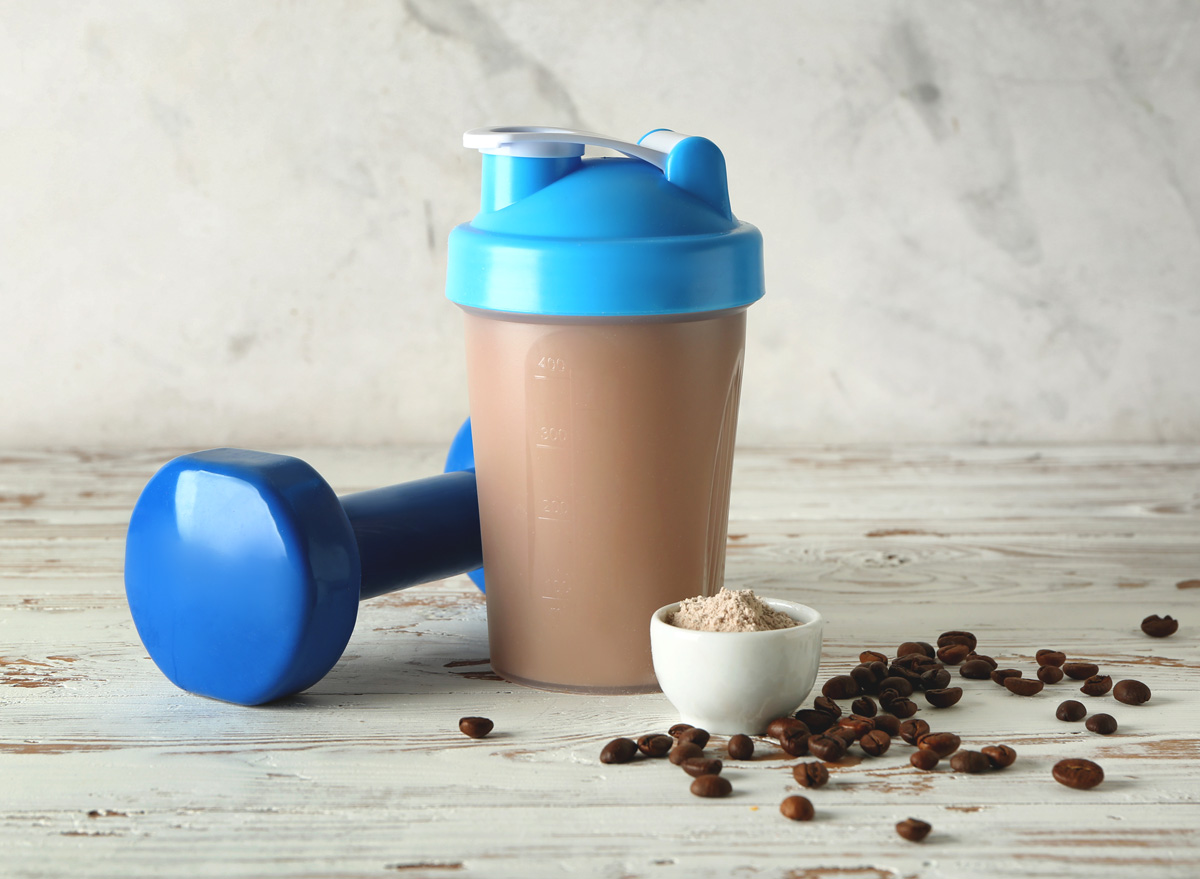
Unhealthy Ingredients: High fructose corn syrup, artificial flavors
Replacing your meal with a pre-packaged shake means you're replacing all the fiber, vitamins, and minerals you'd normally eat with some scary ingredients instead. From blood sugar-spiking high fructose corn syrup and maltodextrin, to artificial colors, these icky shakes are better off in the garbage than on your table. For example, you may want to steer clear of something like the SlimFast Original Shakes, which contain high fructose corn syrup, as well as a long list of additives and chemicals.
Drink this instead: Instead of those chalky, medicinal shakes that are high in sugar and low in any redeeming nutritional values, use one of these healthier protein powders to make your shake at home. "Be sure to watch the added sugary ingredients when you are whipping up your concoction," advises Manaker.
'Light' Butter Substitutes
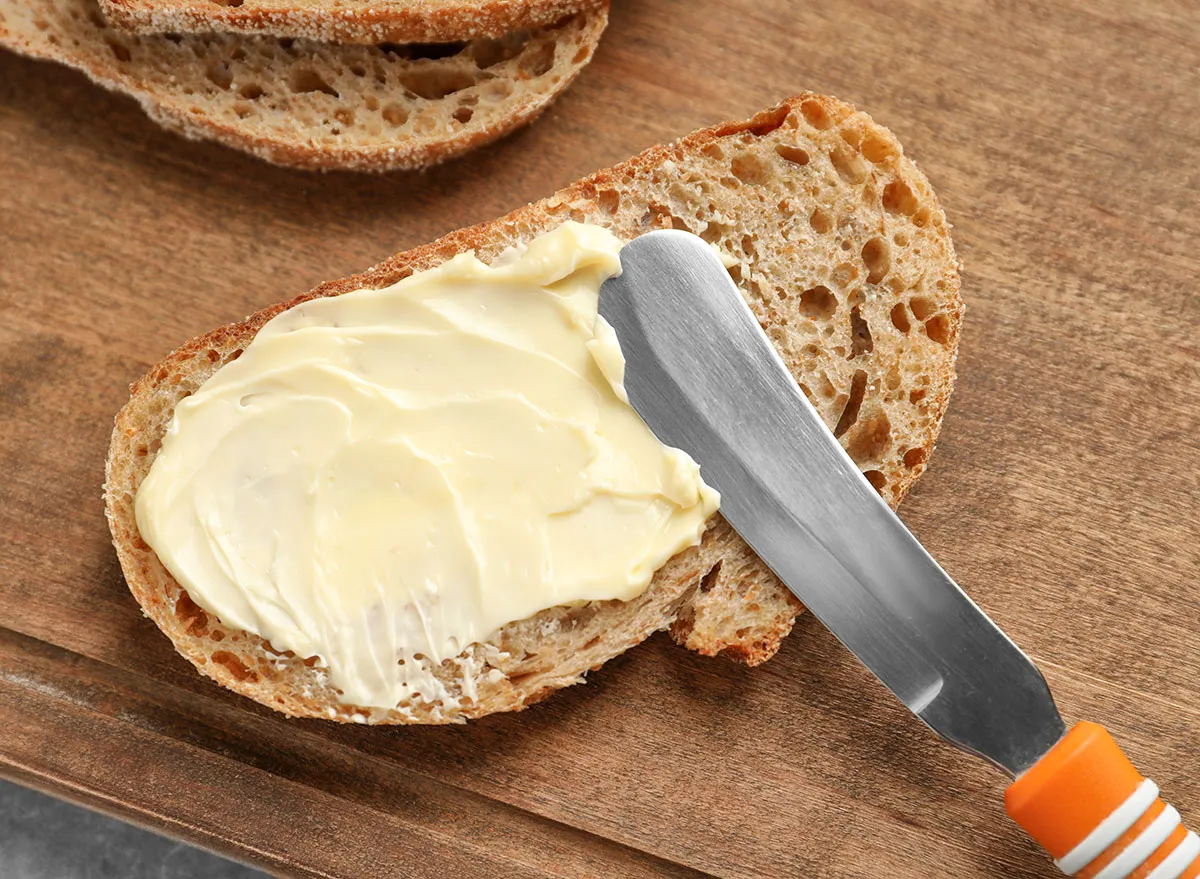
Unhealthy Ingredients: Soybean oil, palm oil, mono and diglycerides
When you pick up butter from the grocery store, it's usually a simple list of ingredients like cream, salt, and milk. However, if you opt for "light" versions of butter, you're most likely going to do more harm than if you were to stick to the regular version. A light option like Land O Lakes Light Butter with Canola Oil includes a long list of additives and chemicals, including mono and diglycerides—which are considered to be a class of trans fat.
Eat this instead: Choose healthier monounsaturated fats, such as olive oil, and increase your intake of foods that contain unsaturated omega-3 fatty acids, like chia seeds, flax seeds, and fish. And, for better butter options, try a high-quality brand like Vital Farms, "especially their spreadable butter which is made with avocado oil," shares Manaker.
Bottled Salad Dressing

Unhealthy Ingredients: High fructose corn syrup, soybean oil, added sugars
A hearty, nutrient-heavy salad can be a wonderful addition to your day, but some salad dressings can derail your health goals before you're even done eating. For starters, many store-bought salad dressings are high in sugar. Just two tablespoons of the Stonewall Balsamic Fig Dressing packs in 11 grams of sugar and 8 grams of added sugar. While some dressings go overboard with sugar, other dressings—like Marie's Creamy Italian Garlic—pack in the fat. This creamy dressing will serve up 19 grams of fat in just two tablespoons. Even worse is that's mostly from inflammatory soybean oil, which animal studies show can increase appetite.
Eat this instead: Olive oil, balsamic vinegar, lemon juice, honey, mustard—these are just some of the whole ingredients you can use to concoct your own salad dressing in your kitchen that will be far less likely to do you harm. And if you want to buy a healthier option at the store, try one of these 10 Healthiest Salad Dressing Brands.
Fruit Cocktail
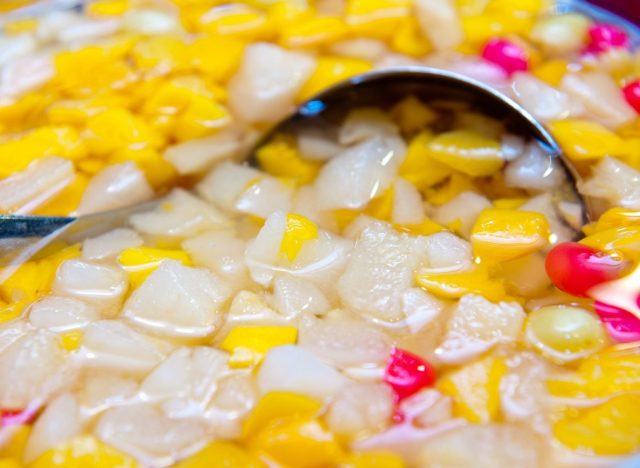
Unhealthy Ingredients: Added sugar
Just because it's not full of alcohol doesn't mean that a fruit cocktail is any healthier than an oversized margarita. In fact, with the added sugar on top of the natural sugars found in these fiber-less cans of fruit, it may be worse.
Eat this instead: Eat whole fruit that's fresh or frozen whenever you can. You'll get the full nutrient profile with all of the fiber and antioxidants intact, without added sugar to worry about. "If you do go for canned fruit, be sure that it is canned in natural juices and not heavy syrup," says Manaker.
Certain Protein Bars
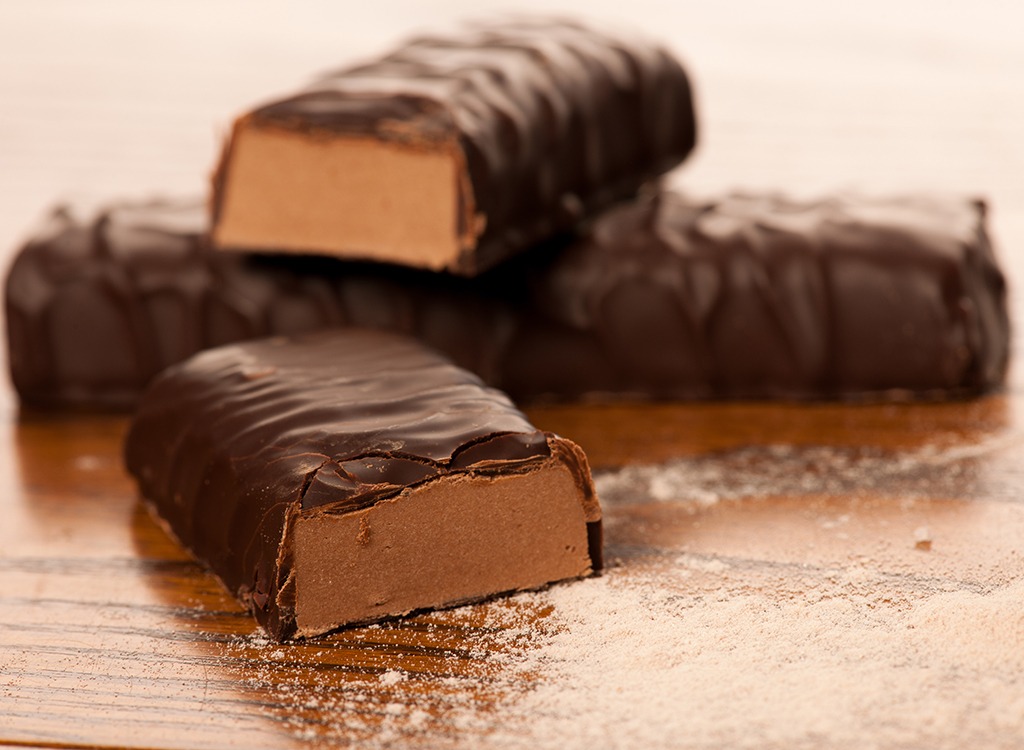
Unhealthy Ingredients: Sugar, artificial sweeteners, caramel color, polysorbate 60
The combination of sugar, carcinogenic colors, and polysorbate 60, an emulsifier that can create potentially toxic compounds when combined with other ingredients, makes most protein bars less of a healthy snack and more health hazard. Many of these bars are also loaded with added sugars, so even though they may increase your protein intake, you'll also be consuming too much sugar. As an example, the Gatorade Recover Peanut Butter Whey Protein Bar has 24 grams of added sugar, which is exactly how much a woman is recommended to consume in an entire day.
Eat this instead: Loading up on protein doesn't have to mean loading up on sugar and preservatives, too. A handful of raw almonds, a piece of cheese, or a hard-boiled egg can all help improve your post-workout recovery without weighing you down. Or, you can try one of these healthier, low-sugar protein bars.
Sugar-Free Jam
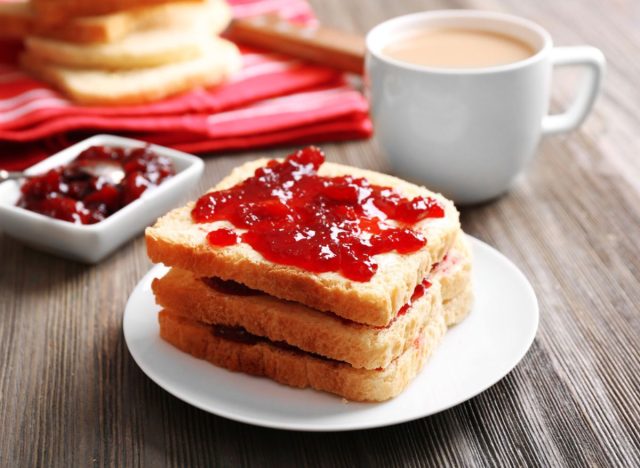
Unhealthy Ingredients: Artificial sweeteners
Although it could help regulate your blood sugar, Polaner's Sugar-Free Jam shouldn't be your go-to source for fiber. It's sweetened with the artificial sweetener sucralose, which a 2020 study published in Nutrition Journal found to potentially impact insulin resistance in "healthy" adults.
Eat this instead: Your safest bet is to top your peanut butter sandwiches with fresh pieces of fruit like bananas and strawberries. You'll get a similar taste with none of the artificial sweeteners.
- Source: Potera C. The artificial food dye blues. Environ Health Perspect. 2010 Oct;118(10):A428. doi: 10.1289/ehp.118-a428. PMID: 20884387; PMCID: PMC2957945.
- Source: Nutrition, C. F. F. S. a. A. (2024c, March 5). Sodium in your diet. U.S. Food And Drug Administration. https://www.fda.gov/food/nutrition-education-resources-materials/sodium-your-diet
- Source: Ritz E, Hahn K, Ketteler M, Kuhlmann MK, Mann J. Phosphate additives in food--a health risk. Dtsch Arztebl Int. 2012 Jan;109(4):49-55. doi: 10.3238/arztebl.2012.0049. Epub 2012 Jan 27. PMID: 22334826; PMCID: PMC3278747.
- Source: Sodium and health. (2023c, June 6). Centers for Disease Control and Prevention. https://www.cdc.gov/salt/index.htm#:~:text=Eating%20too%20much%20sodium%20can,the%20health%20of%20your%20heart.
- Source: Carbohydrates and blood sugar. (2016, July 25). The Nutrition Source. https://www.hsph.harvard.edu/nutritionsource/carbohydrates/carbohydrates-and-blood-sugar/
- Source: Fuhrman J. The Hidden Dangers of Fast and Processed Food. Am J Lifestyle Med. 2018 Apr 3;12(5):375-381. doi: 10.1177/1559827618766483. PMID: 30283262; PMCID: PMC6146358.
- Source: Bahadoran Z, Mirmiran P, Azizi F. Fast Food Pattern and Cardiometabolic Disorders: A Review of Current Studies. Health Promot Perspect. 2016 Jan 30;5(4):231-40. doi: 10.15171/hpp.2015.028. PMID: 26933642; PMCID: PMC4772793.
- Source: Sugary drinks. (2023, August 21). The Nutrition Source. https://www.hsph.harvard.edu/nutritionsource/healthy-drinks/sugary-drinks/
- Source: Kobylewski S, Jacobson MF. Toxicology of food dyes. Int J Occup Environ Health. 2012 Jul-Sep;18(3):220-46. doi: 10.1179/1077352512Z.00000000034. PMID: 23026007.
- Source: Andújar I, Recio MC, Giner RM, Ríos JL. Cocoa polyphenols and their potential benefits for human health. Oxid Med Cell Longev. 2012;2012:906252. doi: 10.1155/2012/906252. Epub 2012 Oct 24. PMID: 23150750; PMCID: PMC3488419.
- Source: https://www.ewg.org/foodscores/ingredients/7347-SodiumPhosphates/
- Source: Shakil MH, Trisha AT, Rahman M, Talukdar S, Kobun R, Huda N, Zzaman W. Nitrites in Cured Meats, Health Risk Issues, Alternatives to Nitrites: A Review. Foods. 2022 Oct 25;11(21):3355. doi: 10.3390/foods11213355. PMID: 36359973; PMCID: PMC9654915.
- Source: Ismail SR, Maarof SK, Siedar Ali S, Ali A. Systematic review of palm oil consumption and the risk of cardiovascular disease. PLoS One. 2018 Feb 28;13(2):e0193533. doi: 10.1371/journal.pone.0193533. PMID: 29489910; PMCID: PMC5831100.
- Source: Nigg JT, Lewis K, Edinger T, Falk M. Meta-analysis of attention-deficit/hyperactivity disorder or attention-deficit/hyperactivity disorder symptoms, restriction diet, and synthetic food color additives. J Am Acad Child Adolesc Psychiatry. 2012 Jan;51(1):86-97.e8. doi: 10.1016/j.jaac.2011.10.015. PMID: 22176942; PMCID: PMC4321798.
- Source: Castaldo L, Narváez A, Izzo L, Graziani G, Gaspari A, Minno GD, Ritieni A. Red Wine Consumption and Cardiovascular Health. Molecules. 2019 Oct 8;24(19):3626. doi: 10.3390/molecules24193626. PMID: 31597344; PMCID: PMC6804046.
- Source: Alcohol: Balancing Risks and benefits. (2022, April 4). The Nutrition Source. https://www.hsph.harvard.edu/nutritionsource/healthy-drinks/drinks-to-consume-in-moderation/alcohol-full-story/#Dark_side_alcohol
- Source: https://www.cdc.gov/alcohol/about-alcohol-use/index.html
- Source: Ritz E, Hahn K, Ketteler M, Kuhlmann MK, Mann J. Phosphate additives in food--a health risk. Dtsch Arztebl Int. 2012 Jan;109(4):49-55. doi: 10.3238/arztebl.2012.0049. Epub 2012 Jan 27. PMID: 22334826; PMCID: PMC3278747.
- Source: E Chazelas, F Pierre, N Druesne-Pecollo, S Gigandet, B Srour, I Huybrechts, C Julia, E Kesse-Guyot, M Deschasaux-Tanguy, M Touvier, Nitrites and nitrates from food additives and cancer risk: results from the NutriNet-Santé cohort, European Journal of Public Health, Volume 31, Issue Supplement_3, October 2021, ckab165.244, https://doi.org/10.1093/eurpub/ckab165.244
- Source: Bouvard, V., Loomis, D., Guyton, K. Z., Grosse, Y., Ghissassi, F. E., Benbrahim‐Tallaa, L., Guha, N., Mattock, H., & Straif, K. (2015). Carcinogenicity of consumption of red and processed meat. The Lancet Oncology, 16(16), 1599–1600. https://doi.org/10.1016/s1470-2045(15)00444-1
- Source: How much sugar is too much? (2023e, May 10). www.heart.org. https://www.heart.org/en/healthy-living/healthy-eating/eat-smart/sugar/how-much-sugar-is-too-much#:~:text=AHA%20Sugar%20Recommendation&text=Men%20should%20consume%20no%20more,32%20grams)%20of%20added%20sugar!
- Source: Rippe JM, Angelopoulos TJ. Relationship between Added Sugars Consumption and Chronic Disease Risk Factors: Current Understanding. Nutrients. 2016 Nov 4;8(11):697. doi: 10.3390/nu8110697. PMID: 27827899; PMCID: PMC5133084.
- Source: Chiu S, Williams PT, Krauss RM. Effects of a very high saturated fat diet on LDL particles in adults with atherogenic dyslipidemia: A randomized controlled trial. PLoS One. 2017 Feb 6;12(2):e0170664. doi: 10.1371/journal.pone.0170664. PMID: 28166253; PMCID: PMC5293238.
- Source: Ferrer-Cascales R, Sánchez-SanSegundo M, Ruiz-Robledillo N, Albaladejo-Blázquez N, Laguna-Pérez A, Zaragoza-Martí A. Eat or Skip Breakfast? The Important Role of Breakfast Quality for Health-Related Quality of Life, Stress and Depression in Spanish Adolescents. Int J Environ Res Public Health. 2018 Aug 19;15(8):1781. doi: 10.3390/ijerph15081781. PMID: 30126240; PMCID: PMC6121474.
- Source: Facts about trans fats: MedlinePlus Medical Encyclopedia. (n.d.). https://medlineplus.gov/ency/patientinstructions/000786.htm
- Source: Azodicarbonamide. (2022, June 24). Center for Science in the Public Interest. https://www.cspinet.org/article/azodicarbonamide
- Source: Stanhope, K. L., Schwarz, J. M., Keim, N. L., Griffen, S. C., Bremer, A. A., Graham, J. L., Hatcher, B., Cox, C. A., Dyachenko, A., Zhang, W., McGahan, J. P., Seibert, A., Krauss, R. M., Chiu, S., Schaefer, E. J., Ai, M., Otokozawa, S., Nakajima, K., Nakano, T., . . . Havel, P. J. (2009). Consuming fructose-sweetened, not glucose-sweetened, beverages increases visceral adiposity and lipids and decreases insulin sensitivity in overweight/obese humans. Journal of Clinical Investigation, 119(5), 1322–1334. https://doi.org/10.1172/jci37385
- Source: Jennifer L. Kuk and Ruth E. Brown. 2016. Aspartame intake is associated with greater glucose intolerance in individuals with obesity. Applied Physiology, Nutrition, and Metabolism. 41(7): 795-798. https://doi.org/10.1139/apnm-2015-0675
- Source: Debras, C., Chazelas, E., Srour, B., Druesne-Pecollo, N., Esseddik, Y., De Edelenyi, F. S., Agaësse, C., De, A., Lutchia, R., Gigandet, S., Huybrechts, I., Julia, C., Kesse‐Guyot, E., Allès, B., Andreeva, V. A., Galán, P., Herçberg, S., Deschasaux, M., & Touvier, M. (2022). Artificial sweeteners and cancer risk: Results from the NutriNet-Santé population-based cohort study. PLOS Medicine, 19(3), e1003950. https://doi.org/10.1371/journal.pmed.1003950
- Source: Uribarri J, del Castillo MD, de la Maza MP, Filip R, Gugliucci A, Luevano-Contreras C, Macías-Cervantes MH, Markowicz Bastos DH, Medrano A, Menini T, Portero-Otin M, Rojas A, Sampaio GR, Wrobel K, Wrobel K, Garay-Sevilla ME. Dietary advanced glycation end products and their role in health and disease. Adv Nutr. 2015 Jul 15;6(4):461-73. doi: 10.3945/an.115.008433. PMID: 26178030; PMCID: PMC4496742.
- Source: Crowe, W., Pan, X., Mackle, J. et al. Dietary inclusion of nitrite-containing frankfurter exacerbates colorectal cancer pathology and alters metabolism in APCmin mice. npj Sci Food 6, 60 (2022). https://doi.org/10.1038/s41538-022-00174-y
- Source: Honikel, K. O. (2008). The use and control of nitrate and nitrite for the processing of meat products. Meat Science, 78(1–2), 68–76. https://doi.org/10.1016/j.meatsci.2007.05.030
- Source: Cantwell M, Elliott C (2017) Nitrates, Nitrites and Nitrosamines from Processed Meat Intake and Colorectal Cancer Risk. J Clin Nutr Diet 3:27. doi: 10.4172/2472-1921.100062
- Source: Nutrition, C. F. F. S. a. A. (2022, February 25). Sodium in your diet. U.S. Food And Drug Administration. https://www.fda.gov/food/nutrition-education-resources-materials/sodium-your-diet
- Source: How much sugar is too much? (2023, May 10). www.heart.org. https://www.heart.org/en/healthy-living/healthy-eating/eat-smart/sugar/how-much-sugar-is-too-much
- Source: Nutrition, C. F. F. S. a. A. (2023, September 27). Added sugars on the Nutrition Facts label. U.S. Food And Drug Administration. https://www.fda.gov/food/nutrition-facts-label/added-sugars-nutrition-facts-label
- Source: Added sugars. (2023, May 10). www.heart.org. https://www.heart.org/en/healthy-living/healthy-eating/eat-smart/sugar/added-sugars
- Source: Harvard Health. (2022, January 6). The sweet danger of sugar. https://www.health.harvard.edu/heart-health/the-sweet-danger-of-sugar
- Source: Kelly, R.K., Tong, T.Y.N., Watling, C.Z. et al. Associations between types and sources of dietary carbohydrates and cardiovascular disease risk: a prospective cohort study of UK Biobank participants. BMC Med 21, 34 (2023). https://doi.org/10.1186/s12916-022-02712-7
- Source: Faruque S, Tong J, Lacmanovic V, Agbonghae C, Minaya DM, Czaja K. The Dose Makes the Poison: Sugar and Obesity in the United States - a Review. Pol J Food Nutr Sci. 2019;69(3):219-233. doi: 10.31883/pjfns/110735. PMID: 31938015; PMCID: PMC6959843.
- Source: How high fructose intake may trigger fatty liver disease. (2020, September 22). National Institutes of Health (NIH). https://www.nih.gov/news-events/nih-research-matters/how-high-fructose-intake-may-trigger-fatty-liver-disease
- Source: Caramel coloring. (2022, February 8). Center for Science in the Public Interest. https://www.cspinet.org/article/caramel-coloring
- Source: Nagao M, Tsugane S. Cancer in Japan: Prevalence, prevention and the role of heterocyclic amines in human carcinogenesis. Genes Environ. 2016 Jul 1;38:16. doi: 10.1186/s41021-016-0043-y. PMID: 27375796; PMCID: PMC4929724.
- Source: Beteta-Göbel R, Miralles M, Fernández-Díaz J, Rodríguez-Lorca R, Torres M, Fernández-García P, Escribá PV, Lladó V. HCA (2-Hydroxy-Docosahexaenoic Acid) Induces Apoptosis and Endoplasmic Reticulum Stress in Pancreatic Cancer Cells. International Journal of Molecular Sciences. 2022; 23(17):9902. https://doi.org/10.3390/ijms23179902
- Source: Arria, A. M., Caldeira, K. M., Bugbee, B. A., Vincent, K. B., & O’Grady, K. E. (2017). Trajectories of energy drink consumption and subsequent drug use during young adulthood. Drug and Alcohol Dependence, 179, 424–432. https://doi.org/10.1016/j.drugalcdep.2017.06.008
- Source: Harb JN, Taylor ZA, Khullar V, et al Rare cause of acute hepatitis: a common energy drink Case Reports 2016;2016:bcr2016216612.
- Source: Pandey H, Kumar S. Butylated hydroxytoluene and Butylated hydroxyanisole induced cyto-genotoxicity in root cells of Allium cepa L. Heliyon. 2021 May 18;7(5):e07055. doi: 10.1016/j.heliyon.2021.e07055. PMID: 34041400; PMCID: PMC8141894.
- Source: Azad, M. B., Abou‐Setta, A. M., Chauhan, B. F., Rabbani, R., Lys, J., Copstein, L., Mann, A. S., Jeyaraman, M. M., Reid, A., Fiander, M., MacKay, D., McGavock, J., Wicklow, B., & Zarychanski, R. (2017). Nonnutritive sweeteners and cardiometabolic health: a systematic review and meta-analysis of randomized controlled trials and prospective cohort studies. Canadian Medical Association Journal, 189(28), E929–E939. https://doi.org/10.1503/cmaj.161390
- Source: Wang, Q., Lin, Y., Zhang, L., Wilson, Y. A., Oyston, L. J., Cotterell, J., Qi, Y., Khuong, T. M., Bakhshi, N., Planchenault, Y., Browman, D., Lau, M. T., Cole, T., Wong, A. C. N., Simpson, S. J., Cole, A. R., Penninger, J., & Herzog, H. (2016). Sucralose Promotes Food Intake through NPY and a Neuronal Fasting Response. Cell Metabolism, 24(1), 75–90. https://doi.org/10.1016/j.cmet.2016.06.010
- Source: Del Pozo S, Gómez-Martínez S, Díaz LE, Nova E, Urrialde R, Marcos A. Potential Effects of Sucralose and Saccharin on Gut Microbiota: A Review. Nutrients. 2022 Apr 18;14(8):1682. doi: 10.3390/nu14081682. PMID: 35458244; PMCID: PMC9029443.
- Source: Tsai MJ, Li CH, Wu HT, Kuo HY, Wang CT, Pai HL, Chang CJ, Ou HY. Long-Term Consumption of Sucralose Induces Hepatic Insulin Resistance through an Extracellular Signal-Regulated Kinase 1/2-Dependent Pathway. Nutrients. 2023 Jun 20;15(12):2814. doi: 10.3390/nu15122814. PMID: 37375718; PMCID: PMC10305118.
- Source: Nutrition, C. F. F. S. a. A. (2018, May 18). Final determination regarding partially hydrogenated oils (Removing trans fat). U.S. Food And Drug Administration. https://www.fda.gov/food/food-additives-petitions/final-determination-regarding-partially-hydrogenated-oils-removing-trans-fat
- Source: Malik VS, Hu FB. Fructose and Cardiometabolic Health: What the Evidence From Sugar-Sweetened Beverages Tells Us. J Am Coll Cardiol. 2015 Oct 6;66(14):1615-1624. doi: 10.1016/j.jacc.2015.08.025. PMID: 26429086; PMCID: PMC4592517.
- Source: Kwon, Y.H., Banskota, S., Wang, H. et al. Chronic exposure to synthetic food colorant Allura Red AC promotes susceptibility to experimental colitis via intestinal serotonin in mice. Nat Commun 13, 7617 (2022). https://doi.org/10.1038/s41467-022-35309-y
- Source: Saturated fat. (2023, May 10). www.heart.org. https://www.heart.org/en/healthy-living/healthy-eating/eat-smart/fats/saturated-fats
- Source: Ismail SR, Maarof SK, Siedar Ali S, Ali A. Systematic review of palm oil consumption and the risk of cardiovascular disease. PLoS One. 2018 Feb 28;13(2):e0193533. doi: 10.1371/journal.pone.0193533. PMID: 29489910; PMCID: PMC5831100.
- Source: FoodData Central. (n.d.). https://fdc.nal.usda.gov/fdc-app.html#/food-details/171413/nutrients
- Source: Nutrition: Trans fat. (n.d.). https://www.who.int/news-room/questions-and-answers/item/nutrition-trans-fat
- Source: Deol, P., Fahrmann, J., Yang, J. et al. Omega-6 and omega-3 oxylipins are implicated in soybean oil-induced obesity in mice. Sci Rep 7, 12488 (2017). https://doi.org/10.1038/s41598-017-12624-9
- Source: Poonamjot Deol, Elena Kozlova, Matthew Valdez, Catherine Ho, Ei-Wen Yang, Holly Richardson, Gwendolyn Gonzalez, Edward Truong, Jack Reid, Joseph Valdez, Jonathan R Deans, Jose Martinez-Lomeli, Jane R Evans, Tao Jiang, Frances M Sladek, Margarita C Curras-Collazo, Dysregulation of Hypothalamic Gene Expression and the Oxytocinergic System by Soybean Oil Diets in Male Mice, Endocrinology, Volume 161, Issue 2, February 2020, bqz044, https://doi.org/10.1210/endocr/bqz044
- Source: Bolhuis, D. P., Costanzo, A., Newman, L. P., & Keast, R. (2016). Salt promotes passive overconsumption of dietary fat in humans. The Journal of Nutrition, 146(4), 838–845. https://doi.org/10.3945/jn.115.226365
- Source: May CY, Nesaretnam K. Research advancements in palm oil nutrition. Eur J Lipid Sci Technol. 2014 Oct;116(10):1301-1315. doi: 10.1002/ejlt.201400076. Epub 2014 Oct 6. PMID: 25821404; PMCID: PMC4371640.
- Source: Caramel coloring. (2022b, February 8). Center for Science in the Public Interest. https://www.cspinet.org/article/caramel-coloring
- Source: Sodium and health. (2023d, June 6). Centers for Disease Control and Prevention. https://www.cdc.gov/salt/index.htm#:~:text=Eating%20too%20much%20sodium%20can,year%20than%20any%20other%20cause.
- Source: Miyamoto JÉ, Ferraz ACG, Portovedo M, Reginato A, Stahl MA, Ignacio-Souza LM, Chan KL, Torsoni AS, Torsoni MA, Ribeiro APB, Milanski M. Interesterified soybean oil promotes weight gain, impaired glucose tolerance and increased liver cellular stress markers. J Nutr Biochem. 2018 Sep;59:153-159. doi: 10.1016/j.jnutbio.2018.05.014. Epub 2018 Jun 5. PMID: 30005920.
- Source: Crowe, W., Pan, X., Mackle, J. et al. Dietary inclusion of nitrite-containing frankfurter exacerbates colorectal cancer pathology and alters metabolism in APCmin mice. npj Sci Food 6, 60 (2022). https://doi.org/10.1038/s41538-022-00174-y
- Source: Ritz E, Hahn K, Ketteler M, Kuhlmann MK, Mann J. Phosphate additives in food--a health risk. Dtsch Arztebl Int. 2012 Jan;109(4):49-55. doi: 10.3238/arztebl.2012.0049. Epub 2012 Jan 27. PMID: 22334826; PMCID: PMC3278747.
- Source: Park W, Kim BS, Lee JE, Huh JK, Kim BJ, Sung KC, Kang JH, Lee MH, Park JR, Rhee EJ, Oh KW, Lee WY, Park CY, Park SW, Kim SW. Serum phosphate levels and the risk of cardiovascular disease and metabolic syndrome: a double-edged sword. Diabetes Res Clin Pract. 2009 Jan;83(1):119-25. doi: 10.1016/j.diabres.2008.08.018. Epub 2008 Dec 20. PMID: 19101054.
- Source: Chang AR, Anderson C. Dietary Phosphorus Intake and the Kidney. Annu Rev Nutr. 2017 Aug 21;37:321-346. doi: 10.1146/annurev-nutr-071816-064607. Epub 2017 Jun 14. PMID: 28613982; PMCID: PMC5686387.
- Source: American Heart Association; https://www.heart.org/-/media/files/health-topics/answers-by-heart/why-should-i-limit-sodium.pdf
- Source: Park W, Kim BS, Lee JE, Huh JK, Kim BJ, Sung KC, Kang JH, Lee MH, Park JR, Rhee EJ, Oh KW, Lee WY, Park CY, Park SW, Kim SW. Serum phosphate levels and the risk of cardiovascular disease and metabolic syndrome: a double-edged sword. Diabetes Res Clin Pract. 2009 Jan;83(1):119-25. doi: 10.1016/j.diabres.2008.08.018. Epub 2008 Dec 20. PMID: 19101054.
- Source: Qian F, Riddle MC, Wylie-Rosett J, Hu FB. Red and Processed Meats and Health Risks: How Strong Is the Evidence? Diabetes Care. 2020 Feb;43(2):265-271. doi: 10.2337/dci19-0063. PMID: 31959642; PMCID: PMC6971786.
- Source: American Institute for Cancer Research. (2021, January 26). Limit consumption of red and processed meat. https://www.aicr.org/cancer-prevention/recommendations/limit-consumption-of-red-and-processed-meat/
- Source: Miller, M.D., Steinmaus, C., Golub, M.S. et al. Potential impacts of synthetic food dyes on activity and attention in children: a review of the human and animal evidence. Environ Health 21, 45 (2022). https://doi.org/10.1186/s12940-022-00849-9
- Source: Potassium bromate. (2015, October 14). Environmental Working Group. https://www.ewg.org/research/potassium-bromate
- Source: Consumer group calls for ban on “Flour improver” potassium bromate termed a cancer threat. (2022, February 3). Center for Science in the Public Interest. https://www.cspinet.org/new/bromate.html
- Source: Matuszczak E, Komarowska MD, Debek W, Hermanowicz A. The Impact of Bisphenol A on Fertility, Reproductive System, and Development: A Review of the Literature. Int J Endocrinol. 2019 Apr 10;2019:4068717. doi: 10.1155/2019/4068717. PMID: 31093279; PMCID: PMC6481157.
- Source: Vally H, Misso NL. Adverse reactions to the sulphite additives. Gastroenterol Hepatol Bed Bench. 2012 Winter;5(1):16-23. PMID: 24834193; PMCID: PMC4017440.
- Source: Vorland CJ, Stremke ER, Moorthi RN, Hill Gallant KM. Effects of Excessive Dietary Phosphorus Intake on Bone Health. Curr Osteoporos Rep. 2017 Oct;15(5):473-482. doi: 10.1007/s11914-017-0398-4. PMID: 28840444; PMCID: PMC5693714.
- Source: CDC TOXICOLOGICAL PROFILE FOR 1,4-DIOXANE
- Source: Raposa, B., Pónusz, R., Gerencsér, G., Budán, F., Gyöngyi, Z., Tibold, A., Hegyi, D., Kiss, I., Koller, Á., & Varjas, T. (2016). Food additives: Sodium benzoate, potassium sorbate, azorubine, and tartrazine modify the expression of NFκB, GADD45α, and MAPK8 genes. Physiology International (Acta Physiologica Hungarica) APhys, 103(3), 334-343. https://doi.org/10.1556/2060.103.2016.3.6
- Source: Born P. Carbohydrate malabsorption in patients with non-specific abdominal complaints. World J Gastroenterol. 2007 Nov 21;13(43):5687-91. doi: 10.3748/wjg.v13.i43.5687. PMID: 17963293; PMCID: PMC4171253.
- Source: Wang, Q., Lin, Y., Zhang, L., Wilson, Y. A., Oyston, L. J., Cotterell, J., Qi, Y., Khuong, T. M., Bakhshi, N., Planchenault, Y., Browman, D., Lau, M. T., Cole, T., Wong, A. C. N., Simpson, S. J., Cole, A. R., Penninger, J., & Herzog, H. (2016). Sucralose Promotes Food Intake through NPY and a Neuronal Fasting Response. Cell Metabolism, 24(1), 75–90. https://doi.org/10.1016/j.cmet.2016.06.010
- Source: Added sugar. (2023, February 2). The Nutrition Source. https://www.hsph.harvard.edu/nutritionsource/carbohydrates/added-sugar-in-the-diet/
- Source: Guo, Y., Lee, H., & Jeong, H. (2020). Gut microbiota in reductive drug metabolism. In Progress in Molecular Biology and Translational Science (pp. 61–93). https://doi.org/10.1016/bs.pmbts.2020.04.002
- Source: Mongioì LM, La Vignera S, Cannarella R, Cimino L, Compagnone M, Condorelli RA, Calogero AE. The Role of Resveratrol Administration in Human Obesity. Int J Mol Sci. 2021 Apr 22;22(9):4362. doi: 10.3390/ijms22094362. PMID: 33921991; PMCID: PMC8122246.
- Source: Sawda C, Moussa C, Turner RS. Resveratrol for Alzheimer's disease. Ann N Y Acad Sci. 2017 Sep;1403(1):142-149. doi: 10.1111/nyas.13431. Epub 2017 Aug 16. PMID: 28815614; PMCID: PMC5664214.
- Source: Pang MD, Goossens GH, Blaak EE. The Impact of Artificial Sweeteners on Body Weight Control and Glucose Homeostasis. Front Nutr. 2021 Jan 7;7:598340. doi: 10.3389/fnut.2020.598340. PMID: 33490098; PMCID: PMC7817779.
- Source: CFR - Code of Federal Regulations Title 21. (n.d.). https://www.accessdata.fda.gov/scripts/cdrh/cfdocs/cfcfr/cfrsearch.cfm?fr=182.1810
- Source: Office of Dietary Supplements - Phosphorus. (n.d.). https://ods.od.nih.gov/factsheets/Phosphorus-HealthProfessional/
- Source: Deol P, Evans JR, Dhahbi J, Chellappa K, Han DS, Spindler S, Sladek FM. Soybean Oil Is More Obesogenic and Diabetogenic than Coconut Oil and Fructose in Mouse: Potential Role for the Liver. PLoS One. 2015 Jul 22;10(7):e0132672. doi: 10.1371/journal.pone.0132672. PMID: 26200659; PMCID: PMC4511588.
- Source: Bueno-Hernández, N., Esquivel-Velázquez, M., Alcántara-Suárez, R. et al. Chronic sucralose consumption induces elevation of serum insulin in young healthy adults: a randomized, double blind, controlled trial. Nutr J 19, 32 (2020). https://doi.org/10.1186/s12937-020-00549-5









